

How to choose the best DMZ Tour (2024 edition)
By: Author Sylvia
Posted on Last updated: January 22, 2024
Are you wondering what’s the best DMZ tour?
When we visited Korea for the first time, we absolutely wanted to visit the DMZ.
We did tremendous research about the best way to visit the DMZ and the best DMZ tour.
What we didn’t know at that time was that the inter-Korean summit would sabotage our plans.
Our DMZ tour was canceled because of the meeting between the North Korean leader Kim Jong-un and South Korea’s President Moon Jae-in.
Covid-19 threw a wrench in the works of our second trip to Korea, but in 2023, the moment finally arrived! We could again travel to Korea, and this time our visit to the DMZ, became a reality. Hooray!
The visit to the DMZ is slightly different after Covid than it used to be. We share all the latest details.
Here’s everything we learned from our extensive research and from our visit in 2023.
There is a really good chance that this post contains affiliate links. If you click one of them, we may receive a small commission (for which we are deeply grateful) at no extra cost to you.
In a hurry? Here you will find the most important information about the DMZ
The DMZ is an interesting place to visit and a perfect way to learn more about Korean history and the current situation of separation between North and South Korea.
- The cheapest way to visit the DMZ is with the DMZ peace train . (The train has stopped running due to COVID-19 and service has not yet resumed at this time. )
DMZ half or full-day trip
- DMZ half or full-day trip ( is slightly cheaper than the one above, but at the moment only runs on Saturday or Sunday )
- DMZ Tour with Optional North Korean Defector
- If you are traveling with a larger family or a group, you could consider a private tour with a guide
- After 2 years of being closed, the JSA is finally reopening. Note that JSA Tours are very popular and are quickly booked up. If you want to visit the JSA you should book your tour as soon as your travel plans are fixed. Read on to learn the difference between the DMZ and the JSA .
Table of Contents
What’s the DMZ
In order to completely understand what the DMZ is all about we will start with some history.
The complete Korean peninsula on which both North and South Korea are currently located was annexed by Japan in 1910. The Japanese treated Korea as a colony. The interests of the Koreans were completely subordinate to the interests of Japan.
Japan was defeated by the Allies at the end of the second world war in 1945. At that time the Soviet Union had occupied the Northern part of Korea and the United States took control of the Southern part of the Peninsula.
7 days in Korea, the perfect itinerary.
The intention of the two superpowers was to create a temporary separation between the 2 parts. Plans existed to create a united and independent Korea in 5 years but things turned out differently.
The Cold War ensured that there was no agreement to hold elections for the whole of Korea.
The differences in politics drove the 2 parts further apart instead of coming to each other.
In 1948 the independent Republic of Korea was established in the American zone. In the same year, the Communist Democratic Korean People’s Republic (North Korea) was founded in the north.
Two years later the Northern army invaded the South with the aim of uniting the two Koreas into one communist state. This was the start of a 3-year-long civil war that claimed more than 2 million victims.
Initially, the Northern army succeeded in overrunning 90% of the South but they were fought back by US-led reinforcements sent by the UN.
In their turn, they crossed the border and made plans to conquer the whole North, against the will of China that launched a counter-attack.

It took until July 27, 1953, before the Armistice Agreement was signed.
The two parties took long to negotiate where the new border should be but in the end, it was decided that the border remained more or less where it had been all the time.
The new border diagonally crosses the 38th latitude and was widened with the creation of a four-kilometer-wide weapons-free buffer zone between the states, known as the DMZ.
The war left its traces and further perpetuated the division of Korea leading to a permanent alliance between South Korea and the United States and the establishment of a US base in South Korea.
There has been a truce since then but o fficially the 2 countries are still at war with each other. We read about how you can literally feel the tension at the border where the armies of both countries are facing each other.
In other parts of South Korea, such as Busan , you do not notice much of the war except that foreign navigation systems, such as Google Maps, do not work because South Korea requires that all mapping data is stored locally. The government also enforces that military bases are removed from maps. Apparently, Google couldn’t promise to obey to all these rules.
In 2018 both countries have done a considerable effort to ease their relations. At the Korean summit in May 2018, they vowed to officially end the war within a year.
Since then several other meetings have taken place between both parties as well as a historic meeting between President Trump and Kim Jong-un in June. That was the first time that the sitting leaders of these countries spoke in person.
We are now well past this deadline and nothing has come of it. Relations between the two countries have even deteriorated again.
It would be great news if Korea would finally be reunited but at this point, it doesn’t seem like this will happen anytime soon.
Over time the DMZ will hopefully transition into a more amicable place but nothing has changed for the time being.
It may be one of the world’s most heavily militarized borders but it’s also one of the most visited tourist attractions in Korea. The DMZ welcomes more than 1.2 million foreign travelers each year, according to the Korea Tourism Organization.
Why visit the DMZ
The guided tours are very educational and some tours have a North Korean defector as a tour guide who can give you more insight into how life is on the other side of the border.
It is at this point one of the few still active remnants of the cold war and that makes it extra special.
Americans and South Koreans are not allowed to travel into North Korea, for them this will be the closest they can get to this isolated country. And despite the fact that other nationalities are allowed to travel to the country, there are not many who do it.
The DMZ is described as one of the most volatile regions in the world and it is a border post that has torn thousands of families apart and still holds them hostage in their “new” country.
It feels strange that at the same time it is one of the top tourist attractions in this country.
We wondered if we would not feel guilty that we as a tourist came to look at a place that is the source of so much misery for other people.
What convinced us is that we believe that, by showing this to people, hopefully, the following generations will learn from the mistakes of the past.
What is the difference between the DMZ and the JSA
With regard to the tours, there is a distinction between the DMZ and the JSA tours in Korea.
JSA refers to the Joint Security Area , this is as close as you can get to North Korea.
The JSA is what most people probably think about when they think about the Korean border. This is the area with the blue barracks that are used for all the negotiations between the North and the South.

This is an iconic picture of the JSA but things may be different today. One of the first things that North and South Korea agreed upon was to clear the JSA of all weapons and military. This disarmament was completed in October 2018.
The good news is that they also decided to preserve the JSA in its current state.
Later on, in this article, we discuss in more depth the different points of interest that DMZ and JSA DMZ tours cover.
Who can visit the DMZ?
Everybody can join the DMZ tours but at this point, certain restrictions are still in place regarding the JSA.
Since the JSA has been disarmed the expectation is that these restrictions will disappear in the near future.
Until that is a fact, these nationalities can visit the JSA but will need to provide a scan of their passport at the time of booking a tour. Albania – Afghanistan – Algeria – Azerbaijan – Bangladesh – Bahrain – Belarus – China – Cuba – Egypt – Estonia – Georgia – Hong Kong – Iran – Iraq – India – Indonesia – Jordan – Kazakhstan – Kuwait – Kyrgyzstan – Latvia – Lebanon – Libya – Lithuania – Malaysia – Morocco – Moldova – Nigeria – North Korea – Oman – Pakistan – Qatar – Russia – Saudi Arabia – Somalia – Sudan – Syria – Taiwan – Tajikistan – Turkmenistan – Tunisia – Ukraine – United Arab Emirates – Uzbekistan – Vietnam – Yemen Visitors with European, American, or Australian nationality do not have any restrictions when visiting the JSA.
Children must be accompanied by their parents for both the JSA as well as the DMZ tours.
Some tour companies require that children are at least 10 years old before they can participate in a JSA tour. If you’re planning on doing a DMZ or DMZ/JSA tour with small children we recommend that you check with the tour company.
Things to know when visiting the DMZ
Opening hours.
The DMZ tours don’t run on Mondays and Korean holidays ( except Korea’s New Year and Thanksgiving Day).
If the Korean holiday happens to be during a weekend, there is a chance that the DMZ tours will run anyway.
We cover an alternative DMZ tour that you can do if your only chance is to visit the DMZ would be a Monday. More about this tour later.
Things you should bring
A current valid passport is required for both the DMZ as well as JSA DMZ tour.
You have to take your passport with you.
Without your passport, you won’t be allowed to join the tour.
A dress code applies when visiting the JSA.
The dress code is expected to disappear now that the disarmament of the JSA is a fact but for the time being, we would advise you to stick to the dress code or to check with your tour operator to confirm what you will be wearing is OK.
This is the dress code:
- Skirts/dresses need to be at least knee length
- No sandals, flip-flops,s or slippers
- No t-shirts: must be collared shirts
- Civilian clothes preferred
- Jeans accepted with no holes (no ripped jeans)
- No tank tops
- No exercise clothes
- No clothing with militarily styled prints
- No stretch pants/tights
The reason that the dress code is in place has nothing to do with security as most would think.
The dress code came after it appeared that North Korea used photos of “sloppy” dressed foreigners to use them in their propaganda. The North Korean government used the photos to showcase the poor state of the other countries.
For this same reason, it is not allowed to wave to the North Korean guards. Images of foreigners waving to North Korean guards have been used in propaganda and have been framed as people who wanted to defect to the communist state.
Codes of conduct
There is still a strict code of conduct in place as we write this article. You mustn’t wave, point, or in any other way signal to the North Korean guards.
Photos are also not allowed everywhere. The guides will tell you what you can and cannot take pictures of. (eg. it is not allowed to take pictures inside the 3rd infiltration tunnel)
When you tour the JSA you must at all times stay with your guide and the military escorts and comply with all the instructions given by your guide and the military.
The disarmament will result in a more relaxed code of conduct in the future.
Most interesting points of interest
The most interesting sights are the Joint Security Area, the Freedom Bridge, the Infiltration Tunnels, and the Mount Odu Observatory.

The Joint Security Area (JSA)
Located in Panmunjom, the JSA is the closest point a tourist can get to North Korea without getting arrested or shot.
Here you’ll have a chance to physically stand in North Korea. It is also the only spot in the DMZ, where the South and North Korean soldiers face each other.
The JSA area is occupied by the South Korean and US military.
Bill Clinton repeatedly called this border post the scariest place on earth but it is touristy at the same time. There is even a gift shop selling original items from North Korea, including stamps, money, and wine.
A visit to the JSA zone usually starts in Camp Bonifas.
This is a United Nations Command military post that houses the United Nations Command Security Battalion of the Joint Security Area whose primary mission is to monitor and enforce the Korean Armistice Agreement of 1953.
Here you will normally also be given a 20-minute briefing by an American soldier explaining the rules and possible dangers.
There are quite a few rules you should follow so listen carefully. You cannot take any loose items with you, if you bring a coat you have to wear it all the time (you cannot hang it over your arm), you will also have to walk to the actual border in “formation” and have to set up in rows, etc.
At this point, you’ll also be signing a waiver that absolves South Korea, the UN, and the USA in case any incidents will arise. The waiver explicitly states that the visitor’s safety is not guaranteed in the event of unanticipated complications.
A standard formality because in recent years there have been no accidents and these tours are done on a regular basis.

This document also provides more information about photo privileges, specifically when and where you’re allowed to take pictures.
Once everybody has signed the waiver a tour bus brings you to the freedom house.
Here two South Korean soldiers of a special unit stand guard facing soldiers from North Korea. Often there is only one soldier on the side of North Korea.
The JSA is the only part of the DMZ where North and South Korean soldiers are face-to-face. They stare at each other all day long and have been for several years.
A little later you can enter the conference room. This is the actual conference room where the armistice agreement was signed. In this room, you will get the chance to cross the border. The border cuts the conference room in 2 so when you cross the room to the opposite side you’re effectively in North Korean territory.
This concludes your visit to the actual JSA zone, next you get a short tour along a lookout point towards North Korea from where you can see the Propaganda Village.
This is a well-tended village just along the North Korean border that is supposedly housing 200 families, several schools, and a hospital.
Tourists seldom see any movement in the village and it is believed that North Korea only built the town for propaganda purposes. Hence the name South Koreans gave to the town.
You will also visit the location of the Korean ax murder incident. Two American soldiers were killed here by North Koreans while cutting a tree.
Another highlight is the bridge of no return.
This is the bridge where prisoners between the two countries were exchanged after the Korean War.
The name originates from the final ultimatum that was given to prisoners of war brought to the bridge for repatriation: they could either remain in the country of their captivity or cross the bridge to return to their homeland.
However, once they chose to cross the bridge, they would never be allowed to return, even if they later changed their minds.
After 2 years of being closed, the JSA is finally reopening.
Note that JSA Tours are very popular and book out quickly. We therefore recommend that you book as early as possible so that you can choose your desired date.
Check prices and availability: DMZ-JSA Tour

Imjingak Park and the Freedom Bridge
Imjingak Park has an important sentimental and symbolic meaning. This park commemorates families who are separated because of the split between North and South.
The remnants of the Freedom Bridge can be seen from the park. This bridge was long 1 of only 2 bridges that crossed the Imjin River.
It had long served peaceful purposes but its position close to the Korean border made it of crucial importance during the Korean War.
The bridge was destroyed early in the war, making the Imjingang bridge alongside it the only connection to supply the Southern troops fighting in the Northern territory with supplies.
After the peace treaty was signed this bridge was also used to exchange the sick and wounded prisoners.

The Third Tunnel of Aggression
The Third Tunnel of Aggression is one of four known tunnels under the border between North and South Korea.
The tunnels have been dug to make a surprise attack from North Korea on South Korea.
North Korea denies this and claims the tunnels are part of a network of tunnels belonging to a coal mine. This is highly unlikely as coal has never been found in the area.
The Third Tunnel of Aggression is located 44 kilometers from Seoul and was discovered in 1978. It runs underneath the Demilitarized Zone.
The incomplete tunnel is 1,635 meters long, with a height and width of 2 meters. It is estimated that the tunnel would be able to accommodate more than 30,000 soldiers with light weapons per hour.
Today the tunnel has become an all-inclusive tourist attraction, with a DMZ video hall, representative sculptures, gift shops, and more.

The tunnel is located 73 meters below the surface and is accessed through a steep tunnel. It makes for quite a tough climb. For a supplement, you can use the monorail pictured above to enter and exit the tunnel. Check in advance with the tour organizer if he can arrange this if you want to use the monorail.
You can walk a part of the tunnel until the MDL (military demarcation line). The tunnel may feel quite cramped and if you’re claustrophobic you want to skip it.
Pictures are not allowed in the tunnel.

The Dora Observatory
The Dora Observatory is the northernmost Observatory. It is situated on top of Mount Dora.
Here you can catch a rare glimpse of the reclusive North Korean state without setting foot in the country.
You will see the Kijong-dong Propaganda village and, on a clear day, you can see as far as the real city of Kaesong situated about 8km from the DMZ.

Kaesong is the only city that actually changed hands after the Armistice agreement was signed. It used to be under the control of South Korea but is now ruled by the North.
The Kaesong Industrial region that borders the city is because of its proximity to the border a special administrative region where both people from the North and the South are allowed to work.
You can also see the Dorasan train station , a station located only 650 meters from the Korean border.
The railway line used to continue into North Korea all the way to the capital city of Pyongyang.
The tracks are still there and one hopes that in the near future the trains will again operate in between the two current capitals.

The Dorasan Train station
In 2000 North and South Korea made plans for a rail line that connected both capitals.
The line was completed in 2003 but it took until 2007 before the first freight trains started to run across the border. Not for long unfortunately because already in December 2008 North Korea decided unilaterally to again hermetically close the border.
The Dorasan Train station is currently hugely oversized. The DMZ train is the only train that serves the station with exactly one arrival and one departure daily.
But, with a large customs & immigration area, the station is completely ready for the day that the trains will again continue further North. The original intention was to enable passenger transport in the long term. Let’s hope that this will become a reality in the future.
At this point, Dorasan station is more a symbol of the hope for a reunion between South and North Korea than it is an actual functioning train station.
How to visit the DMZ
The DMZ area is located 60 km from Seoul and can be visited with the DMZ train or a private guided or group tour.
The DMZ peace train
DMZ peace train service has not yet resumed post-COVID-19.
The cheapest way to visit the DMZ is with the DMZ peace train .
The DMZ peace train runs from Seoul to Dorasan station from Tuesdays to Sundays. Just before the train reaches Dorasan station it crosses the Imjingang bridge which gives you a good view of the remnants of the Freedom bridge.
Once arriving at Dorasan station, you can hop on a bus to visit the DMZ. The bus will take you to the Dorasan peace park, the Dora observatory and you will visit the Third Tunnel of Aggression.
Pros and cons
- The cheapest way to visit the DMZ. You will have to take cash to pay separately for the bus tour (if you don’t join the bus tour the only other option is to hang around for 5 hours at the train station) as well as for your lunch.
- This tour might be for you if you don’t like group tours. It gives you slightly more freedom although you still will have to join the bus once you arrive at Dorasan station.
- No English is spoken on the bus tour.
- This tour takes a whole day. If you are short on time you better opt for an organized half-day DMZ tour allowing you to explore the rest of Seoul during the remaining afternoon
- You cannot visit the JSA.
- No hotel pick up, you will need to get to the train station on your own expense
Although we’re not fans of organized group tours ourselves we have opted for an organized tour to visit the DMZ and we were happy with our choice afterward.
The first reason is that you have to join a tour anyway if you want to see the sights such as the infiltration tunnel that are located inside the DMZ. Otherwise, you can only visit Imjingak park.
The second reason is that many of the sights, including in Imjingak park, don’t say that much unless you hear the story from the guide.
We haven’t been able to visit the JSA yet, that will be for our next trip. If you want to visit it you also need to book a tour with a guide.
Finally, there isn’t a huge price difference between what you would pay if you went to the DMZ on your own and took a tour there or booked an organized tour from the start.
That’s why our advice would be to have a look at the organized tours before you opt for the train.
“The scariest place on Earth” – Former US President, Bill Clinton, during his visit to the DMZ in 1993.
The best DMZ tours from Seoul
The most comfortable way to visit the DMZ is with an organized DMZ tour from Seoul.
We recommend using GetYourGuide to book your DMZ tour in Korea. One of the advantages of GetYourGuide is that most tours have a flexible cancellation policy. Normally you can cancel up to 24hours before the tour to get a full refund.
Here is an overview of all the tours on GetYourGuide.
You have a choice between half-day and full-day DMZ tours.
All DMZ tours will head to Imjingak Peace Park first where they will buy tickets to enter the DMZ area. Depending on how busy it is, your group will have to wait there until it’s your turn to visit the DMZ region.
Your guide will tell you some stories about the most important things at Imjingak when you arrive.

You can use your free time at Imjingak to see several monuments and other elements that tell stories about the Korean War. One of them is this steam locomotive riddled with bullets. This was the last train to cross the border. It was destroyed by US soldiers so that it could not be used by North Korean troops.
Once it is your turn to visit the sights inside the DMZ area, the Dora Observatory, and the Infiltration tunnel, you will board a bus and visit those things in groups.
Know that the end times of all tours are only indicative. Only a limited number of people are allowed in the DMZ area at a time. Therefore, there is a real chance that your group will have to wait and that your tour will be delayed. We recommend not booking any other activities on the day of your DMZ visit.
Make sure to book your DMZ tour from Seoul well in advance to avoid disappointments, especially JSA tours tend to sell out well in advance.
Which Dmz Korea tour is the best one? Here’s a list of the most recommended and popular tours.
To create this list we looked at the itineraries and the reviews.
This tour visits the DMZ and JSA in 1 day. It is the most complete and popular DMZ tour.
Tours to the JSA zone have only just resumed and availability is currently difficult to find.
Check prices and availability: JSA tour on Viator

- Visit the freedom bridge near Imjingpark and the old steam train
- Learn more about the Korean war by visiting the 3rd infiltration tunnel and the DMZ Exhibition Hall
- See North Korea from the Dora observatory
- Visit the Dora station
They offer both half-day and full-day tours. You can join the half-day tour in the morning or in the afternoon. The morning tour starts at 8 am, the afternoon tour at 11 am.
If you opt for a full-day tour, you will also visit the War Memorial of Korea.
Pickup is included ( see the tour for the exact pickup locations)
- Those who are not interested in the JSA or who are short on time will find that the half-day DMZ tours offer a great alternative. You will see all the highlights of the DMZ and still have a half-day to discover Seoul.
- If you want to visit the War Memorial of Korea, you should opt for the full day tour.
Check prices and availability: DMZ half or full day trip

DMZ half and full-day tour
- Explore the extraordinary Demilitarized Zone that separates North and South Korea
- Get a rare glimpse of North Korea from the Ganghwa Peace Observatory
- Stop by at the Veterans Memorial Park and learn more about the Korean War
- Watch the statues and monuments at Imjingak Park
- See the Bridge of Freedom
There are both half and full-day tours.
Both tours will take you to all the highlights of the DMZ.
In addition, the full-day tour includes an authentic Korean-style lunch (Bibimbap) and a real shooting experience back in Seoul.
Due to COVID-19 measures, the places visited will be Imjingak Park, Bridge of Freedom, 3rd Infiltration Tunnel, Dora Observatory, and Dorasan Station.
Note that at the moment this tour only runs on Saturday and Sunday.
- If you aren’t interested in the JSA or short on time will find that the half-day DMZ tours offer a great alternative.
- The Ganghwa Peace Observatory is a great alternative for those that are looking to visit a less touristic area of the DMZ.
- If you add up all the costs of the train excursion, the difference between these half-day excursions is negligible.
Check prices and availability: DMZ half and full day

DMZ Tour with a North Korean Defector
- Listen to enlightening commentary from a professional guide and a real North Korean defector
- Ask questions about real North Korean life and hear about the past and present of North Korea
- Enjoy a comprehensive tour of the Korean Demilitarized Zone ( tour of DMZ) and learn about both South and North Korea’s history
- Explore all the must-see spots in the DMZ in one tour
- Catch a rare glimpse of the reclusive North Korean territory
Tours
With this DMZ tour, you visit the must-see spots in the DMZ zone and you have the possibility to ask questions to a North Korean defector about life in North Korea.
You can opt for a tour with or without hotel pick-up.
This tour is similar to the half-day DMZ tour we listed above but you will be accompanied by a guide and a North Korean defector.
This is our top recommended tour if you want to learn more about North Korea.
There’s no better way to learn more about North Korea than to speak to somebody who lived there for several years.
Check prices and availability: Tour with Optional North Korean Defector

Private DMZ Peace Tour: 3rd Invasion Tunnel(Monorail) and Suspension Bridge
If you are traveling with a larger family or a group, consider a private tour with a guide.
This tour visits all the important stops such as the freedom bridge and the Mangbaedan altar, the third tunnel, Dora Observatory, and more.
You will also have the option to visit Gamaksan Chulleong Bridge or Majang Lake.
The Gamaksan Chulleong Bridge is with length of 150 meters one of the longest suspension bridges in Korea. This bridge was a fierce battlefield during the Korean War.
Majang Lake is the lake where the Allied Forces fought a fierce battle during the Korean War.
Check prices and availability: Private DMZ Tour
A journey to South Korea is not complete without a visit to the DMZ. It may feel strange to travel to a very controversial border post as a tourist but it is the best way to learn about the rich albeit sad history of the 2 Korean countries.
If you like this article, pin it


- Accomodation
- Attractions
- Food & Drink
- K-Entertainment Tours
- Korean Culture
- Shopping Destinations
- Transportation
- Travel Essentials
- Travel Tips
- Travel News in Korea
- Gyeonggi-do
- North Gyeongsang (Gyeongsangbuk-do)
- North Jeolla (Jeollabuk-do)
- South Chungcheong (Chungcheongnam-do)
- South Gyeongsang (Gyeongsangnam-do)
- South Jeolla (Jeollanam-do)

A Complete Guide to DMZ Tour: Learn Everything About This Military Divider

9,792 total views, 1 views today

Have you ever desired to know what it’s like living in North Korea? You may get a sneak peek into North Korea with the DMZ Tour. With 7.9 million visitors each year, the DMZ area is one of the world’s most heavily militarized regions yet serves as a valuable insight into North Korea and Korean War history.
Table of Contents
What is the DMZ Tour?
The DMZ Tour is a tour of the Demilitarized Zone that separated North and South Korea after the Korean War in 1953. The DMZ is a four-kilometer-wide strip of land that runs across the Korean Peninsula. It is located about 60 kilometers north of Seoul, South Korea.
The DMZ Tour is a great way to learn about Korean history and the current situation on the Korean Peninsula. It’s also worth noting that this region protects precious natural and historical sites due to its isolation and lack of people.
Things to See on the DMZ Tour
Imjingak park.
The Imjingak Park memorial complex serves as a powerful reminder of the sacrifice made by those who died in defense of South Korea. The park, which honours families separated by the division of North and South Korea, is significant both emotionally and symbolically. The park symbolizes the hope for one day unity. More than 400 exhibits about North Korea are on display in the park. Furthermore, families from North Korea migrate to the Mangbaedan Alter at the park’s Nonsan Park to perform rituals on vacation.
View this post on Instagram A post shared by 김은경 (@eksksskdu)
The Third Tunnel
In 1978, the Third Tunnel was discovered, one of four tunnels that link North Korea and South Korea beneath the DMZ. It is also known as the Third Aggression Tunnel, could transport 30,000 soldiers per hour. The tunnel was used to invade the South. This tunnel reflects the struggle between North and South going on for years.
View this post on Instagram A post shared by Gold and Win. You describe it. (@goldwin818)
Nuri Peace Park
The Nuri Peace Park is a beautiful, serene park located in the DMZ. The park commemorates the Korean War and has a statue of two doves symbolizing peace. It is also notable for its lush greenery, which is unusual for the area.
View this post on Instagram A post shared by Laren NL (@thegeneralofgeneral)
Mangdaebbang Alter
The Mangdaebbang is located in the front yard of Imjingak. This altar has a special significance for defected North Koreans. The Mangdeok Garden Altar is a place of great cultural significance for the homeless, who may mourn their relatives, friends, and loved ones who were killed during the war or by separation. Every year or Chuseok (Korean Thanksgiving or Mid-Autumn Festival), North Koreans come and bow their heads to their nation in homage to their deceased relatives.
View this post on Instagram A post shared by Francescka (@silhouette1010)
The Bridge of Freedom
The Bridge of Freedom is prominently displayed in front of the Mangdaebbang Altar. This little bridge should not be confused with its more famous counterpart, which spans the Imjin River and is one of Korea’s major bridges. The popular Bridge of Freedom, which is a smaller replica of the larger one, is an excellent spot to visit. South Koreans attach brightly colored ribbons to this bridge in memory and remembrance of the deceased. The Bridge of Freedom, which connects North and South Korea, is a stirring destination for both people from the north and south. The Bridge of Freedom is a moving location for both North Koreans and South Koreans because returning to one’s birthplace is important in Korean culture.
View this post on Instagram A post shared by Artur Chorążka (@artur.chorazka)
Dora Observatory
The Dora Observatory is a stop on the DMZ tour for visitors who want to get a closer look at North Korea. The observatory, which offers great views of the country, was built to give South Koreans an idea about what their northern neighbours were up to. The observatory also has binoculars that allow tourists to see into the North Korean town of Dorasan.
View this post on Instagram A post shared by Frances Palomeno (@ancestarr)
What to Know Before Visiting the DMZ?
The DMZ is an eerie, yet fascinating place to visit. If you’re interested in learning more about the Korean War, a trip to the DMZ is highly recommended. However, there are a few things that you should keep in mind before embarking on this adventure:
What should you bring with you?
You must always carry your passport with you. Because most DMZ sites demand formal identification before admittance, if your passport is needed, you must be able to show it. Other forms of identification, such as an identity card or an ARC – Application Registration Card, are strongly encouraged to go with you during your trip to the DMZ.
What to watch out for?
Since the Korean War, there have been numerous landmines and unexploded ordnance (UXO) cases in the DMZ. For your safety, it is important to be aware of where you are walking at all times and to heed all warning signs. In addition, please do not touch any objects that look suspicious – they may very well be UXO.
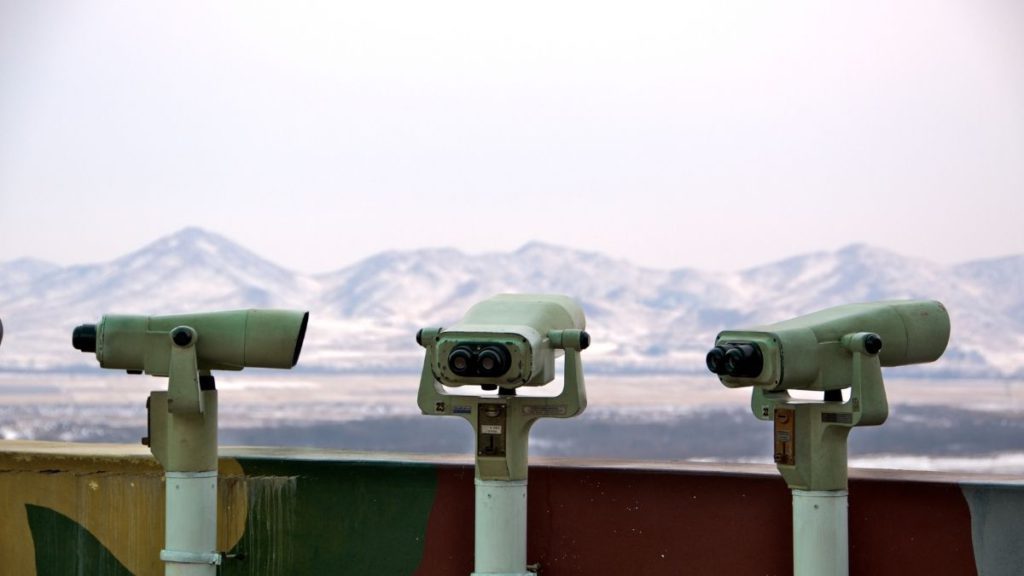
What to wear?
Appropriate attire is also important for a DMZ tour. Although there are no strict dress code requirements, you should avoid wearing anything that could be construed as offensive or provocative. In addition, because the weather in Korea can be quite hot and humid, it is advisable to dress comfortably and in layers.
Photography
Taking pictures is allowed in most areas of the DMZ, except the Joint Security Area (JSA). However, it is important to remember that photography is not allowed inside any military installation.
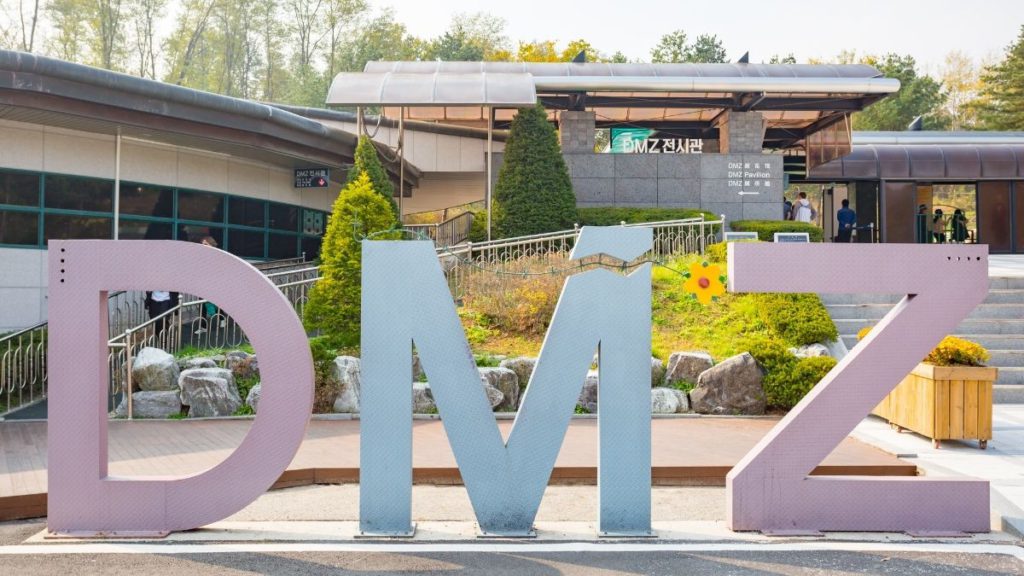
Food and Drinks
Outside food and drinks are not permitted in any of the DMZ’s tourist sites. There are restaurants located near each of the DMZ’s tourist sites, so you will not go hungry. In addition, there are also a few souvenir shops where you can buy snacks and drinks.
The DMZ is a unique and interesting place to visit. It is full of history and offers visitors a glimpse into the lives of North Koreans. However, it is important to remember that the DMZ is still a military zone and some certain rules and regulations must be followed. By following these guidelines, you will have a safe and enjoyable visit to the DMZ.
KoreaTravelPost Editor
Hello there! I'm the Features Editor for KoreaTravelPost.
Related Posts
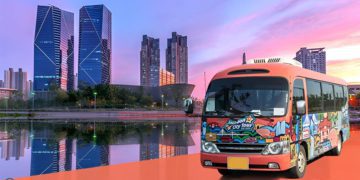
Discover the Vibrant Heart of Incheon: A NEW City Tour Adventure Awaits!
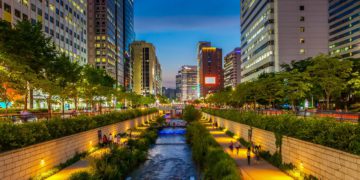
3 Most Romantic Destinations in Seoul
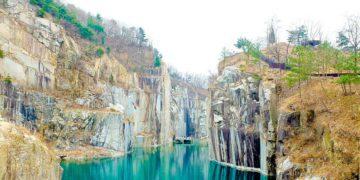
Planning A Day Trip to Pocheon from Seoul
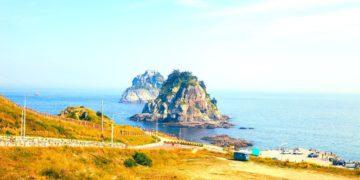
8 Korean Islands For Day Trips Near Seoul and Incheon Port That Aren’t Jeju or Nami

A Guide to Incheon’s Wolmido Island: A Hidden Gem in Korea
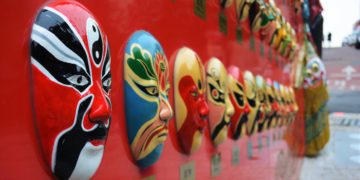
Incheon Chinatown: All You Need To Know

A Guide to Incheon's Wolmido Island: A Hidden Gem in Korea

TESSAN Germany France Travel Power Adapter

Lonely Planet Korea 12

Korean Snack Box Variety Pack

OSULLOC Lovely Tea Gift Box Set
More from our network.

- Medical Tourism
FREE NEWSLETTER
Copyright © 2024 About Us| Terms of Use |Privacy Policy| Cookie Policy| Contact : [email protected]
Login to your account below
Fill the forms bellow to register
Retrieve your password
Please enter your username or email address to reset your password.

Borders Of Adventure
Leading Culture and Adventure Travel Blog by Becki Enright. Looking at the world with a different angle to change perceptions of misunderstood places, for the best in travel.
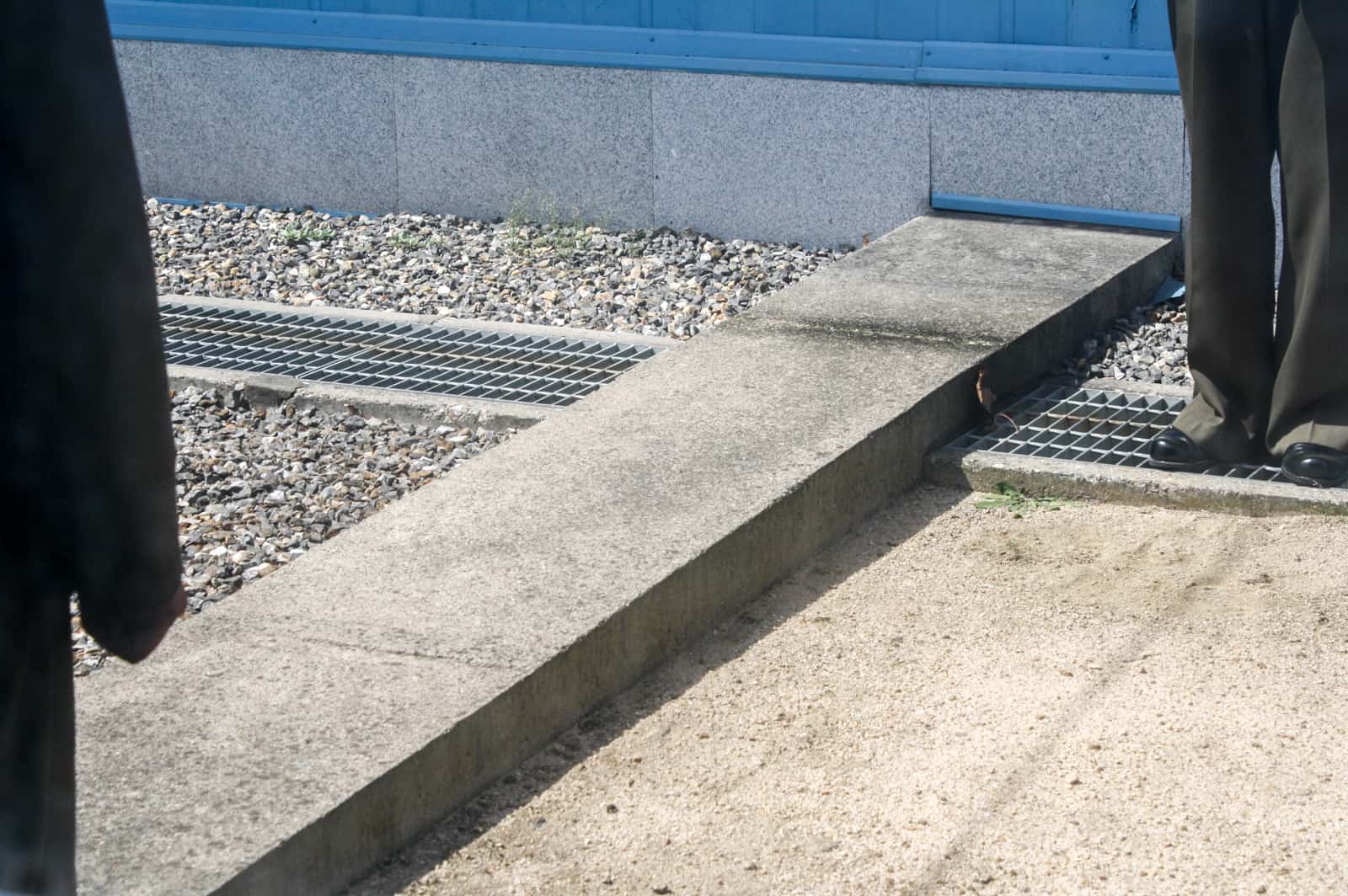
Misunderstood Destinations , North Korea , South Korea
Visit the DMZ in North Korea and South Korea – The Story From Both Sides
Disclaimer: This post contains affiliate links to handpicked partners, including tours, gear and booking sites. If you click through or buy something via one of them, I may receive a small commission. This is at no extra cost to you and allows this site to keep running.
To visit the DMZ from North Korea is tense and from South Korea, less so. What is it like to tour the DMZ and JSA and witness the world’s most heavily armed border?
I remember the first time I saw what visiting the DMZ in Korea was all about. I was 15 years old and watched Michael Palin go there on one of his travel series called Full Circle. He stood in a bland-looking room, spoke of the history of the Korean War, told us how he had to basically sign his life away on a piece of paper.
He then crossed an area of the room where there was a line marking on the floor. “Here I’m in North Korea,” he said, before moving his feet just a few inches and adding, “Now I’m in South Korea.”
I marvelled at the location of the DMZ, thinking about how you can stand in two countries at the same time, compounded by the horror that a divided Korea had such an intimidating, military-armed border. Would a trip to the world’s most heavily fortified border, dubbed “the scariest place on Earth” by former US President, Bill Clinton, during his visit in 1993, put a person’s life at risk in case of any outbreaks of gunfire, fighting, and attacks?
Rather, the DMZ Demilitarized Zone that slices Korea in two is something important to try and comprehend. Why does the DMZ exist? Is it a scary place? Why has the DMZ become a tourist attraction? Here’s what you need to know before you go.
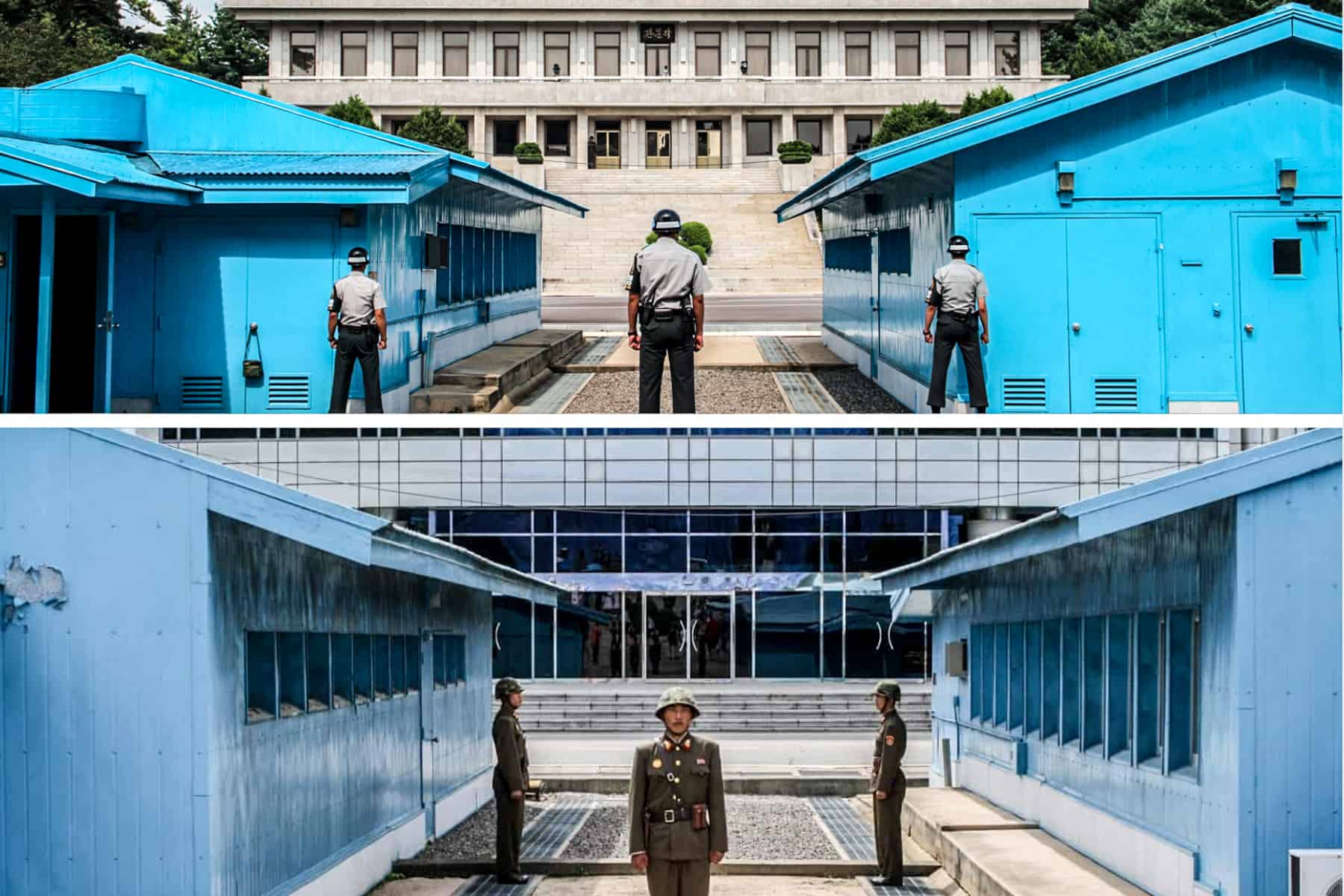

What is the DMZ Demilitarized Zone?
What part of the dmz do i see as a tourist, how to visit the dmz in north korea and south korea, the dmz in north korea (dprk), the dmz in south korea (republic), the reality when you tour the dmz, should a visiting the dmz be on your korea itinerary, dmz tour north korea, dmz tour south korea, planning to visit the dmz in korea save for later. .
The DMZ is a four-kilometre wide belt stretching 250 km, cutting the Korean peninsula almost in half at the 38 th parallel , and was put in place in 1953 as a ceasefire to the Korean War.
The Chinese and North Koreans pulled back 2km north and the UN forces 2km to the south, creating a ‘No Man’s Land’. Tanks, heavy artillery and mines exist on the Northern and Southern Limit Lines that are lined with barbed wire fences, but not within the DMZ itself, as was part of the armistice agreement.
Running through the middle of the 4km belt of ‘No Man’s Land’ is the Military Demarcation Line (the ‘actual’ border) and here sits Panmunjom – the “truce village”.
Within the neutral Panmunjom is the Joint Security Area (JSA). This is where negotiations between both sides took place and where today, democracy and communism now stand face-to-face in animosity. The Joint Security Area is the only section of the Korean DMZ where North and South Korean forces stand face-to-face.

The DMZ Military Demarcation Line at Panmunjom, Korea.
When you travel to the Korean DMZ on a tour, you will visit the JSA. Here, you enter the Military Armistice Commission Conference Room – the only place where anyone can freely ‘cross’ the Demarcation Line.
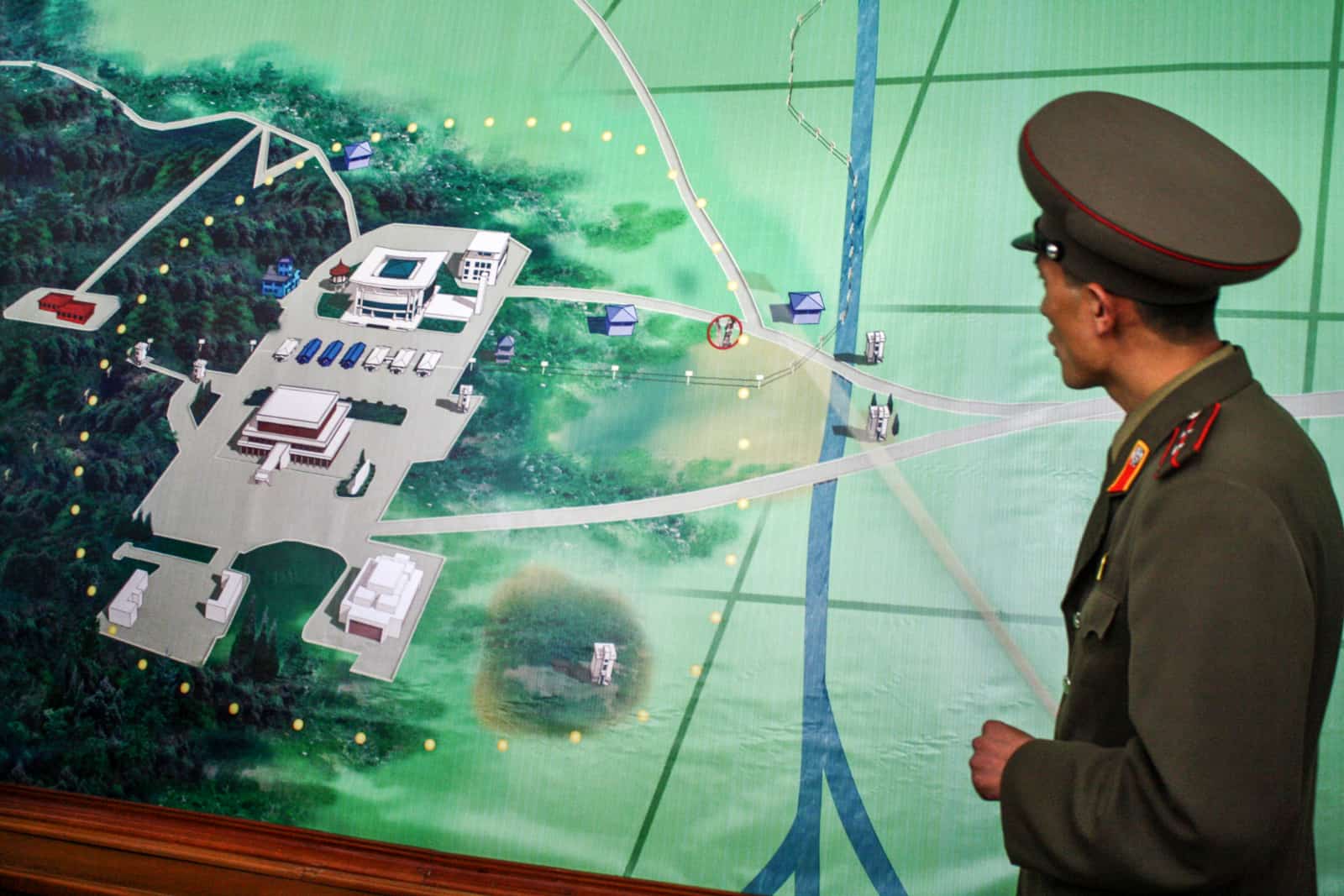
An explanation of the DMZ and JSA area by a North Korean guard.
I have seen the DMZ from both sides of Korea.
For me, it’s how I wanted to see and understand it – from the TWO viewing points in Panmunjom. I stood on the North Korean side in November 2012, and in South Korea a year later.
However, despite the viewing lines being only meters away from each other and the room you enter being the same one, they were both very different experiences.

North Korean Guards at the DMZ DPRK Side
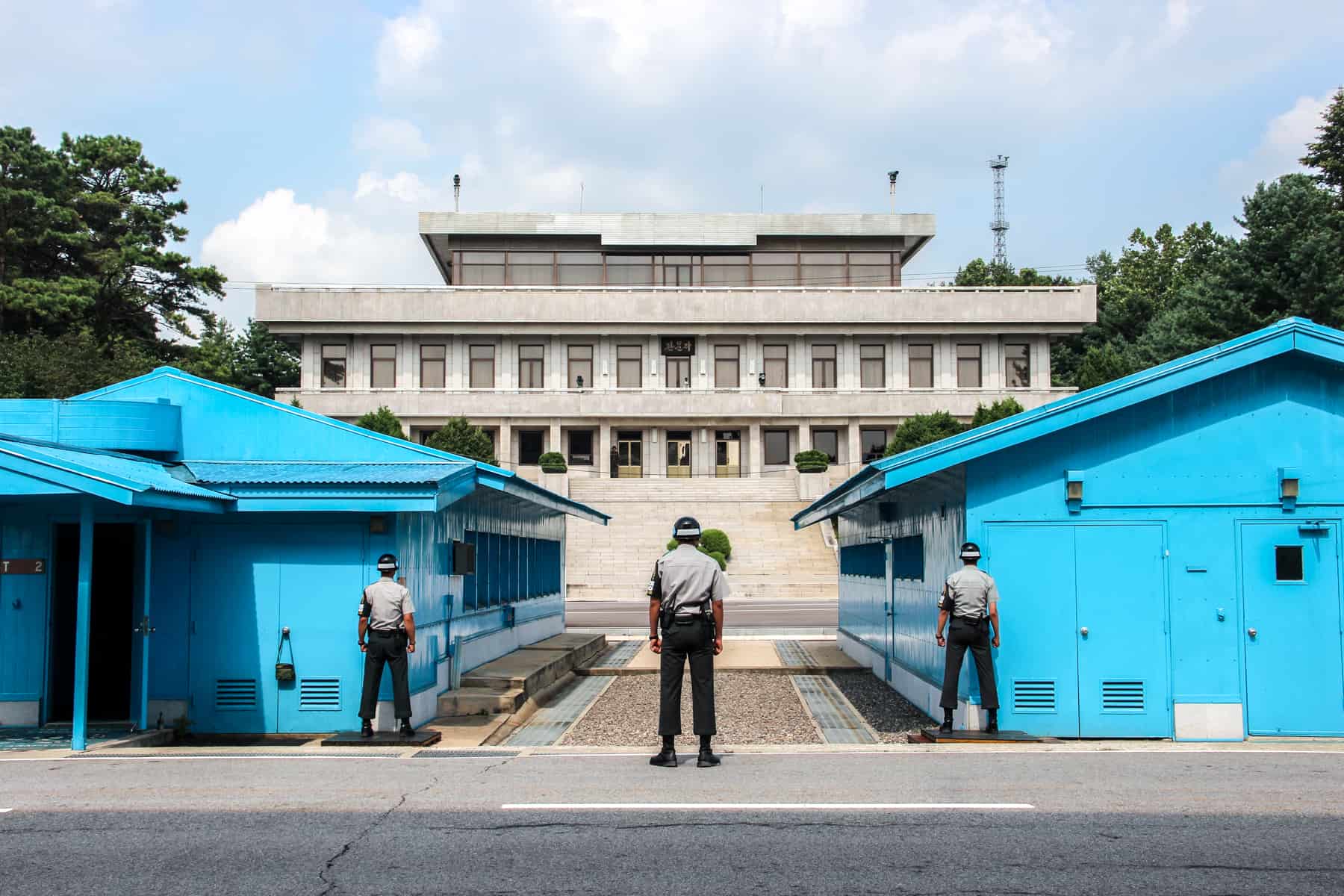
South Korean Guards at the DMZ facing the North Korean side
Visiting the DMZ from North Korea was filled with adrenalin and a little fear. Not only were we in the world’s most closed country, but we were also on the world’s most dangerous border between two countries still technically at war.
To say we were on our guard here, despite being in the safety of a group, is an understatement. It took us around three hours to reach Panmunjom from the Capital of Pyongyang, where we all waited at a busy check-in area (complete with souvenir shops) as we watched our North Korean guides have their passports swiped firmly out of their hands.
It was time to get on the coach and drive the short way to the JSA, driving through a long road lined with large square boulders that would fall and block the road should any sign of attack be imminent (the same tactic exists on the South Korean side).
It felt tense, yet we were calmed upon arrival by the opportunity to look through historical artefacts, documents, and historical boards in a building designated as a North Korea museum – propaganda and all. It was, in fact, where the Korean Armistice Agreement was signed.
Our North Korean military guide was an approachable man, and not half as scary as I imagined him to be. He spoke the North Korean version of events, yet it wasn’t as propaganda heavy as other situations we had found ourselves in. It felt far more serious here, being so close to the ‘opposition’.
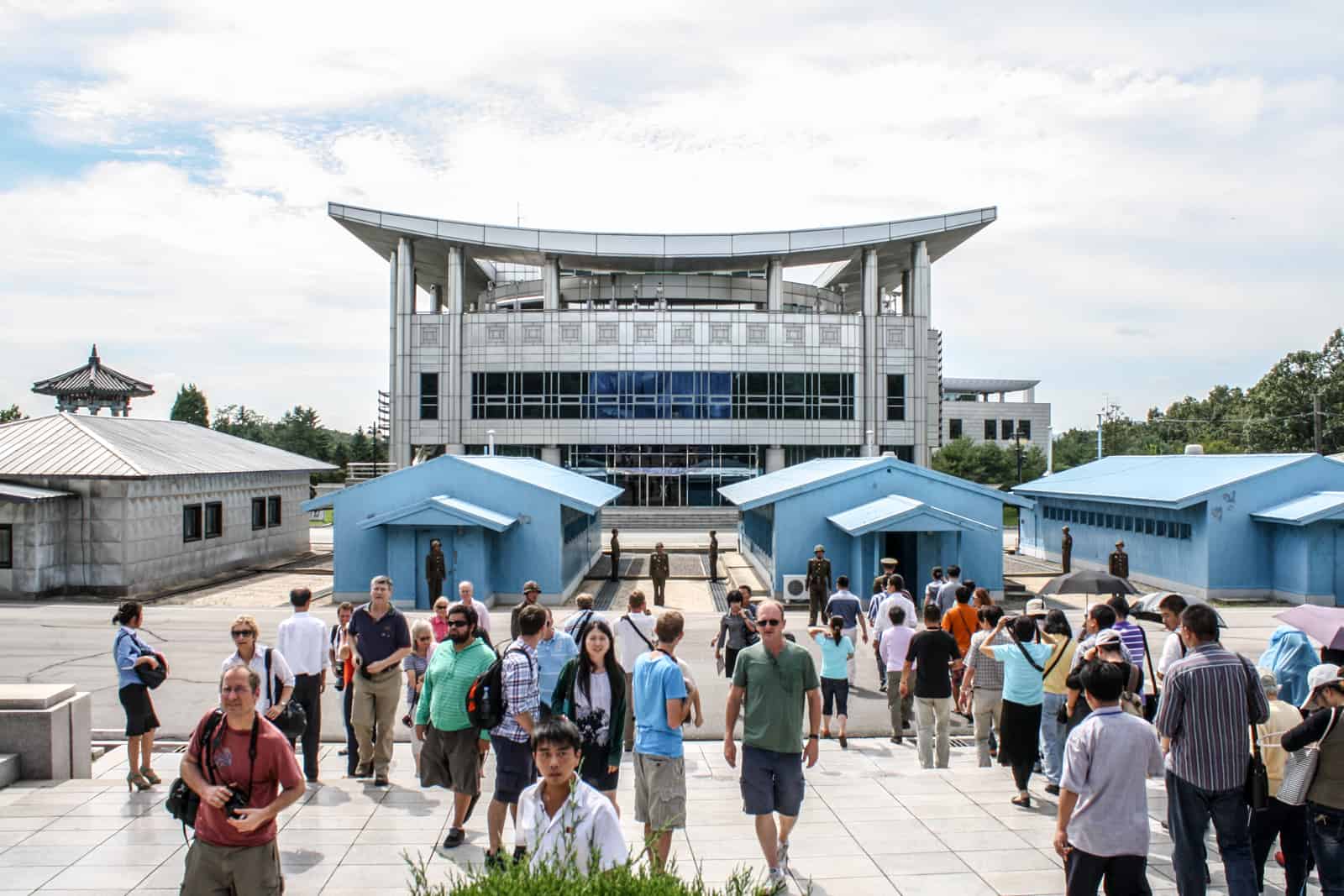
A DMZ JSA tour from North Korea.
Taking us through to the viewing platform, through an imposing, beige building, we all stood on the steps of the building looking out over to the building on the South Korean side. It was surprisingly calm, yet it felt incredibly eerie. No South Korean soldiers were present, just North Korean soldiers keeping guard.
There wasn’t the grand face-off we hear about in the media. I guess this is toned down during visits, with designated times given to both sides for tourist arrivals.
Only when we are gone, do they stand literally face-to-face with one another.
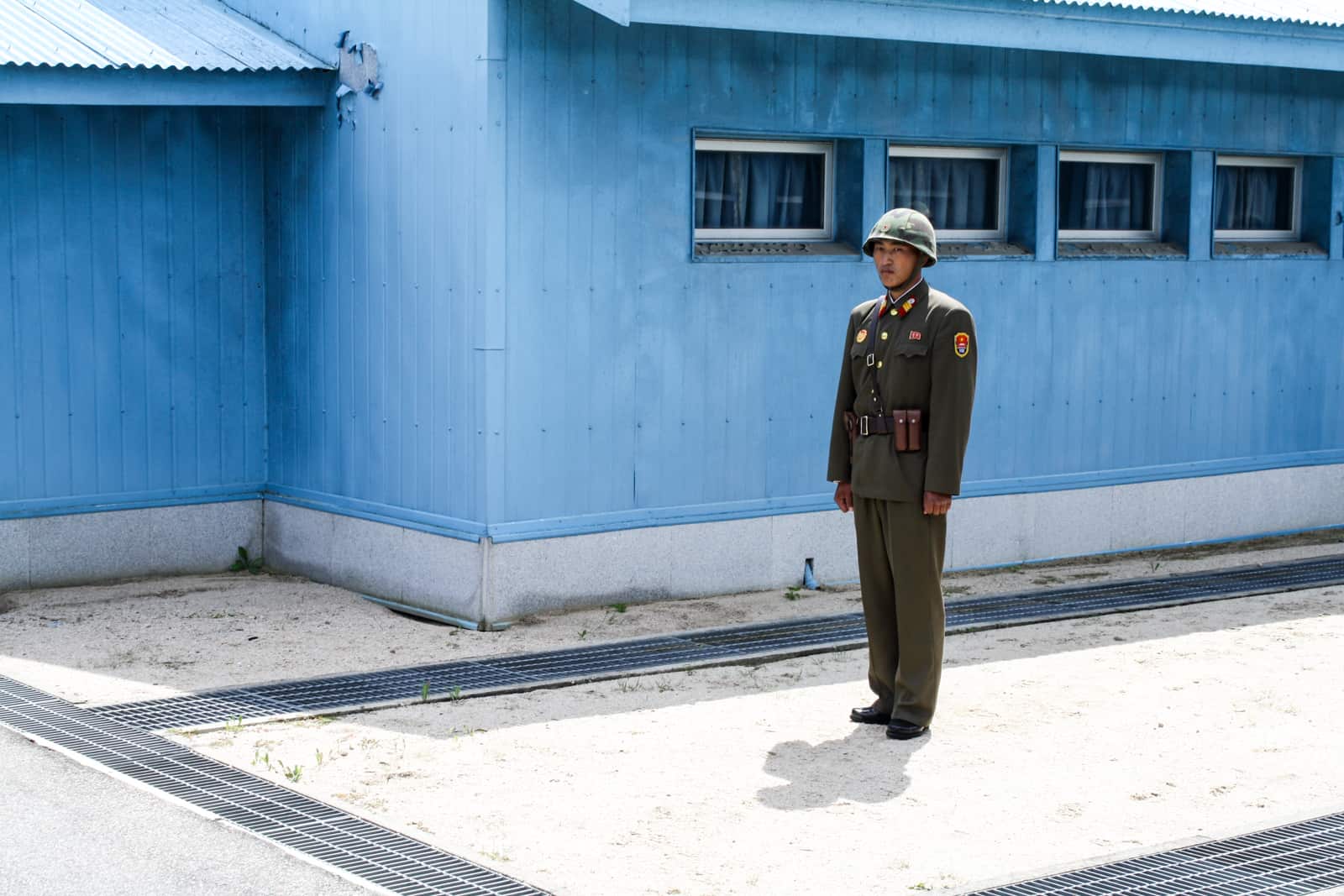
After 10 minutes or so, we were then taken into the blue hut – the Military Armistice Commission Conference Room that straddles the Demarcation Line. We were allowed to sit at the table (the ‘line’ cutting through the middle of the table) and, watched over by our guide, we all sat on either side of the table shaking hands across it, marking the peace we all wish for.
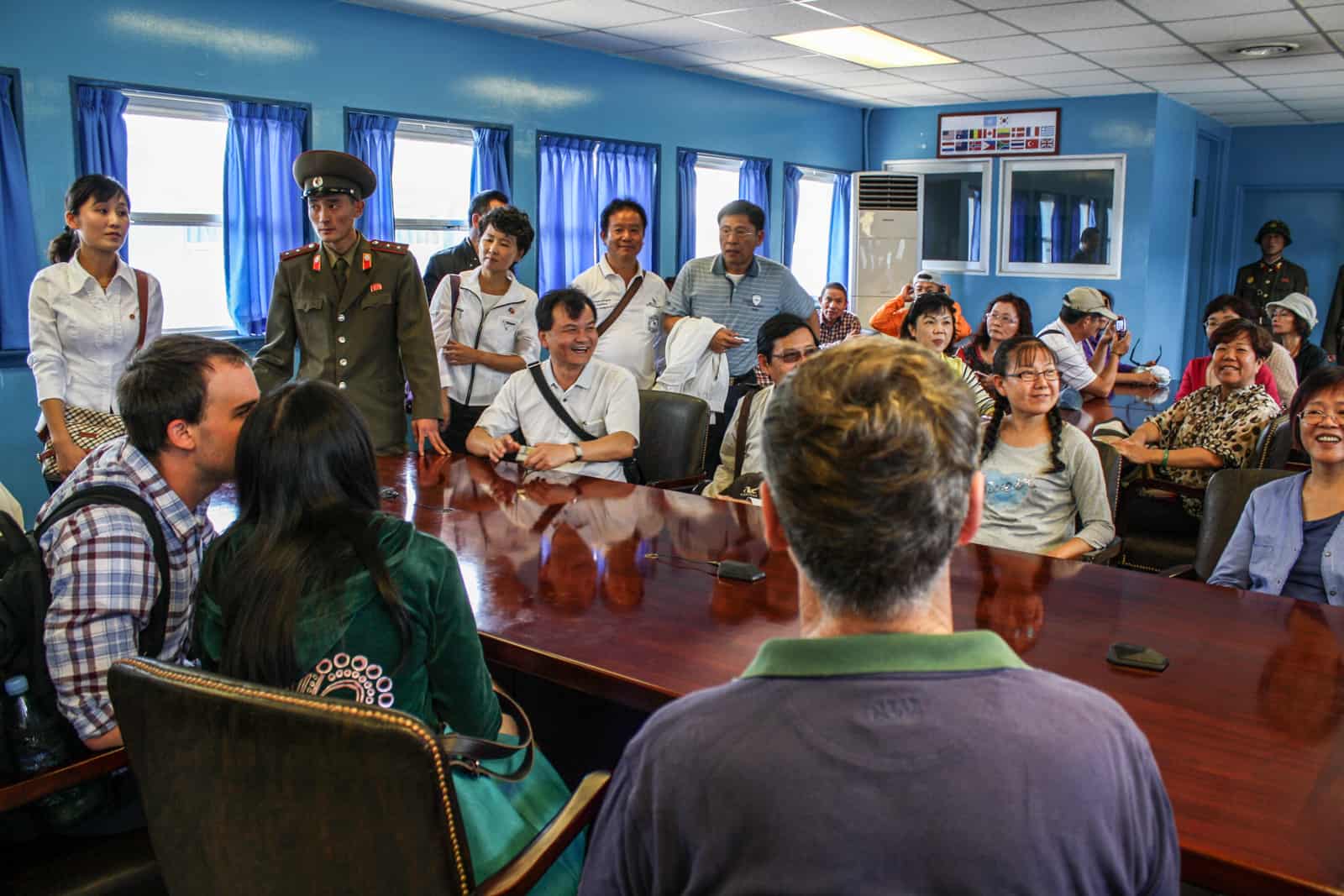
Visiting the DMZ Military Armistice Commission Conference Room
One North Korean guard stood staunchly guarding the door that leads to the South Korean side of the JSA, his fierce and set expression creating an atmosphere in the room that signalled this as very serious business. It was a day none of us could forget.
READ MORE: Travel to North Korea – Where Preconceptions and Reality Collide
In South Korea, DMZ tourism is a big business. Here, you can choose from a multitude of DMZ tours from Seoul, from full-day visits, JSA only tours to hikes and tours with North Korean defectors.
I decided on a full-day tour in order to see a series of historical sites and relics that can help formulate a better picture of the division between North and South Korea and setbacks to reunification.
The sites you see on this tour include:
The ‘Friendship Bridge’, a train station that links both countries via a single line, but whose full service is obviously not in use. However, some tours do allow you the opportunity to take a short journey on part of it, on the DMZ Peace Train from Imjingak to Dorosan Station, which you also visit.
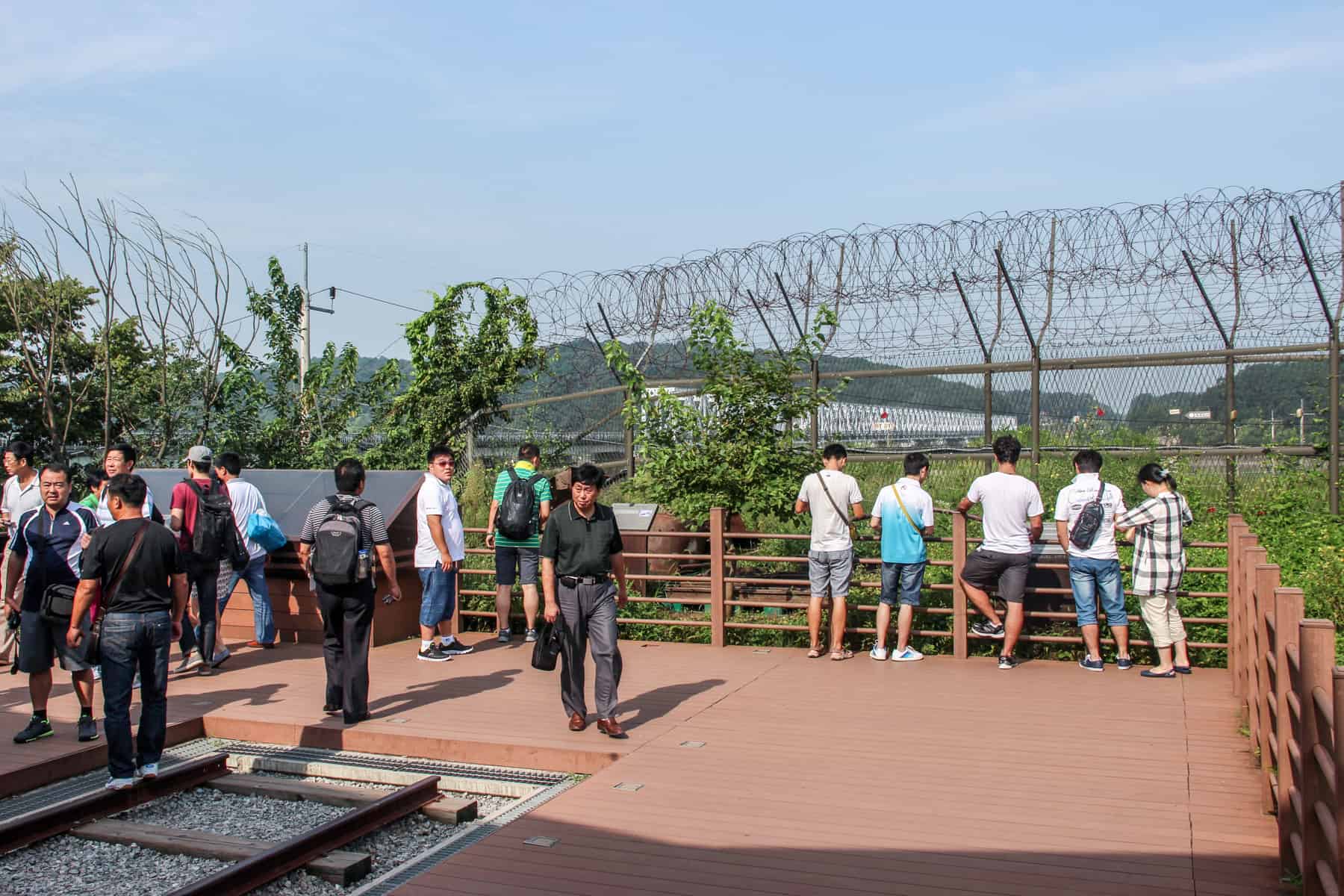
View to the Friendship bridge from unused sections of the railway line intended to connect South and North Korea.
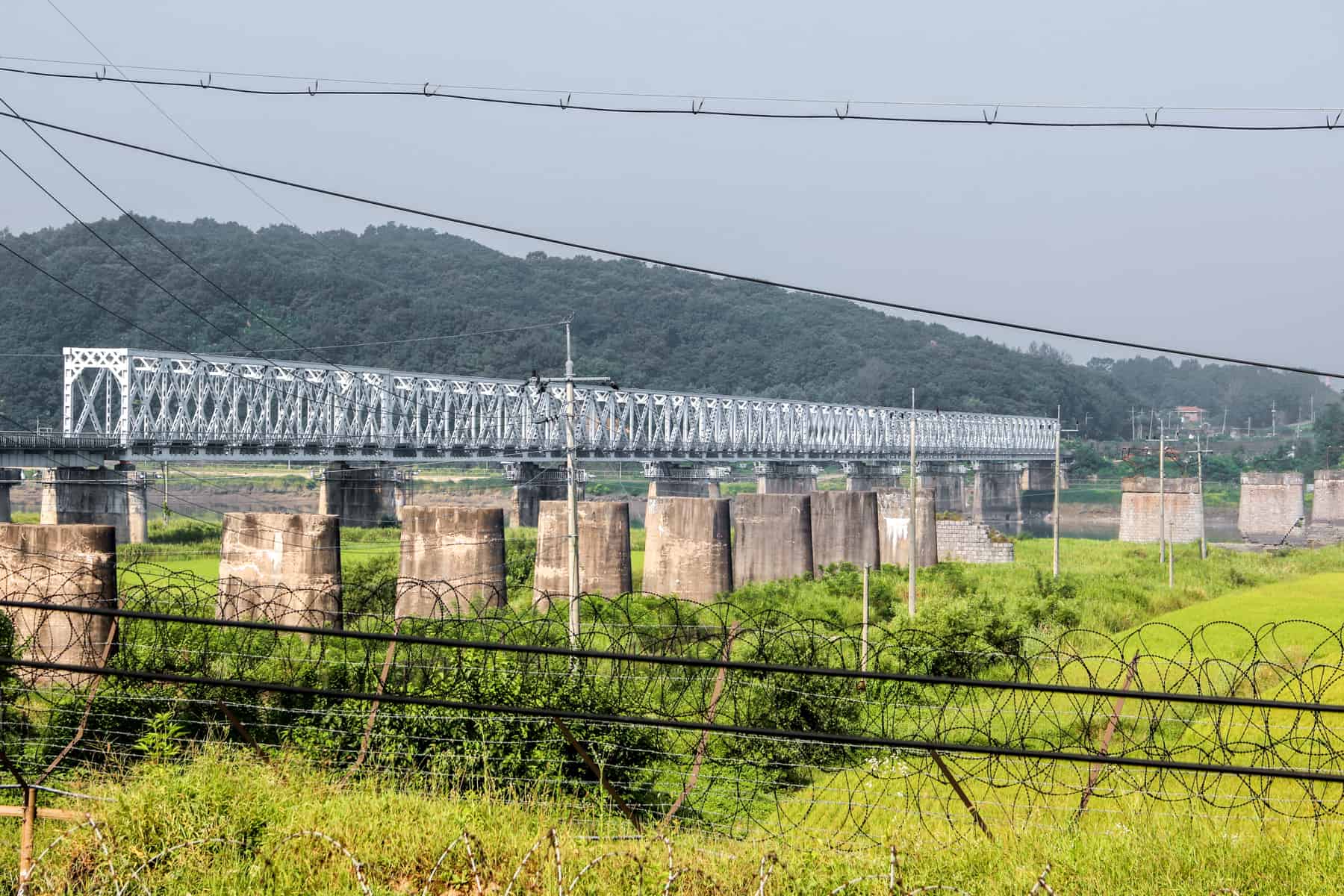
The Friendship Bridge – part of a railway intended to link both countries via a single line.
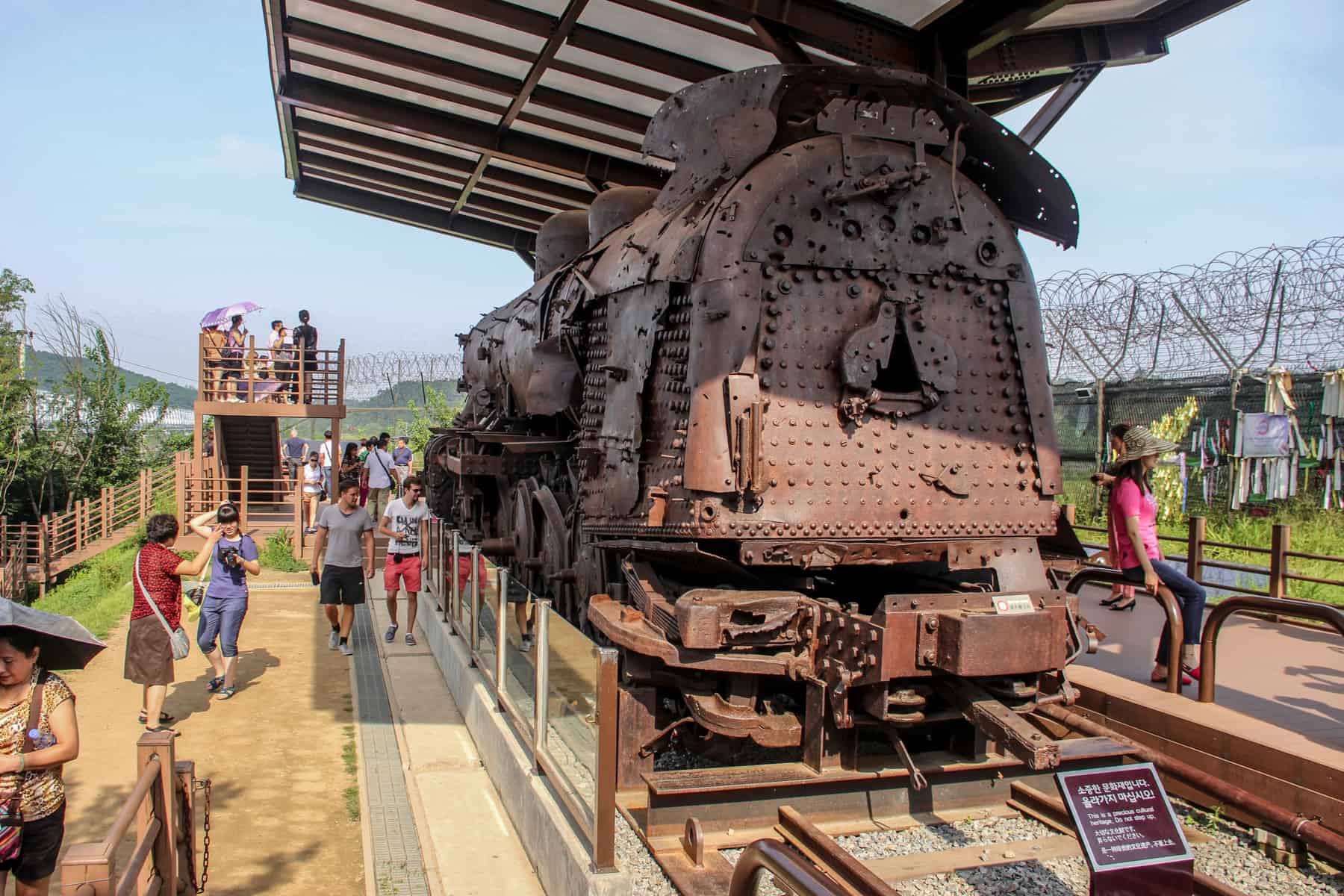
The metal relic of an old steam locomotive, derailed by bombs during the Korean War.
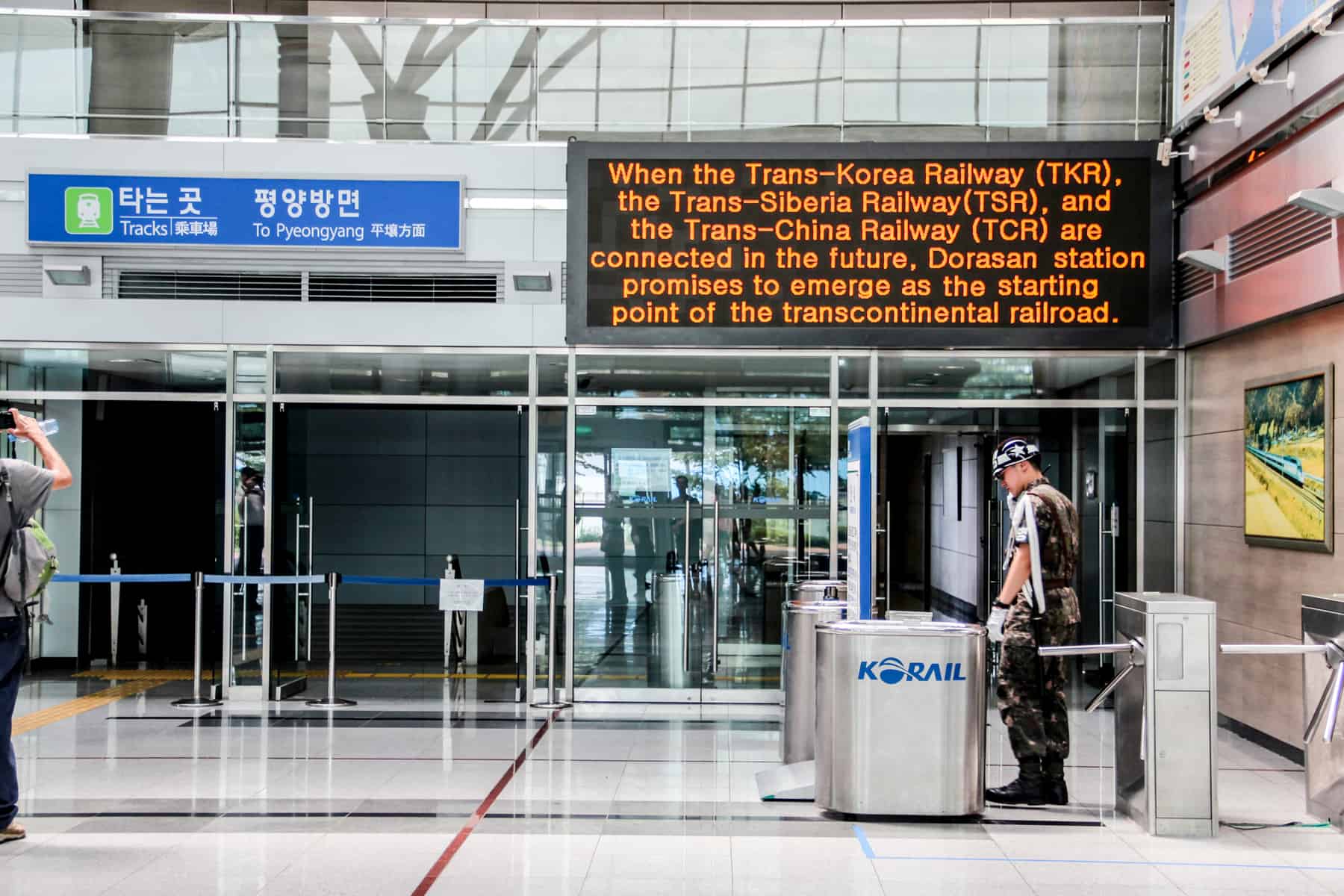
Inside Dorasan Train Station – part of the ‘Peace Train’ intended to connect to Pyeongyang, the capital of North Korea.
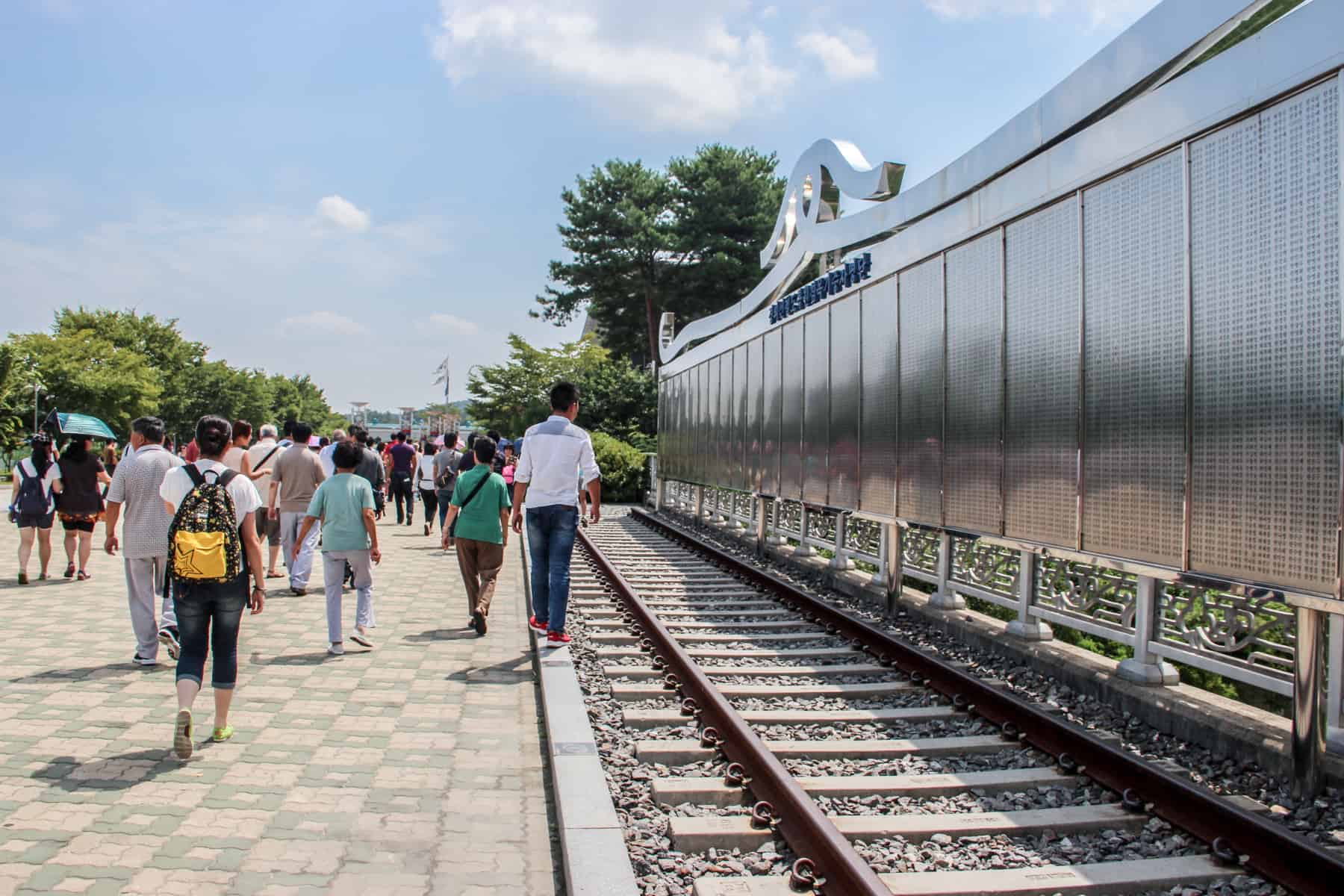
Dorasan Train Station Memorial.
The Dora Observatory where you can look out over North Korea. The most prominent lookout point is to the North Korean ‘Propaganda Village’.
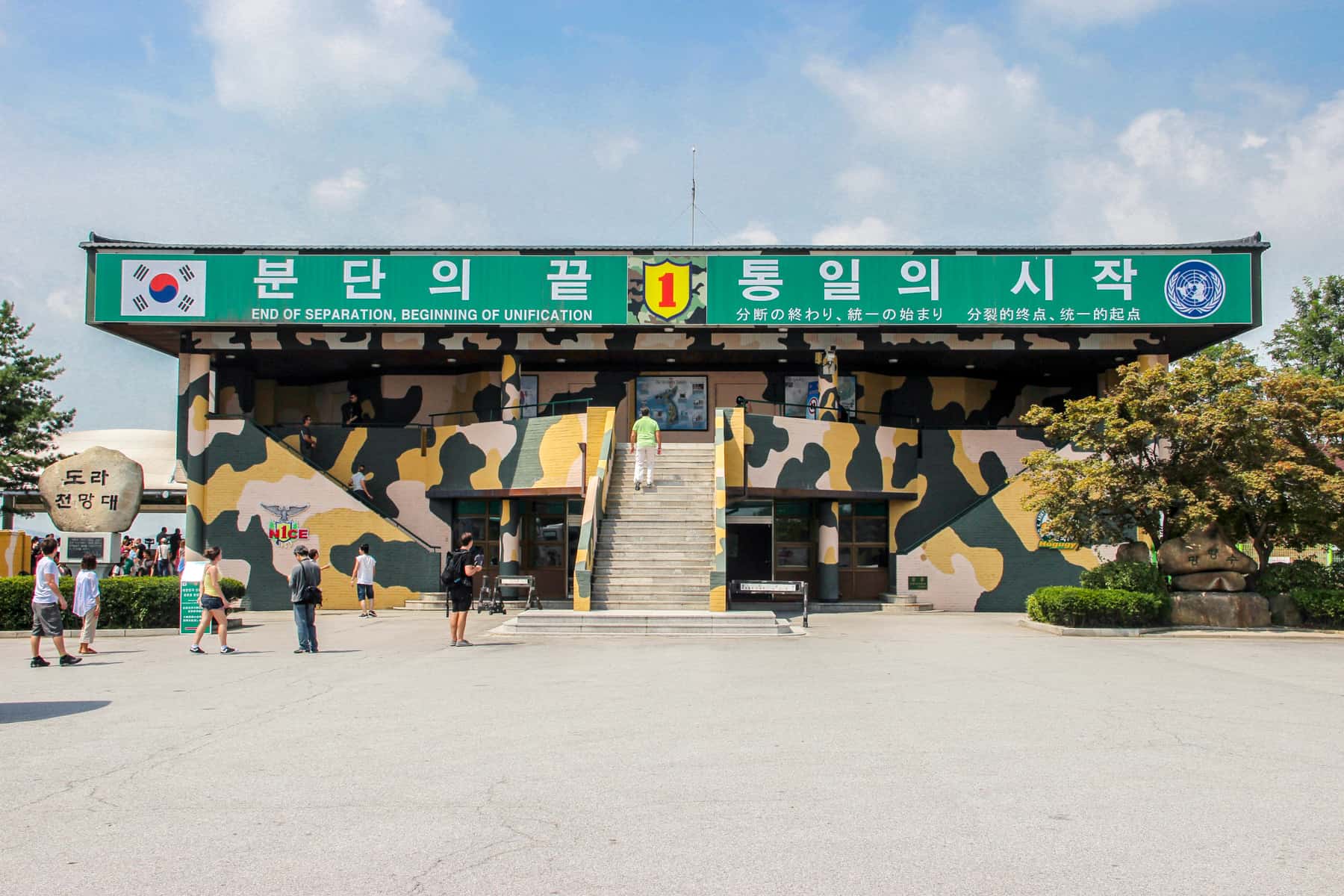
The Dora Observatory at the DMZ – the main lookout point facing North Korea.
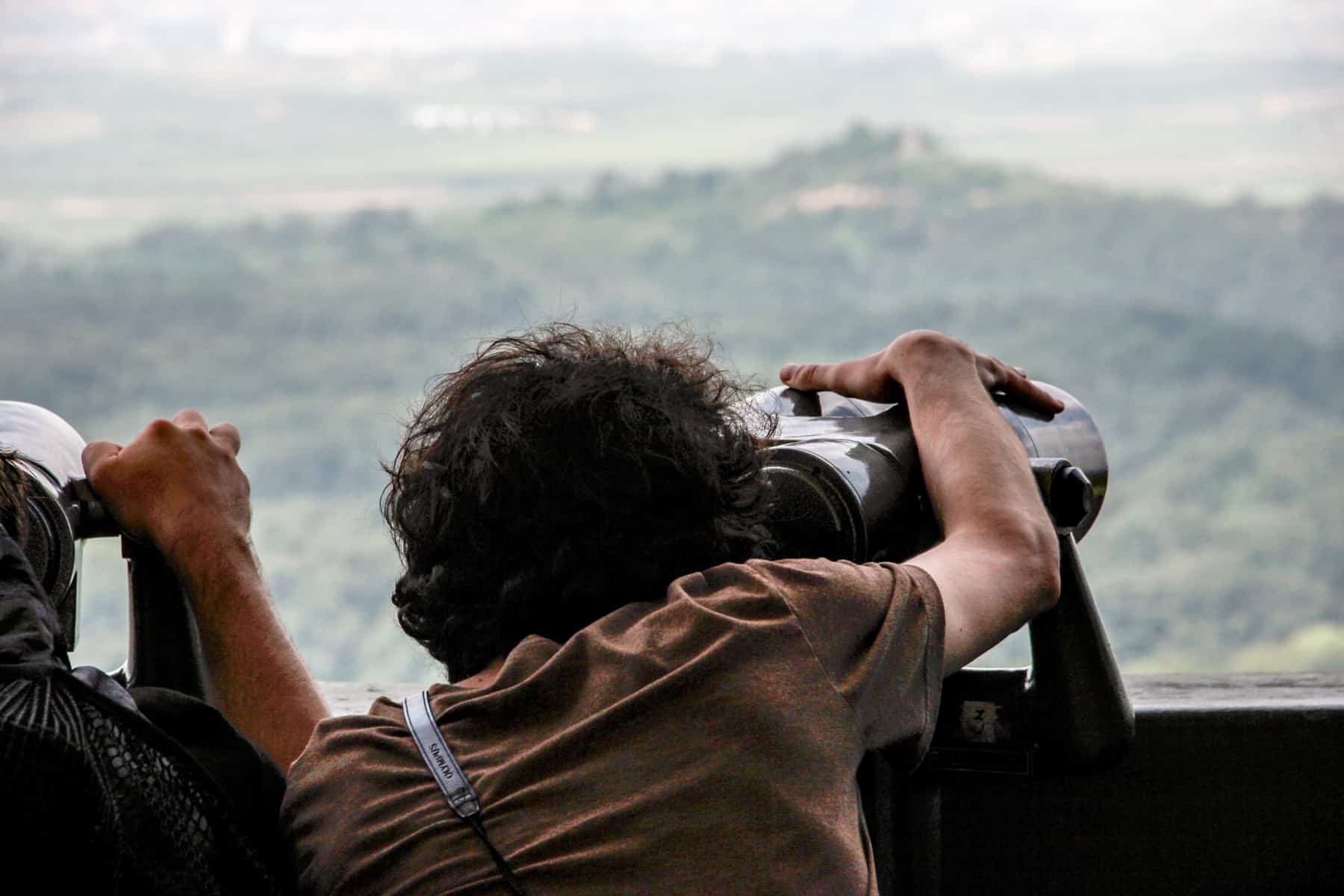
Binocular views to North Korea.
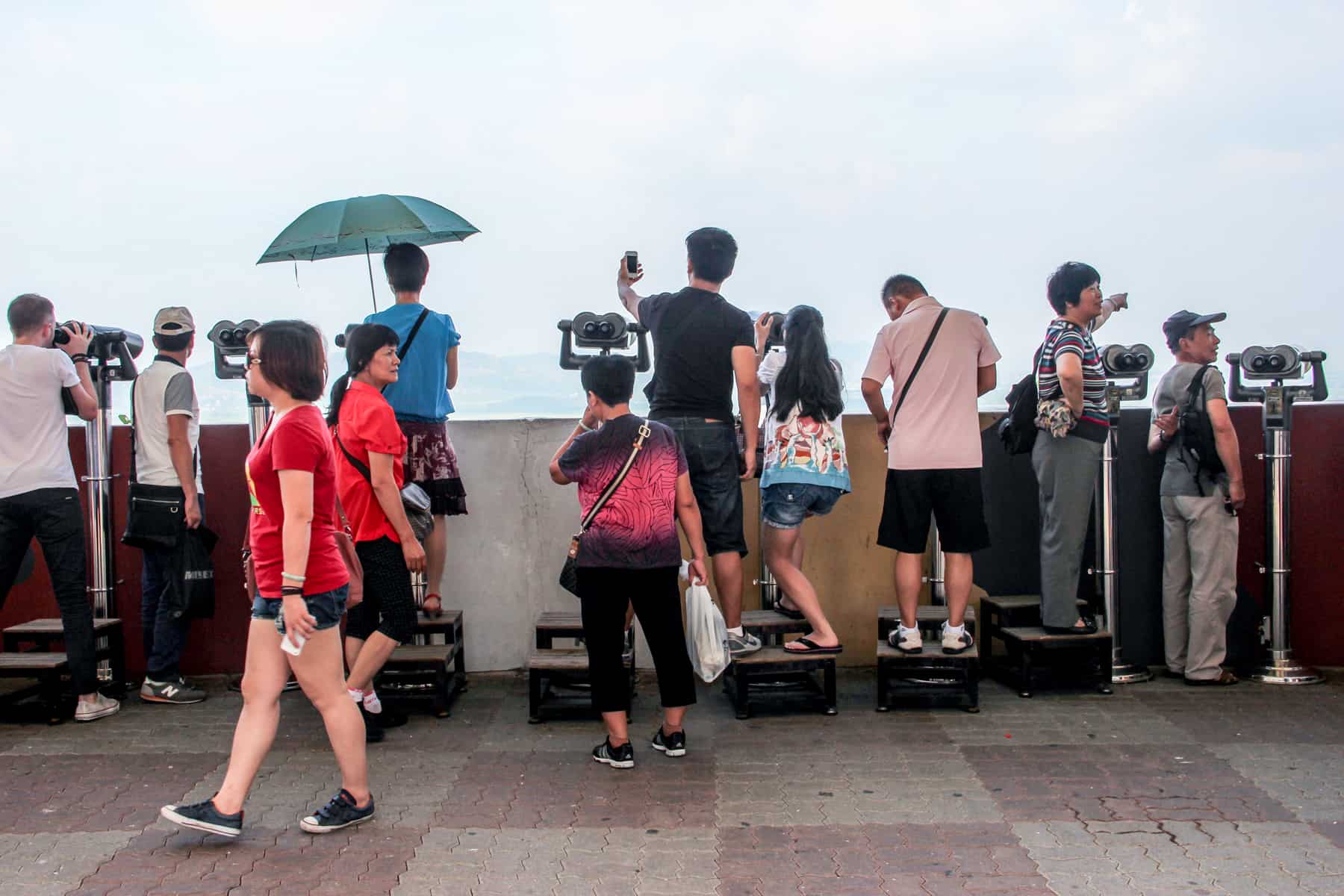
The Dora Observatory where visitors eagerly gaze into North Korea’s Propaganda Village.
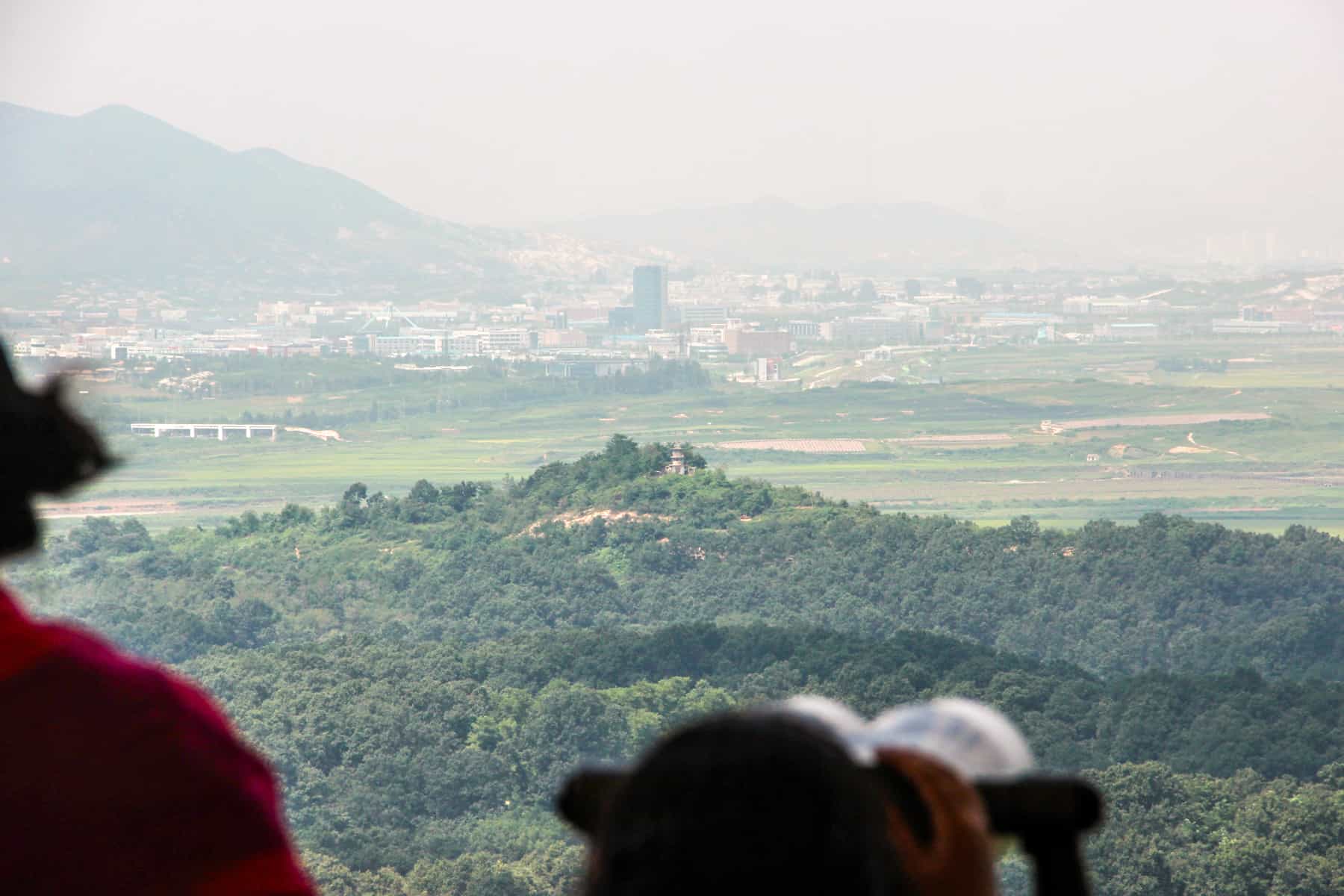
The North Korea Propaganda Village as seen on a DMZ tour.
The 3 rd Tunnel (Third Infiltration Tunnel) – a 1,632m tunnel dug by the North Koreans, from which they could pass through into Seoul within an hour and invade, alongside tourism documentation and video centres.
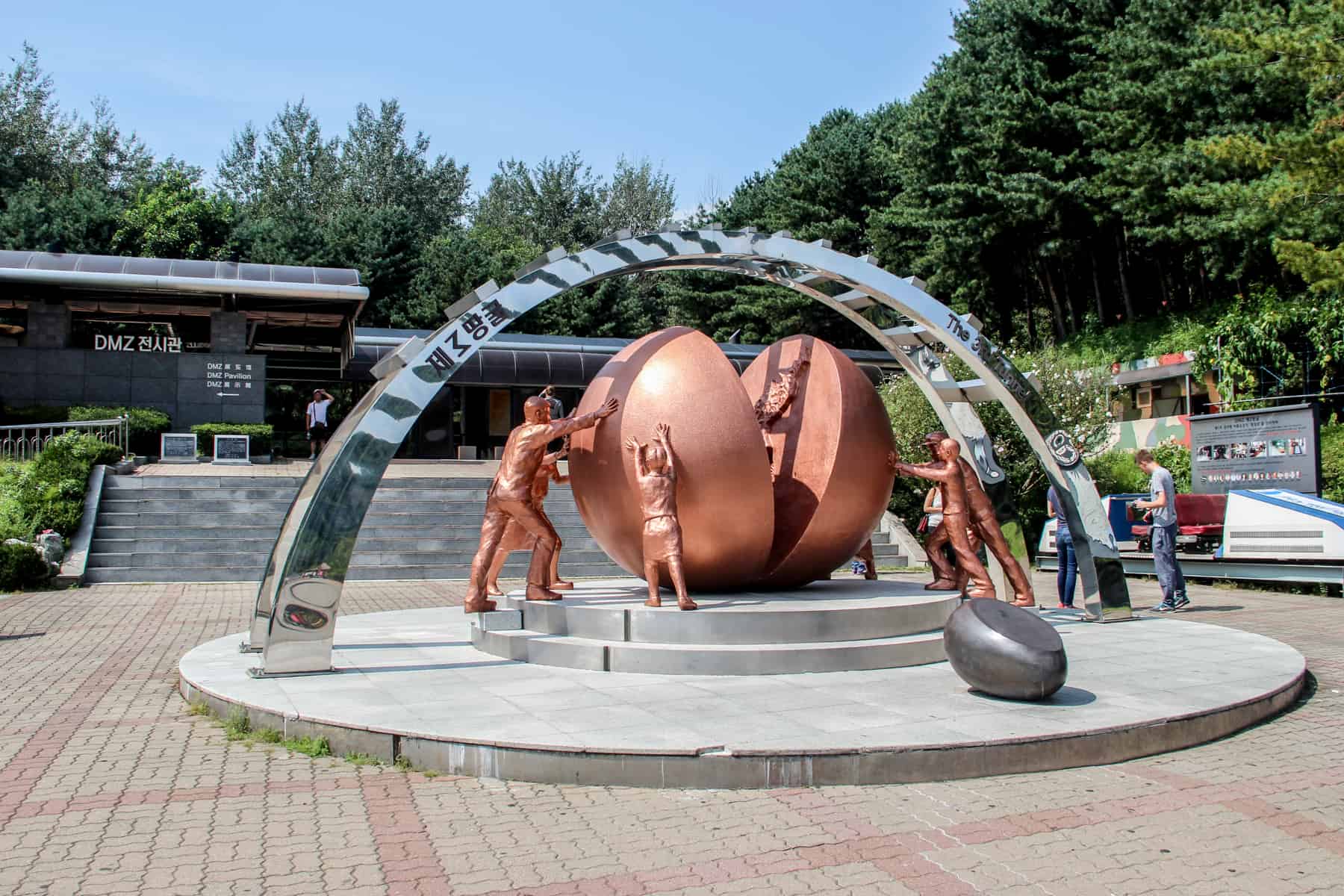
The artwork depicting reunification, marking the entrance site of the Third Infiltration Tunnel at the DMZ.
The last stop of the DMZ tour is the main site – the Joint Security Area (JSA) at Panmunjom. Here, you are shown a video and given a short introduction about South Korea’s version of events and how the US military operates here, before visiting the Military Armistice Commission Conference Room (one if the blue buildings). You are not allowed to sit down or touch anything in the Conference Room, contrary to the more relaxed visit when entering from the North Korean side.
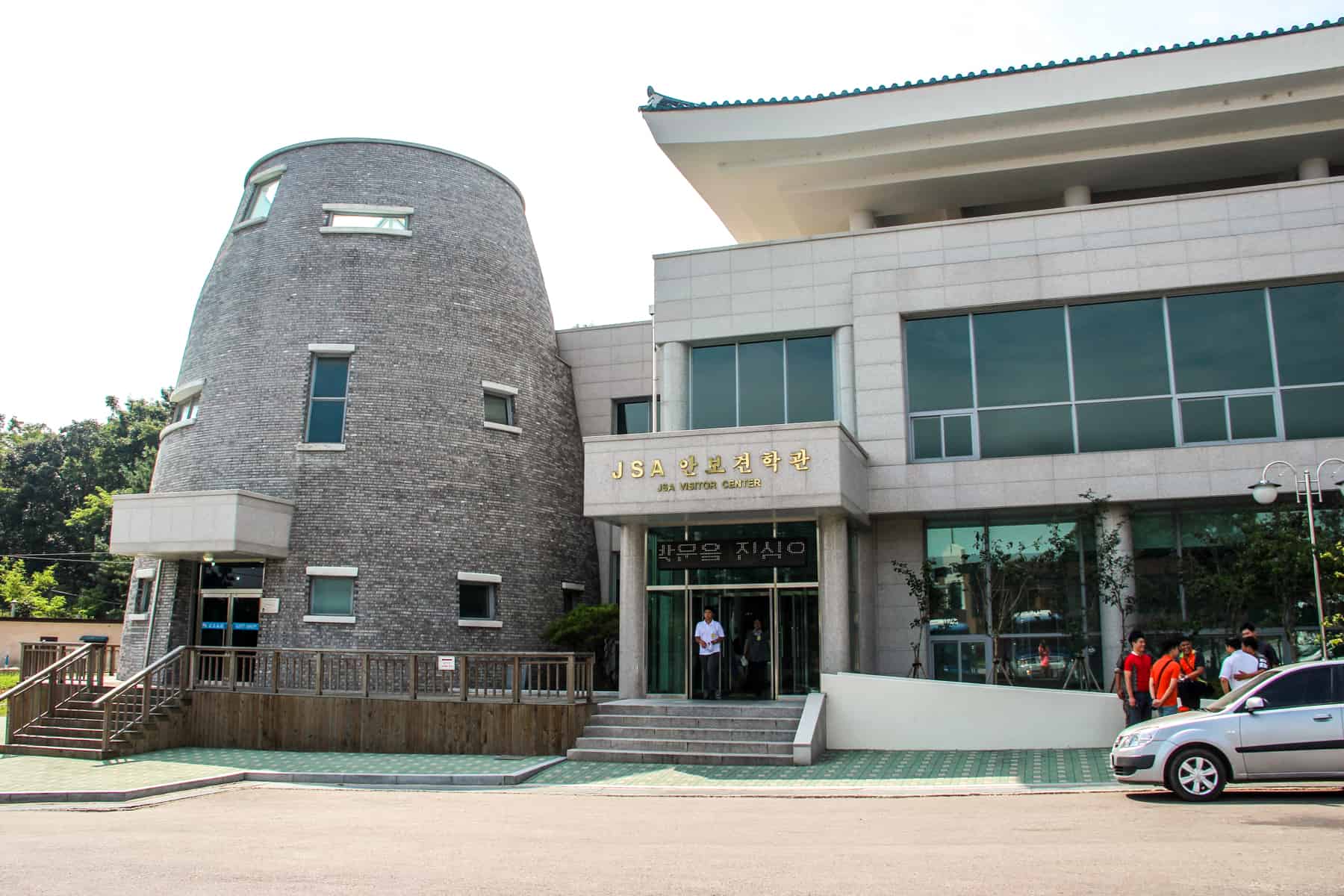
The most significant site when you tour the DMZ, is the Joint Security Area (JSA) Visitor Centre.
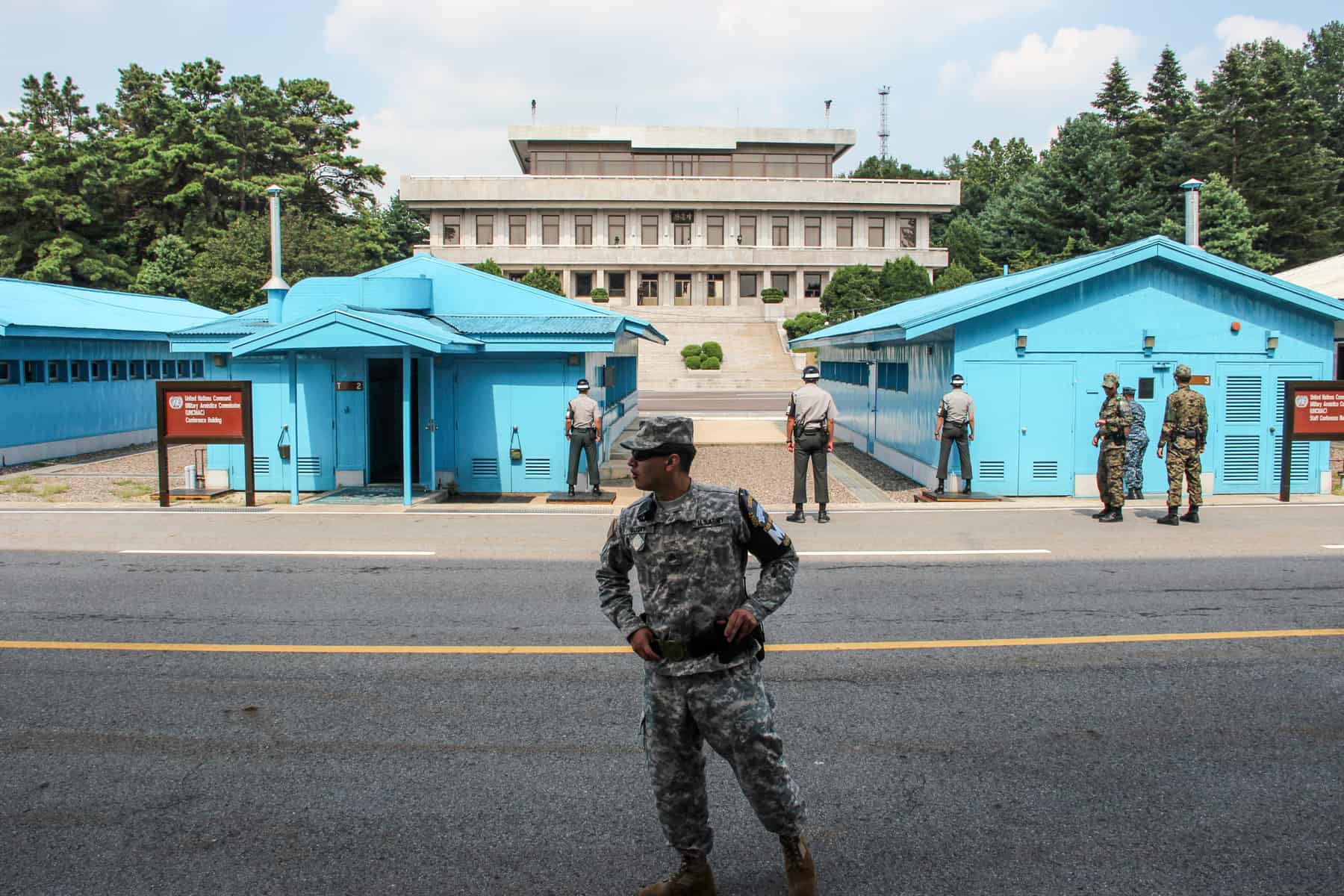
American military guides you throughout the JSA tour, seen here before entering the Conference Room.
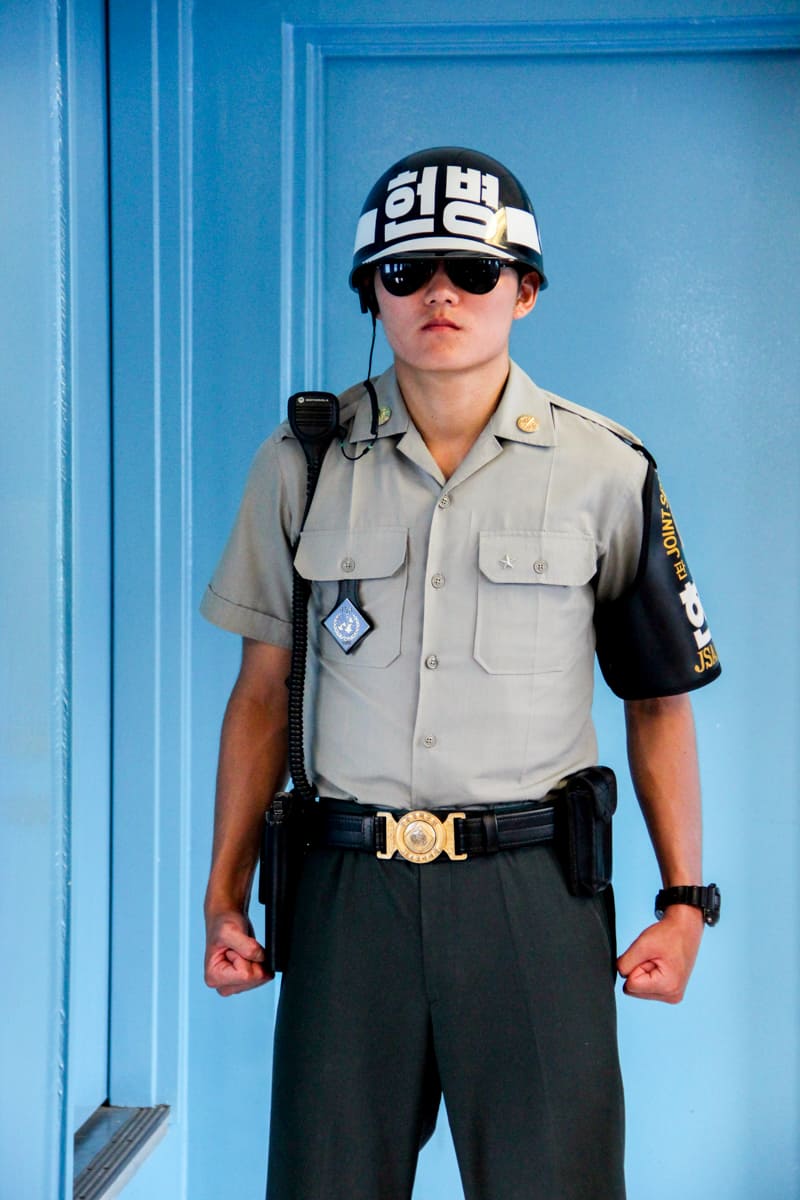
A South Korean guard in Taekwondo stance inside the Military Armistice Commission Conference Room.
As a tourist site, there are a few aspects of the DMZ tours that conflict with the seriousness of the situation.
For many of the tourists at the DMZ, I don’t think they really understood exactly where they were. At times, it felt like a day trip to Disneyland. This is at no fault of the tour company, which facilitates your transport between each of the sites and provides knowledgeable background and historical insights on the coach along the way, but the fault of who is behind the tourism surrounding this particular area. It could be the government, or whoever thought it was acceptable to build a fairground next to the area where the bridge is. Or those who thought it was acceptable to allow the Observation Deck to turn into a zoo-like atmosphere, surrounded by the screams of people looking through telescopes exclaiming, “Oh.My.God. I just saw an actual North Korean.” Yes, this really happened.
Never once did I feel the DMZ visit in South Korea was a serious issue or treated as a serious place. The US soldier, our guide, was young, knowledgeable and delivered a fantastic presentation that was factual and historically sound. Yet, for the most part, it’s treated as a bit of fun peering into the hermit kingdom. While people on the ground cannot change the ignorance and stupidity of some of the tourists who visit, there could be more educational markers put in place and the enforcement of more rules to encourage a little respect.
I felt that ‘reunification’ was nothing more than a throwaway term , later confounded by many South Koreans I met who said: “Many of us are not bothered by it”.
North Korean guards were present; they lurked in the shadows and behind the pillars of the beige building I had once stood at months before. We were informed of some rules to follow – we were not to take pictures of any North Korean guards that may appear in the building in the background, and not to make any faces or hand gestures that they can film and use as propaganda, or as a means of retaliation. Whilst I felt safe, the viewing point time felt unnerving, especially being around US soldiers who had a frivolous, laddish, macho attitude, and were themselves making gestures.
Time in the JSA conference room is more strict. Back in the blue building (the Military Armistice Commission Conference Room), we were once again told about the DMZ and the guard line, except we were not allowed to sit at the table, only stand around it. South Korean guards stood in their fierce Taekwondo stance – something of which they are famous for – yet tourists giggled and replicated the pose for photos.
That was something we would never have dreamt of doing on the North Korean side.
READ MORE: Travelling in South Korea – A Guide (But Glad I Gave it a Chance)
A visit to the DMZ is without a doubt an eye-opener and a must-see for those interested in history and current affairs. While a visit to North Korea is undoubtedly going to be fuelled by a more serious attitude, where you have to be guarded and ‘on your best behaviour’ at all times, I sadly think people miss the point when visiting on the South Korean side. A few people around me expressed disappointment with the way things were handled.
It’s a given that the majority of visitors will visit from South Korea, and so I would personally cut out the full-day tour and just stick with the specific JSA tour, yet be prepared for mixed signals regarding the seriousness of the current situation. However, for those with a deep interest in what is going on here, you will certainly take a lot more from the full-day visit of multiple sites.
As one South Korean woman said to me: “People have lost the meaning of what the DMZ is and what it’s there for. Like it’s a fun thing to do.” So when you visit the DMZ be sure to remember exactly what it stands for, why it exists and the people who have died protecting the border or trying to escape from it.
Book a DMZ Tour
I visited the DMZ on the North Korean side during my trip to the country with Koryo Tours. The JSA tour formed one afternoon as part of a seven-day trip to the country.
In South Korea, my visit to the DMZ was a day tour with VIP Travel, considered to be the best DMZ/JSR tour agency in Seoul.
The full-day ‘DMZ and Panmunjeom Tour’ (from 8 am until 5 pm) runs every day (except on Sundays, Mondays, National Holidays, and Military Training Days) and costs 135,000 Korean Won / around $120 US per person. You can read a full overview of the trip here.
The sites you see on this tour are: Imjingak Park → The Bridge of Freedom → The 3rd Infiltration Tunnel → DMZ Theater & Exhibition Hall → Dora Observatory → Dorasan Station → Pass by Unification Village → ID Check Point → Camp Bonifas → JSA (Freedom House, Conference Room)
Bookings need to be made at least 48 hours before the chosen day of the tour.
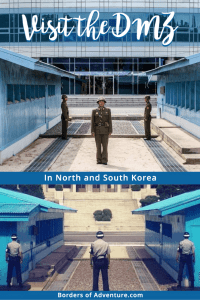
About Becki
Becki Enright is a British Travel Press Award-winning writer whose work focuses on changing perceptions about misunderstood aspects of destinations. Her writing combines storytelling with insight into the social, historical, political and economic factors that shape the country or place in relation to tourism. Becki has appeared live on Sky News and CNN and has contributed to high profile media including National Geographic, Time.com, Guardian online, New York Times, Grazia and Buzzfeed.
Arthur Hernandez says
16 March 2019 at 6:00 am
December 1967 thru January 1968. I was assigned as an Army medic to an infantry company with the 2nd Infantry Division that made patrols along the DMZ. We lived in tents in the JSA area. I remember that there was a chopper pad, a small hut that served as a PX where we bought Playboy, candy, writing stationery, tooth paste and other small items that were part of our infantry lives. Along the DMZ on our patrols there was not much of a fence and sometimes you would see holes that had been cut so that a person(s) could make their way through. We found a tunnel and the Captain lined up five infantry guys shoulder to shoulder with full packs to get an idea of how many troops could pass through. I remember Freedom Village, Freedom Bridge and the Imjin River. Most of all, I remember the grunts, the Infantry guys. I do not remember so much their names but their faces when it was bitter cold and it snowed or it rained sheets of rain and they did guard duty in foxholes manning the 50 caliber machine gun. During this time period, the Pueblo ship was seized and North Korean infiltrators came across to kill the South Korean President. On one of our patrols, we captured two of them and killed one of them who was about to throw a grenade. Second Infantry Division-Second to None! I salute the grunts who called me Doc and took care of me. I still remember.
- Article Archives
- Work with me
- Privacy Policy


DMZ Tour Review (+ How To Choose The Best One)
By: Author Mark and Kristen Morgan
Posted on Published: May 8, 2023 - Last updated: March 6, 2024
Categories Asia Travel Blog
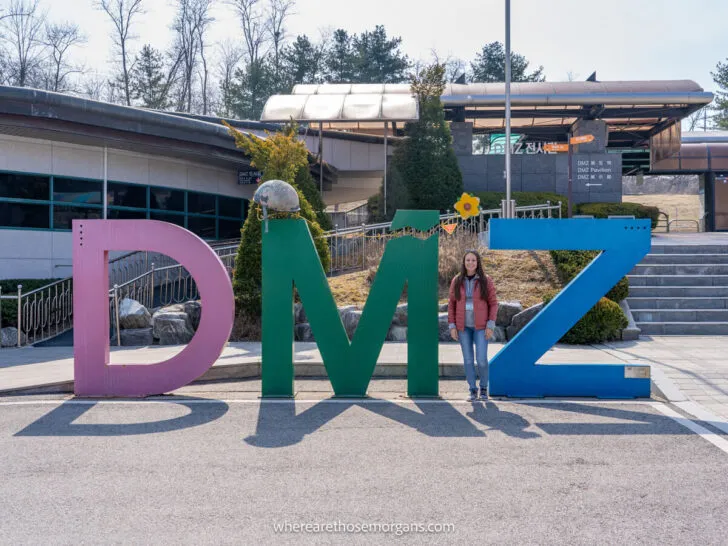
A typical DMZ tour includes Imjingak Park, the 3rd Tunnel and Dora Observatory . Most tours last 6-10 hours and you can choose additional options such as the gondola, suspension bridge or JSA. Our review will highlight the difference between each tour option so you don’t miss out.
In this guide, we’ll tell you everything you need to know about booking a tour of the DMZ including pros and cons from our experience.
Disclosure : We paid for our own DMZ tour and this is not a sponsored post.
Our DMZ Tour Experience
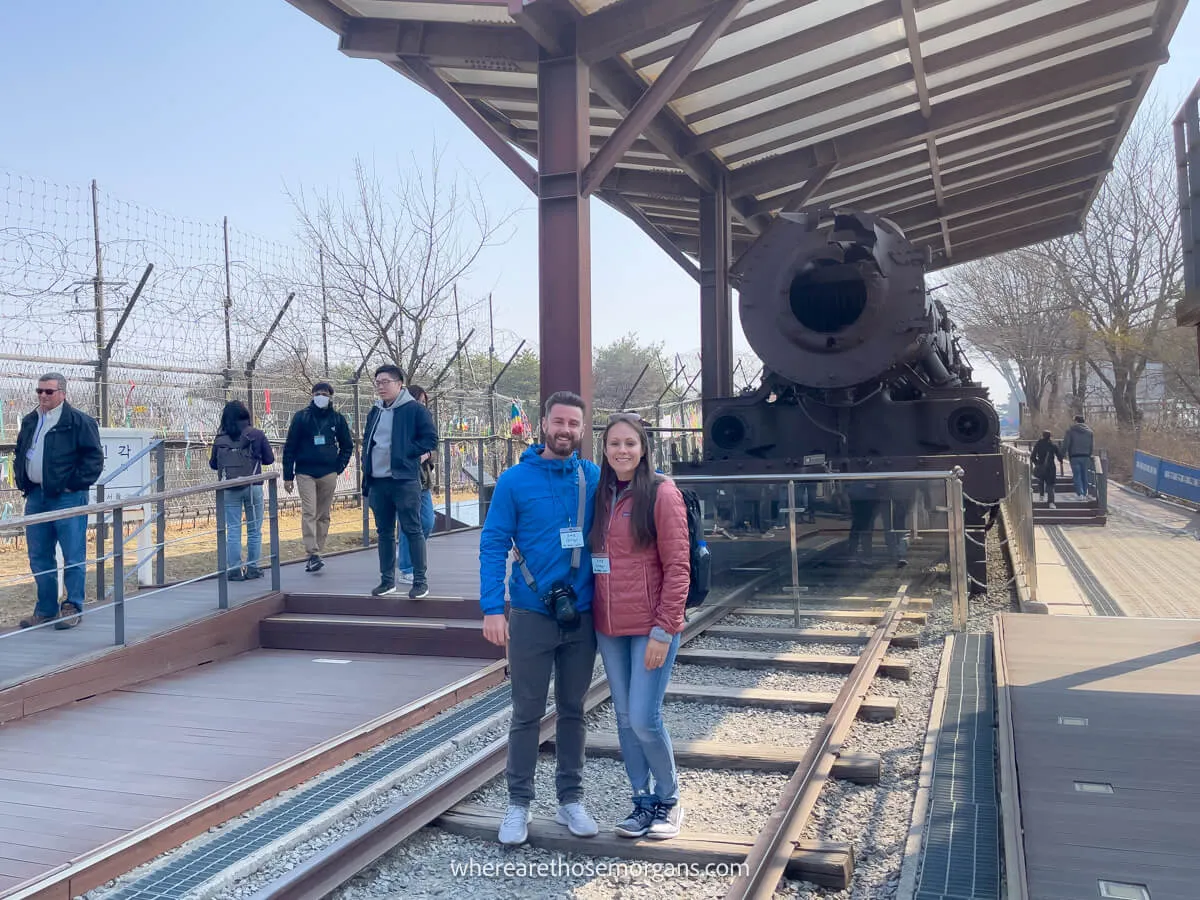
We spent 14 days exploring Seoul in March 2023 and during this trip, we personally went to the DMZ . Visiting the DMZ was at the top of our bucket list so we booked a tour for the first full day we were in Seoul. It was the best way to start our trip!
But we ran into a few problems during our tour . So our detailed and honest DMZ tour review will tell you everything you need to know including a step by step account of our experience. Depending on what you want to see, you might need to book a different tour and we want to help you make the most of your trip. Read more about us .
What Is The DMZ?
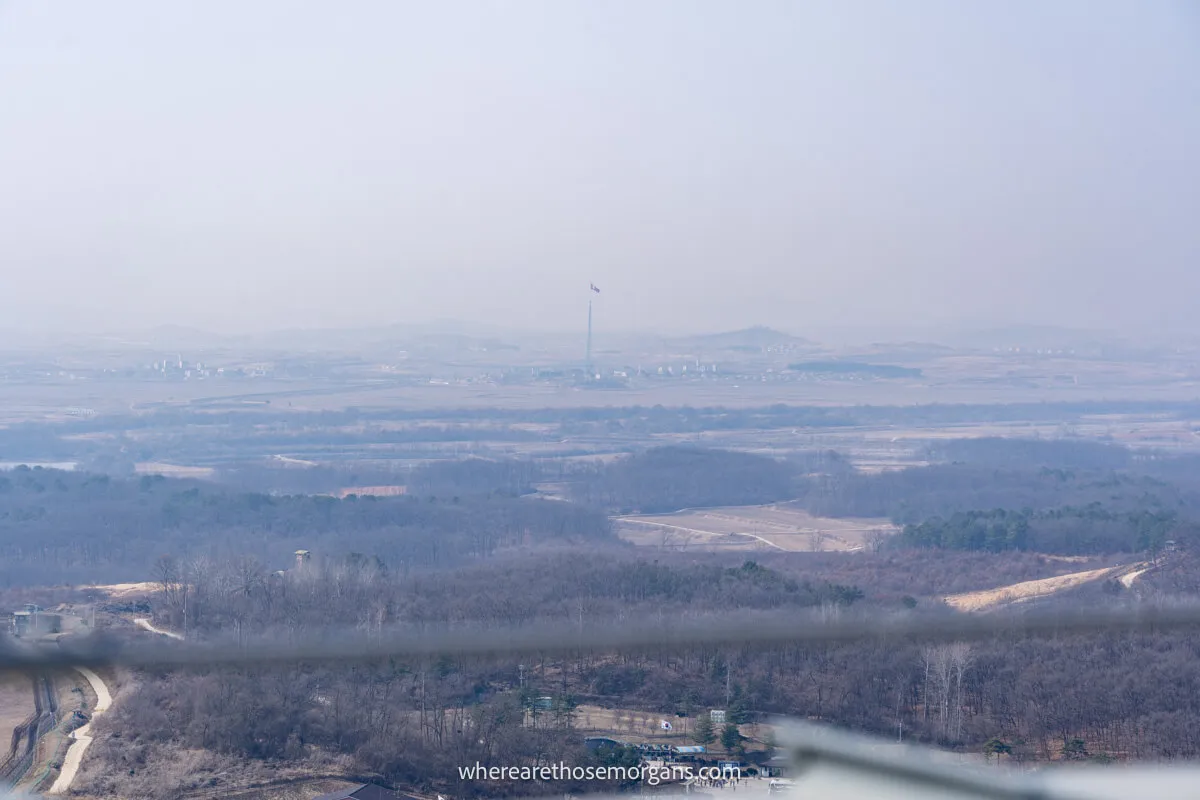
The DMZ or Demilitarized Zone is one of the most notorious and heavily fortified strips of land in the world running between North and South Korea. Additionally, the Military Demarcation Line (MDL) is the official land border between the two countries. On either side of the MDL, you’ll find the official DMZ area.
After the Korean war, an Armistice Agreement was signed on July 27th, 1953 formally ending the war. This was one of the longest negotiated armistice in history spanning over two years and 158 meetings. As part of this agreement, North Korea and South Korea were to remain separate and each country kept similar territories they occupied before the war.
Both the DMZ and DML were created from the 1953 Armistice Agreement. This buffer zone spans 4km wide and 250km in length along the 38th parallel between the two Korean countries . Soldiers from each county patrol their respective sides.
While the DMZ is one of the most heavily guarded borders on the planet, there is no threat to visitors or civilians. The DMZ is still considered to be an active war zone, but it has now become a place of peace and is safe to visit making the DMZ one of the best day trips from Seoul .
It’s also interesting to note, travelers with American and South Korean passports are not allowed to enter North Korea . So for many, a tour of the DMZ is the closest they will ever come to this very secluded and secretive country.
The Joint Security Area
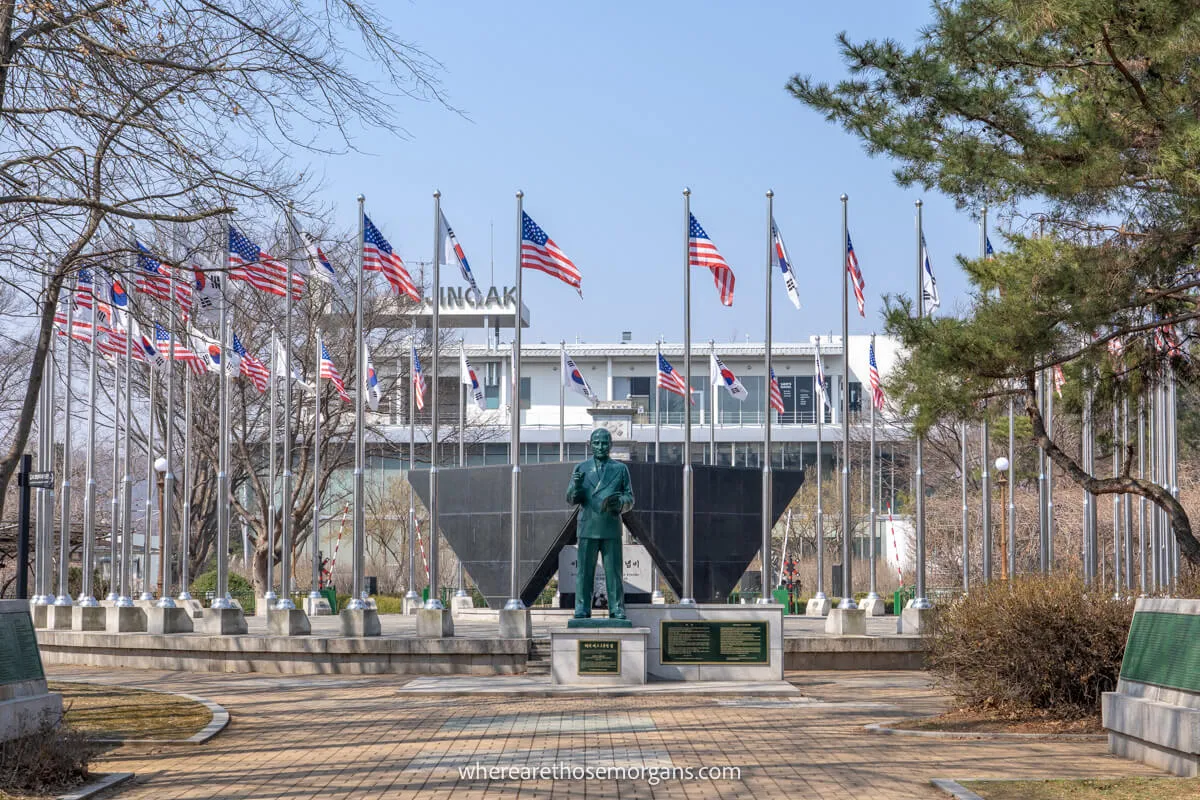
If you want to book a tour, you can visit both the DMZ and the Joint Security Area (JSA). Inside the Demilitarized Zone, you’ll find the former village of Panmunjom which is now known as Truce Village on the western coast of the peninsula along the Military Demarcation Line.
Located near this village, the JSA is the closest point to North Korea within the Civilian Controlled Zone . This is where North and South Korean soldiers stand face to face.
The JSA has several blue barracks that have historically been used for negotiations between the two nations. Supported by the United Nations Command Military Armistice Commission (UNCMAC), the JSA is now considered to be a neutral place. You can visit as part of a tour and visitors are allowed to enter one of the Military Armistice Commission conference rooms.
In 2019, Donald Trump was the first U.S. President to set foot on North Korean soil. He met with Kim Jong Un for about an hour and then both leaders stepped back into South Korean territory where they were greeted by South Korea’s President, Moon Jae-In . If you visit the JSA, you’ll be able to see where this historical meeting took place.
However, the JSA is heavily regulated by South Korea and the US military. Unfortunately, no visitors under the age of 12 can visit and there is a dress code in place. If you choose to visit the JSA, you’ll be given a 20-minute briefing by an American soldier outlining the possible dangers .
You’ll also be required to sign a waiver which absolves South Korea, the US and the UN if any incident arises. JSA tours were suspended last year in 2023 because a US soldier ran into North Korea during his tour and unfortunately, the JSA is no longer allowing tours.
Travel Tip : It might take at least 72 hours in advance to make a reservation if you plan to visit the JSA so if this is something you want to do, you will have to plan ahead.
Can You Visit The DMZ Without A Tour?
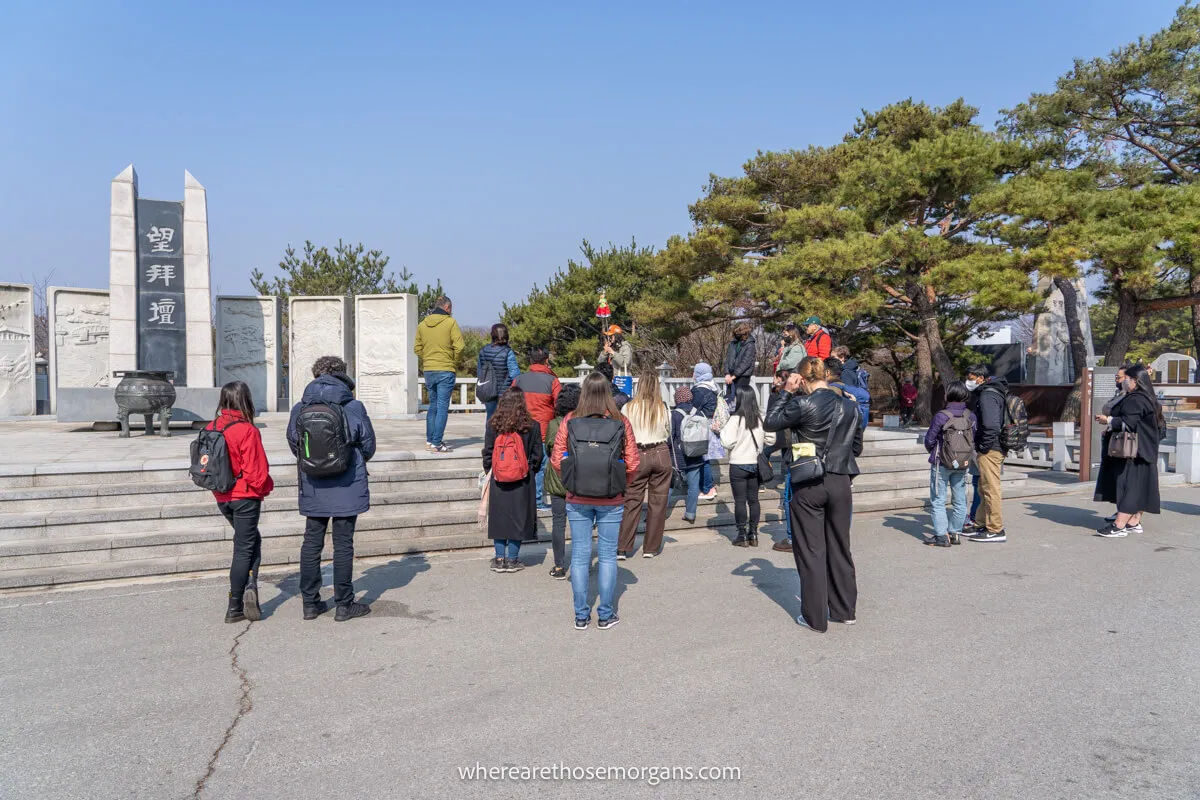
No, you can not go to the DMZ in South Korea without a tour and you must have a registered guide from an official tour company. However, you can visit Imjingak Park without a tour or a guide . This park is located just outside the DMZ and it also does not require any additional security screening to visit.
At Imjingak Park, you can ride a gondola over the DMZ line, see the Freedom Bridge, visit the National Memorial For Abductees, buy North Korean money and so much more. If you don’t want to take a tour of the DMZ, we’ll show you how to visit Imjingak Park on your own. However, we recommend you book a DMZ tour from Seoul to make the most of your South Korea experience.
READ : Best things to do at Imjingak Park
Should I Visit The DMZ Or JSA?
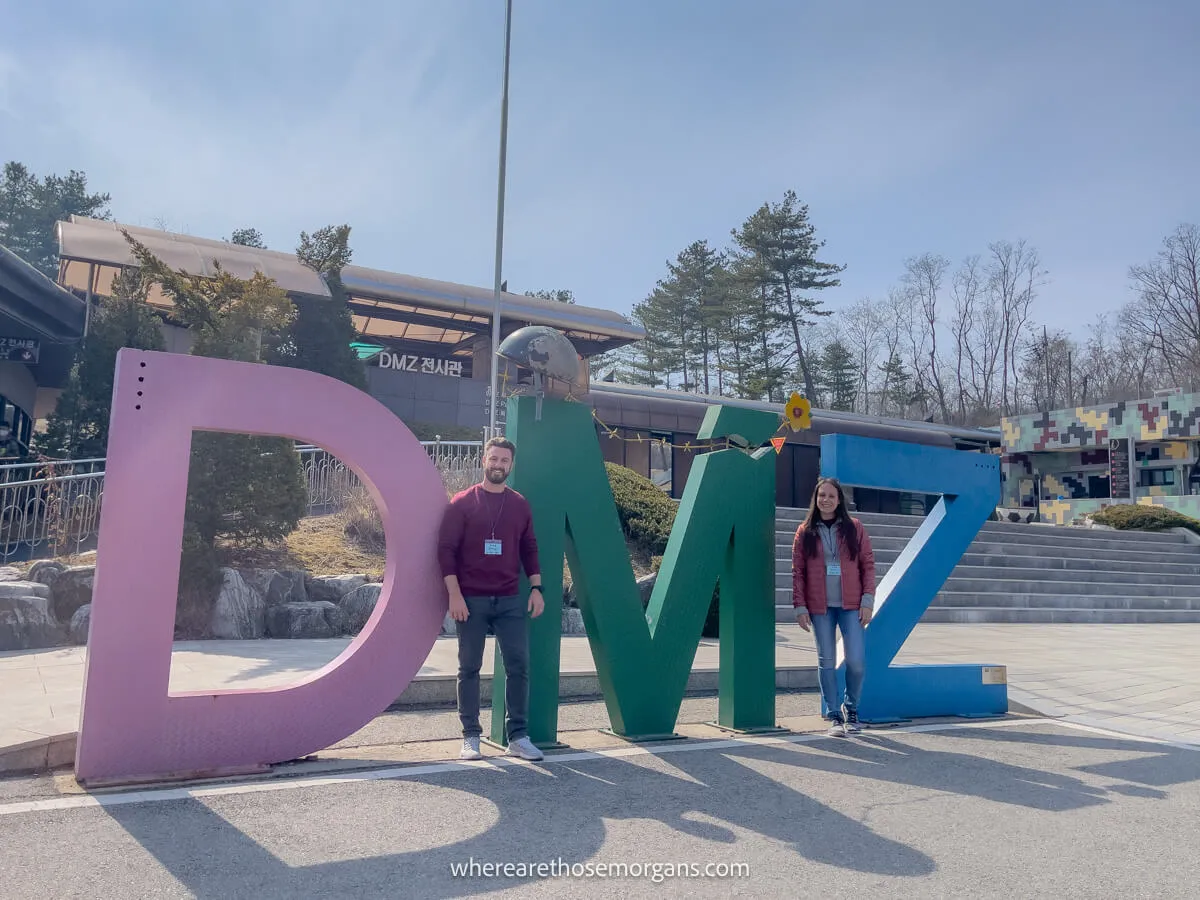
Because you can’t travel to the DMZ without a guide, many of the tours follow similar routes. However, the first decision you should make is whether you want to visit the DMZ, JSA or both.
If you choose the DMZ, you can expect to visit :
- Imjingak Park including Freedom Bridge
- The 3rd Infiltration Tunnel
- Dora Observatory
If you choose to visit the JSA, you can expect to visit :
- Camp Bonifas
- Freedom House
- Military Armistice Commission Conference Room
Then depending on how much time you have in Seoul itinerary, you can choose a half day or full day option . We chose a full day tour to the DMZ with Klook and had a great experience. Later in this DMZ tour review, we’ll give you a full walk through of our tour so you know exactly what to expect.
When we visit in March 2023, the JSA was still closed for tours due to covid, but it opened a few months later. However, the JSA closed once again in July 2023 because the US soldier ran into North Korea.
Personally, we chose the DMZ over the JSA because we wanted the best chance of being able to go on a tour . While both the DMZ and the JSA can close to tours, the JSA is a much more restricted area with high political tension so it’s often the first to close over the DMZ. If you book a JSA tour and it closes last minute, all DMZ tours might be fully booked.
Things To Know Before Booking
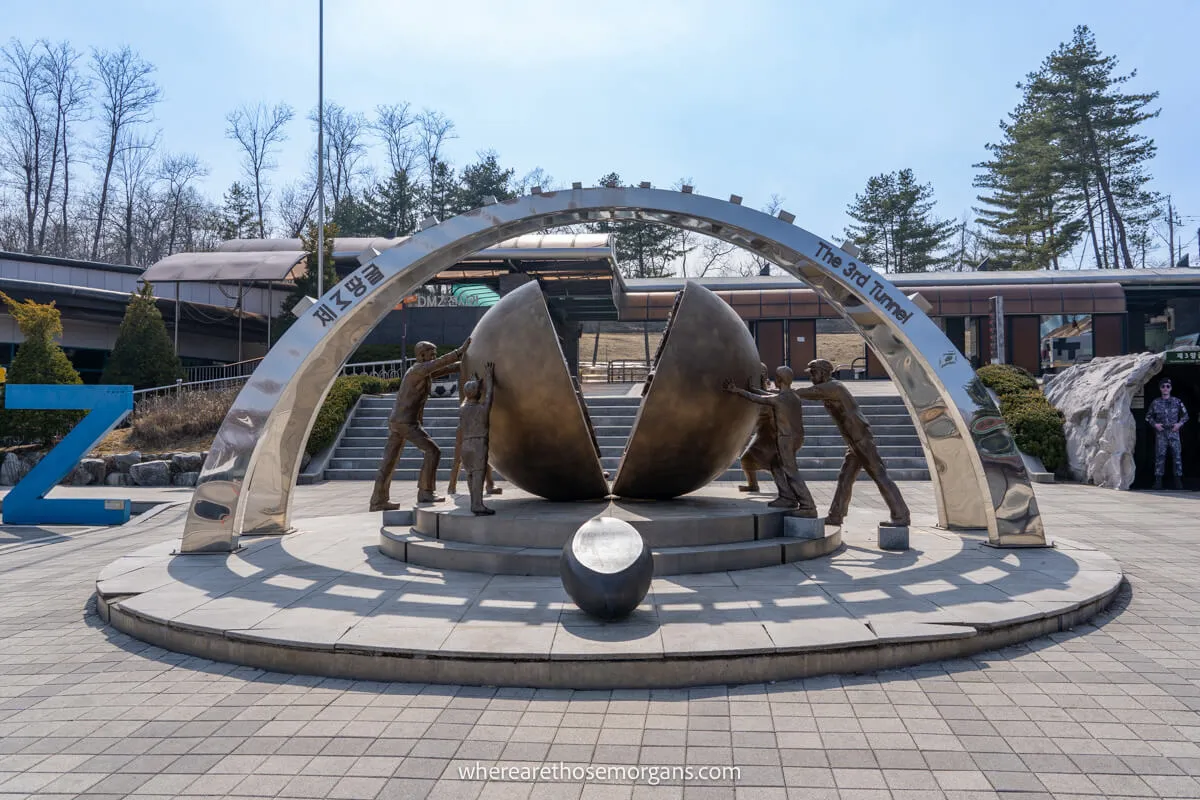
As we mentioned earlier, the DMZ and the JSA are active military zones so you can’t always expect a perfect tour. For example, the week before we took our DMZ tour, North Korea was carrying out missile testing so all DMZ tours were cancelled for a few days while this took place.
When we visited in March 2023, there was also a surge in tourism and the tickets for DMZ were extremely limited on a first come, first serve basis with timed entry. We had to move our tour time a few hours ahead to ensure we arrived early enough in the day to secure our tickets.
Travel Tip : Book your DMZ trip at the beginning of your Seoul itinerary so if your tour is altered for any reason, you have a few days of buffer room to reschedule if needed.
Two important things to know when booking your DMZ / JSA tour:
- You must bring your passport (or ARC, local Alien Registration Card for South Koreans)
- Dress code is important when visiting the JSA
Dress code is enforced at the JSA because North Korea has previously used photos of carelessly dressed tourists as propaganda suggesting how poor the rest of the world is to their citizens. So if you choose to visit the JSA, you’re not allowed to wear revealing or suggestive clothing such as:
- Ripped or faded jeans
- Sleeveless shirts or tank tops including a revealing midriff
- Shorts and miniskirts
- Clothing with military print
- Anything that could suggest your nationality (like a national flag)
- Workout gear
Overall, we found it best to dress appropriate yet casual. Keep in mind this is a geopolitical area so taking the time think about your outfit shows respect. If you’re fully covered and casually dressed, you’ll be fine for your DMZ tour.
Most Popular DMZ Tour Options
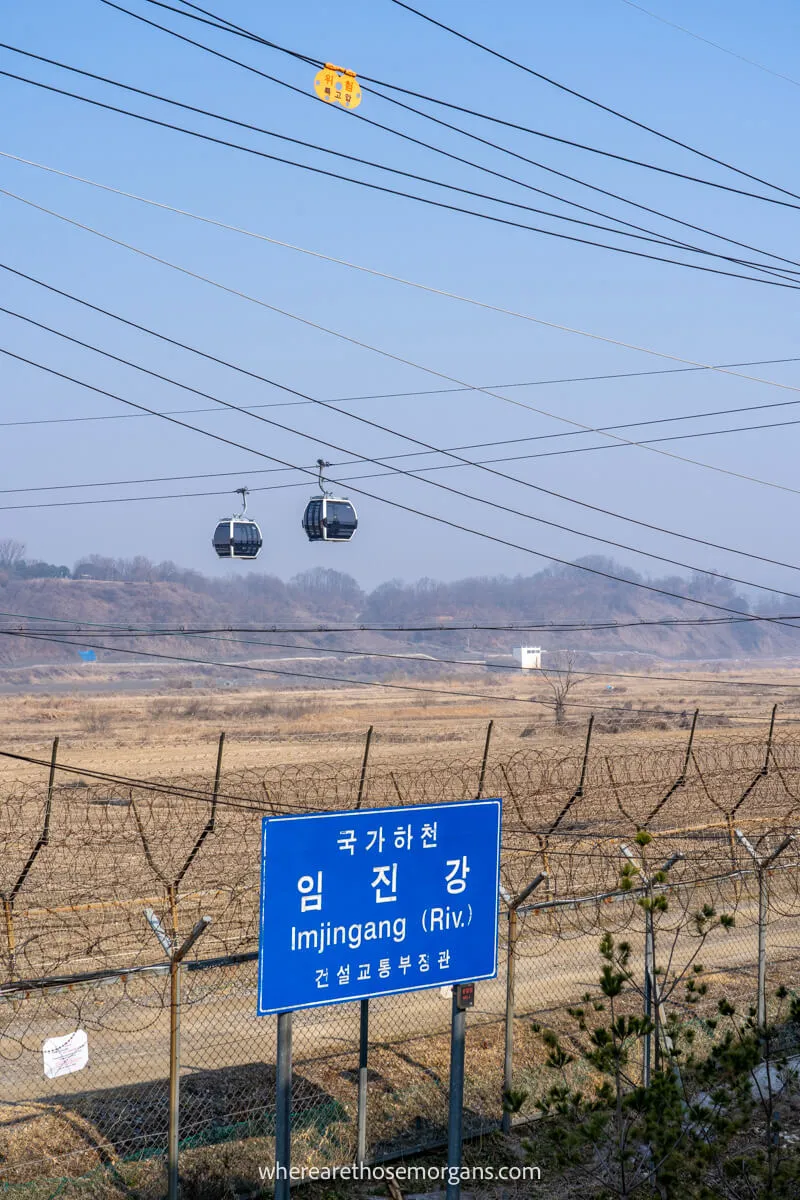
We chose to book our DMZ tour through Klook because they offer some of the best deals. Each tour company varies in cost depending on time of year so always check prices before booking.
- Demilitarized Zone (DMZ) Tour from Seoul – Chinese, English or Japanese speaking guide with admission to attractions and optional suspension bridge (this was the tour we booked).
- DMZ Adventure Tour – 9 hour tour with English or Korean speaking guide with suspension bridge and boat voyage
Get Your Guide :
- South Korea DMZ Tour Option – Half or full day tour option with I LOVE SEOUL TOUR including an English speaking guide
- From Seoul: DMZ Guided Day Trip – Another half or full day tour option (6-9 hours) with Seoul N Tour and English speaking guide
- Korean Demilitarized Zone (DMZ) Tour – 6 hour tour with SEOUL CITY TOUR CO. including Tongilchon-gil, the unification village
- Private DMZ Tour Option – Experience a 9-10 hour private tour including Gamaksan Chulleong Bridge or Majang Lake
JSA Options :
- DMZ JSA with VIP Travel – Limited seats and may sell out quickly
- Paju JSA + DMZ One Day Bus Tour – A very popular option by Klook
- JSA Tour with Viator – Sometimes unavailable so check before your trip
Booking Tip : Make sure you carefully read the description for each tour option and it includes what you want to see.
Our DMZ Tour Walkthrough
Even if you choose to visit both the JSA and DMZ, you’ll visit most of the places we did during our tour. The main difference is you’ll have less time at each location . Here is what we experienced on our full day tour (8:00am – 6:00pm) of the DMZ:
1. Booking And Tour Departure Times
The tour we booked with Klook offered an 8:00am or 10:00am departure time. We chose the 10:00am time slot. But we learned to be flexible because we received a phone call and text from our tour guide the day before asking if we could start earlier in the day at 8:00am.
Unfortunately, when we visited Seoul, the DMZ was still working on a limited number of tickets per day on a first come first serve basis. So we potentially would not get tickets if we arrived later in the day . Our tour started around 8:00am and we were picked up by private car in front of our Seoul hotel. The driver was hilarious and he dropped us off at the bus where everyone else was waiting.
2. The Bus Ride
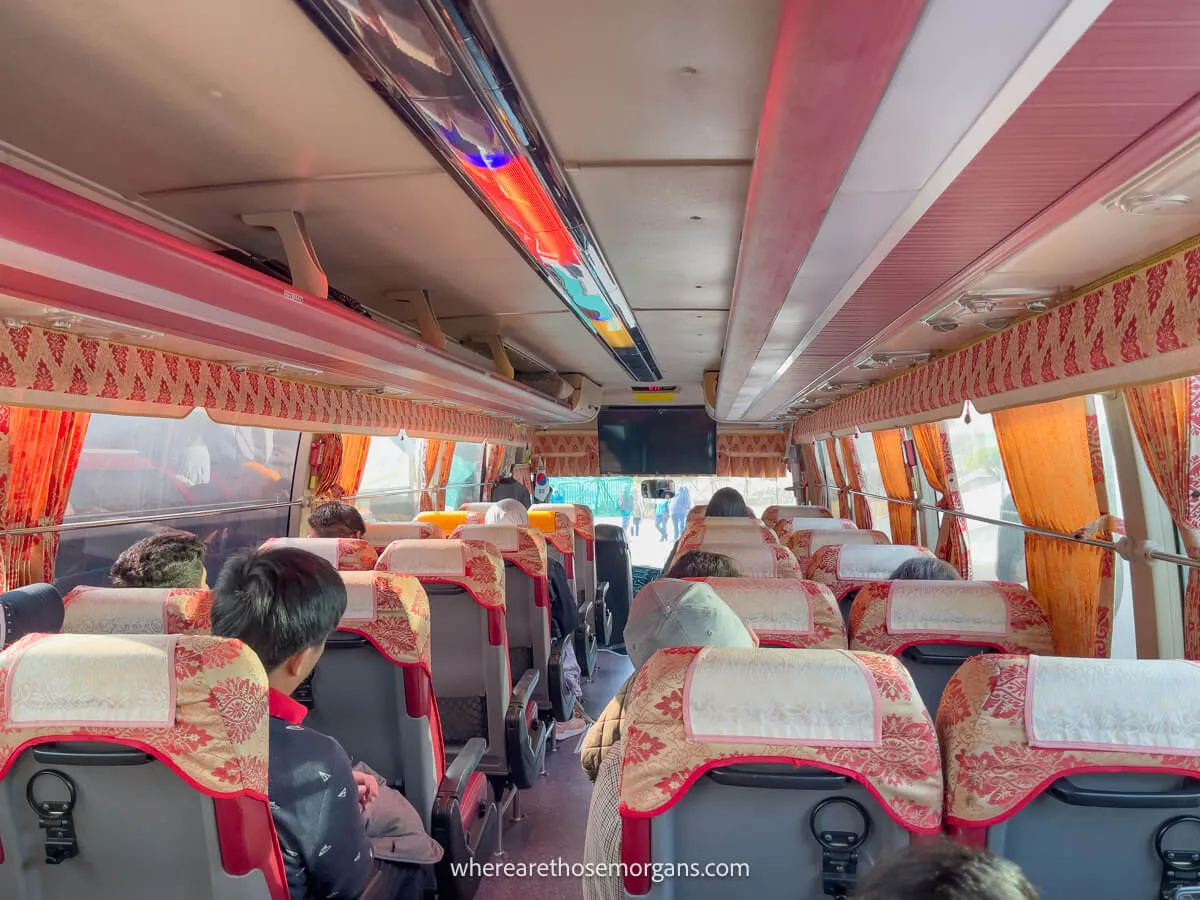
Our DMZ tour group met outside Hongik University Station . Once everyone was accounted for our tour guide, Spring , introduced herself and told us about the plan for the day. Because the DMZ was limiting tickets due to an influx of visitors, she had to secure the tickets and this was her first priority when getting to Imjingak Park.
The bus ride from Seoul to Imjingak Park was about 1 hour and 30 minutes with traffic. During the drive, Spring spoke about numerous things including the history of South Korea, what we could expect for the day and the current situation at the DMZ.
Travel Tip : Your passport is required to visit the Third Infiltration Tunnel and the Dora Observatory.
3. Imjingak Park
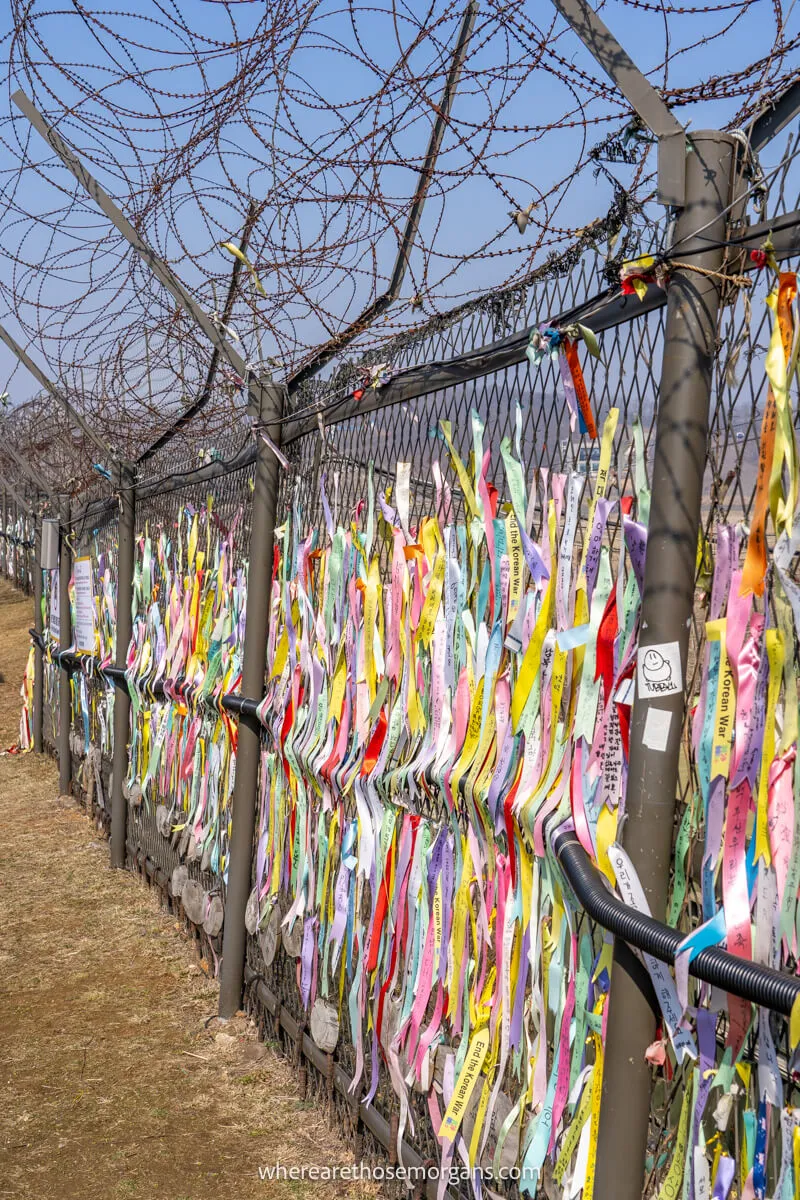
Once at Imjingak Park, Spring got in line for our DMZ tickets and we had a little bit of time to look around the area ourselves. If you’re hungry, there are many food options including a few local stalls, Dunkin Donuts and burgers.
Luckily, Spring secured our tickets and our entry time for the DMZ was 12:00pm . So we had an additional few hours to explore Imjingak Park which was not part of the original itinerary. This was actually a blessing in disguise because we now had a few hours to see as much as possible. Spring led us around to several of the important areas and explained their significance.
We then had more free time to visit the rest of the park on our own. Personally, we thought Imjingak Park was worth visiting and to see everything, you’ll need at least a few hours. We recommend you read our guide featuring the best things to do at Imjingak Park before your visit.
4. Freedom Bridge
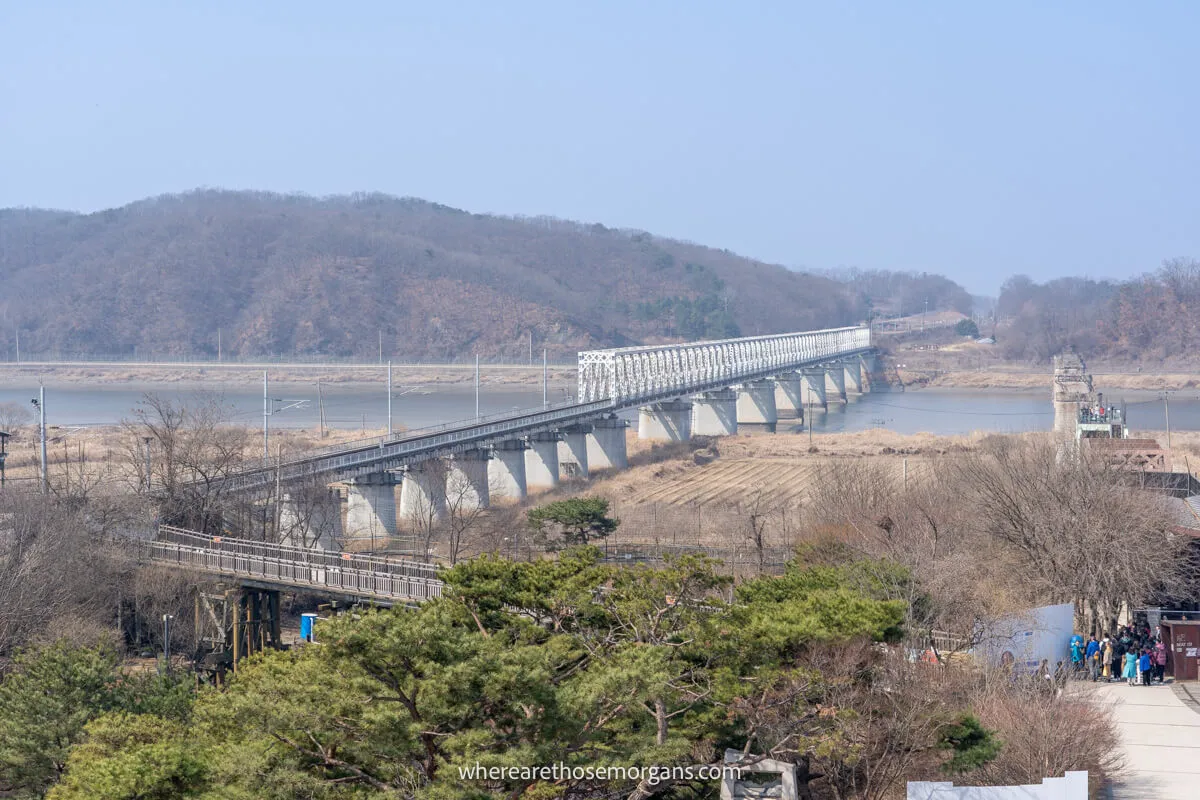
The Freedom Bridge is one of the most important symbols found at Imjingak Park. However, you won’t be able to cross it because you can only see it from a distance. This bridge was built in 1953 for the temporary purpose of exchanging 12,773 Prisoners of War (POW) from the Korean War between North and South Korea.
During this time, the POWs crossed the Freedom Bridge on foot after arriving to the bridge of the Gyeongui Line via motor vehicles. And today it represents the tragedies from the war.
5. The 3rd Infiltration Tunnel
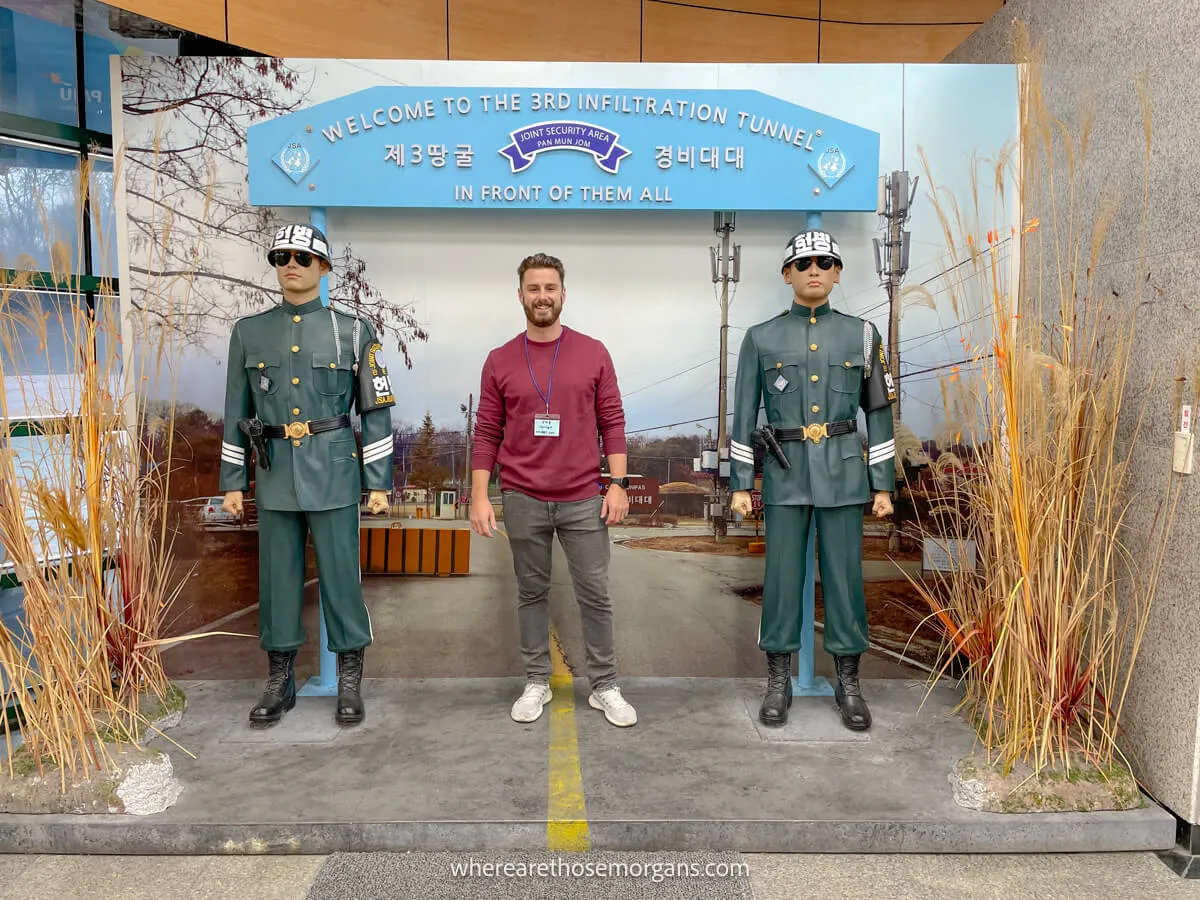
The next stop on our DMZ Korea tour was the 3rd Infiltration Tunnel and we thought this tunnel was the most interesting part of the entire tour . Sometimes also known as the Third Tunnel of Aggression , this is one of four known tunnels under the border between North and South Korea and it’s located about 50 km (~30 miles) from Seoul.
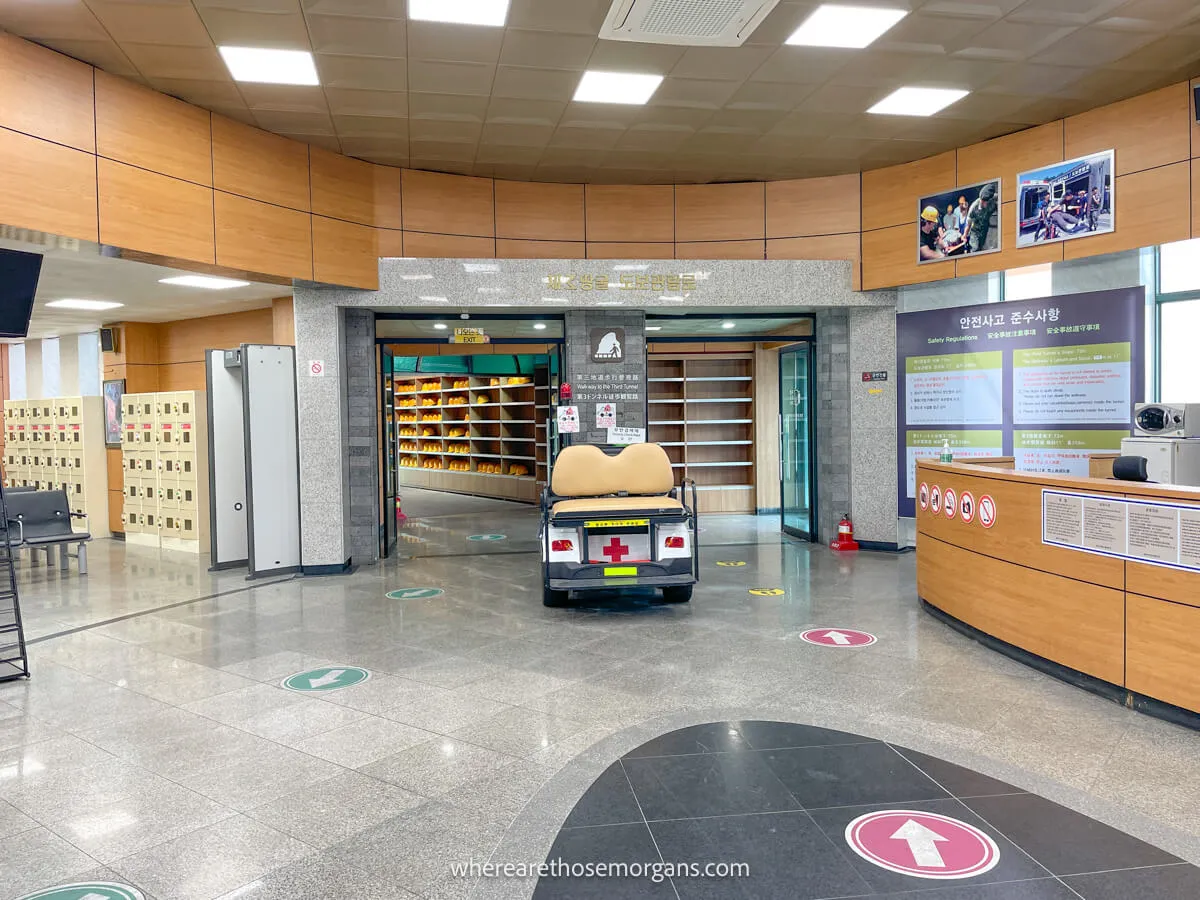
The 3rd Infiltration Tunnel was built by North Korea for a surprise attack on Seoul . This underpass could accommodate about 30,000 men per hour including weaponry. Discovered by South Korea in 1978, the 3rd Tunnel spans 1,635m in length, 2m in width and 2m in height.
During a DMZ tour, you’ll be able to walk a portion of the 3rd Tunnel . It’s a very steep incline down into the tunnel, but it has railings for support and it’s lit extremely well.
Travel Tip : There are no photos allowed in the 3rd Tunnel and you’ll be asked to leave your belongings in a locker including your phone. Please respect the rules and don’t take any photos.
6. Dora Observatory
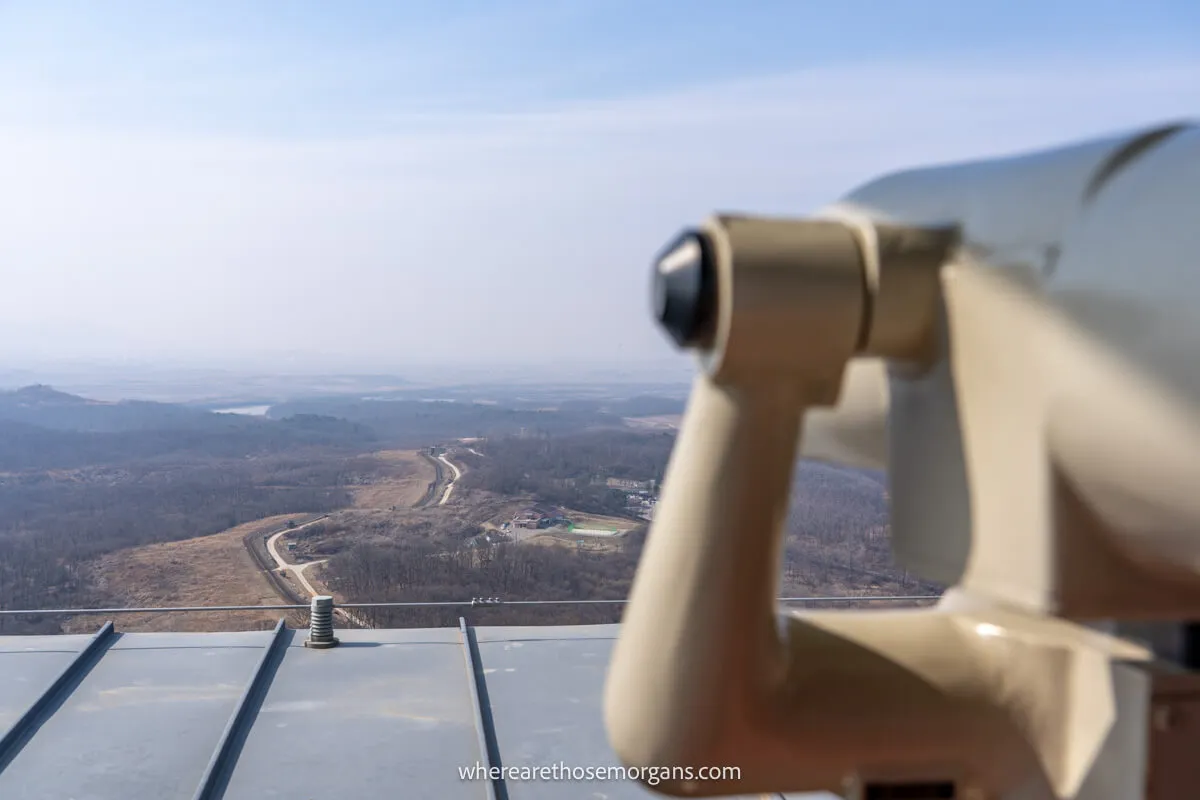
After the 3rd Infiltration Tunnel, we headed to Dora Observatory. Sitting on top of Dorasan (Mount Dora) in Paju and first opened in 1987, the observatory allows visitors to see the North Korean propaganda village as well as the city of Kaesong. This is where you’ll get to see panoramic views of the Demilitarized Zone using binoculars from the top of Dora Observatory.
We had fun playing with the tower viewers where we could easily see regions of North Korea including the flag flying high in the sky from a nearby village. This is also your chance to snap a selfie with North Korea in the background!
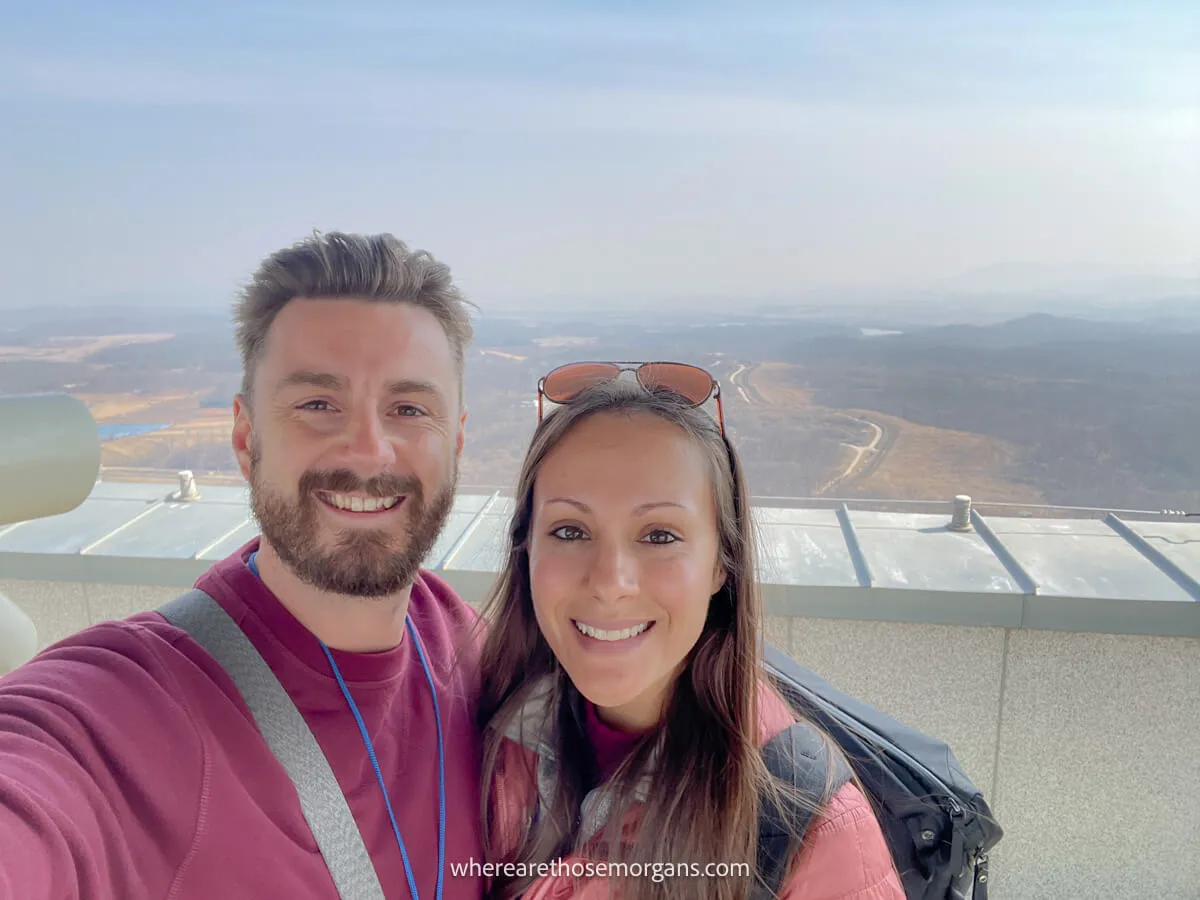
7. DMZ Souvenir Shop
The last stop on our DMZ tour was a souvenir shop and it lasted for about 15 minutes. However, this wasn’t a forced shopping experience and you could choose to stay on the bus. It was a good place to buy products such as wine, chocolate and ice cream which are produced only in the DMZ area. If you’re looking for a unique gift to take back home, this might just be it.

8. Bus Ride Back
On the bus ride home, our entire tour group was pretty tired from the long day. We were back on the road about 4:00 pm so it was almost 6:00pm by the time we arrived back in Seoul . The bus ride home was much more quieter compared to the morning. We also hit a little bit more traffic heading back into the city.
The Morgan Conclusion
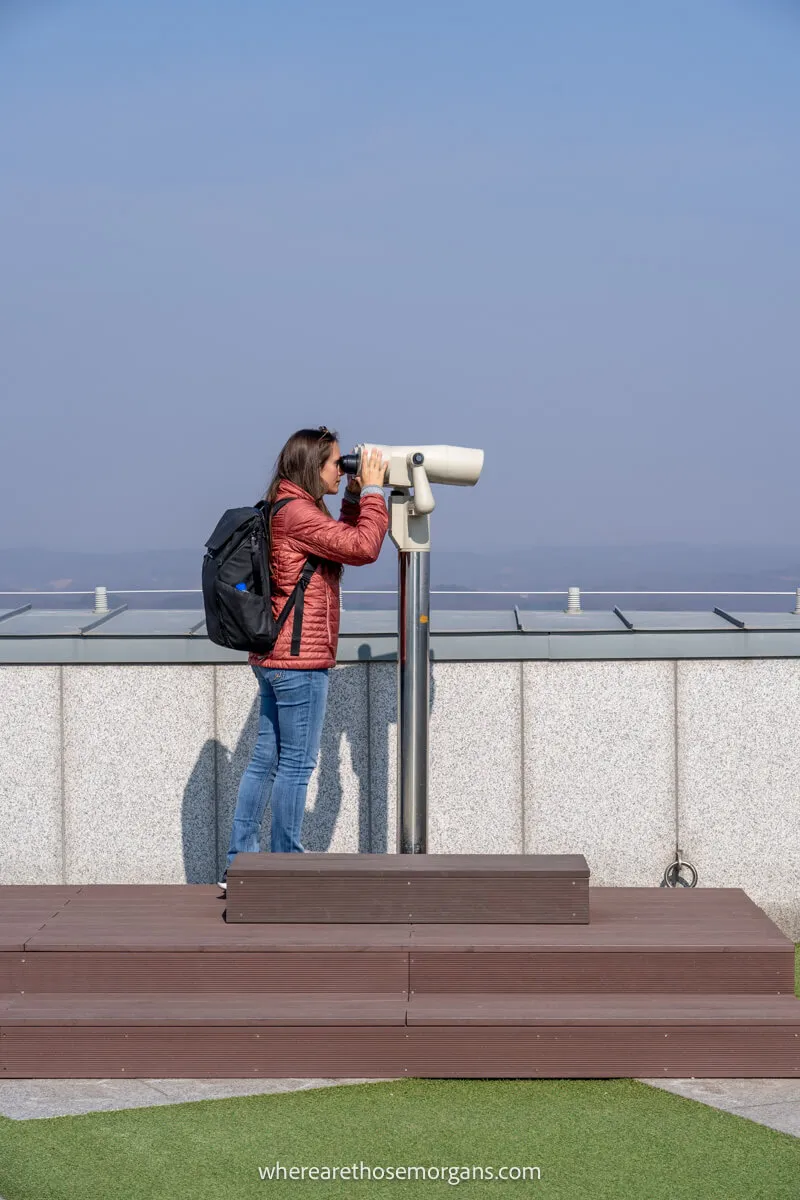
The DMZ is one of the few places in the world where visitors can experience first hand what a Cold War era looks and feels like . It’s a great reminder that we need to continually build peace wherever we go. It’s also the only place on earth where you’ll get to see a glimpse of North Korea through binoculars.
So is a DMZ Tour worth it?
Yes, the DMZ tour near Seoul is absolutely worth it because it’s one of the most fascinating places we’ve ever visited . A tour gave us a great perspective about the current climate of South Korea as well as the opportunity to learn about the history between North and South Korea. Personally, we think taking a DMZ tour is something any first time visitor to Seoul must experience.
Here is what we liked and didn’t like to help sway your decision:
- We had a very knowledgable tour guide and learned so much
- Ability to see places we couldn’t visit ourselves
- Tour bus provided so we didn’t have to worry about our own transport
- Left alone to explore Imjingak Park
- Affordable day trip option
- Tours may be cancelled last minute
- Having to wait for a tour time (unknown amount)
- The JSA has age restrictions for children
We learned so much about South Korea from our DMZ tour, we couldn’t learn elsewhere. Sometimes you need to experience things to better understand them for yourself. Our tour showed us the walls which easily separate democracy from communism still exist today and this is more important than ever as we look to the future. This tour is a very eye opening experience.
Our DMZ Tour Photos
We took many photos during our DMZ tour and this review wouldn’t be complete without sharing some of our favorites!
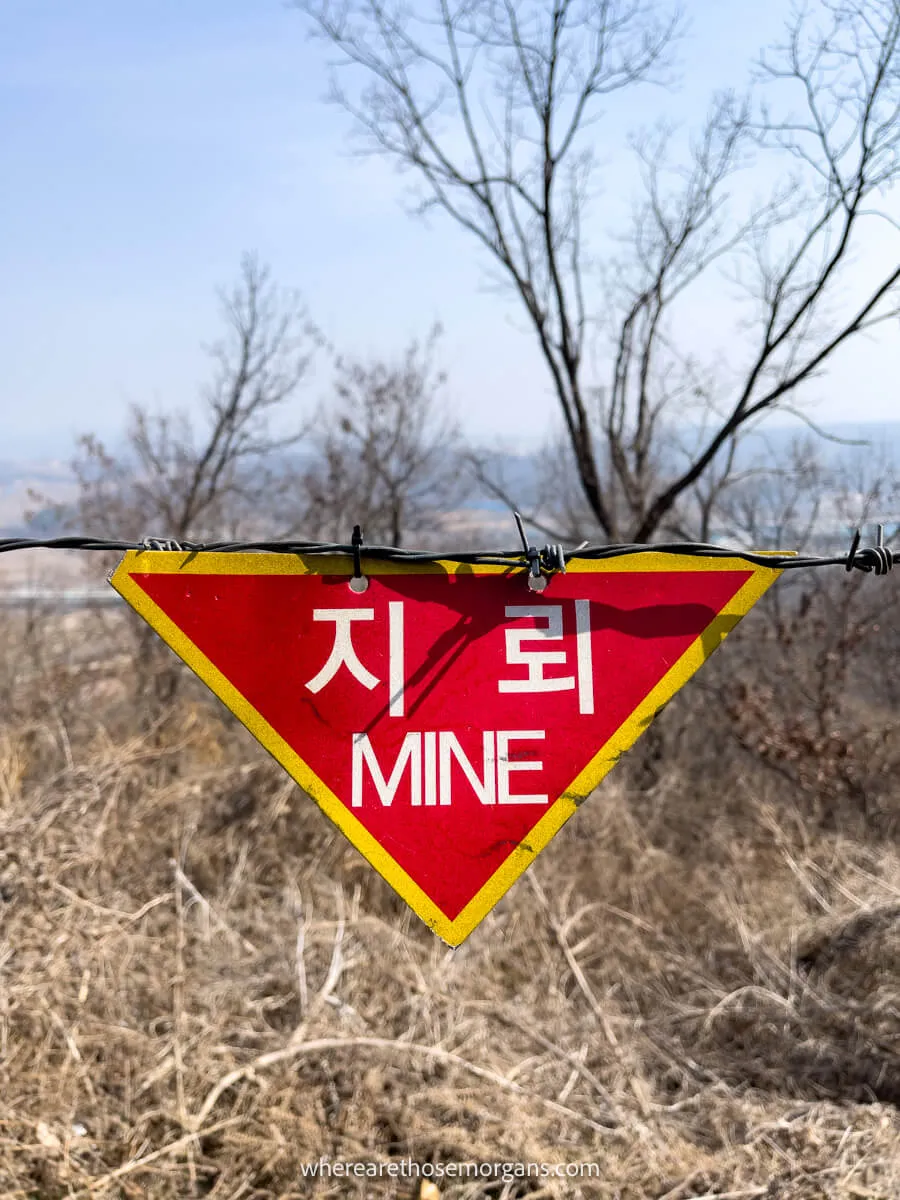
Our Seoul Guides
- 46 cool things to see in Seoul
- Best things to do at Imjingak Park
- How to visit Seoul Sky Observatory
- Guide to visiting N Seoul Tower
- How to visit Gyeongbokgung Palace
- Things to do inside Changdeokgung
- Unique things to see at Huwon Secret Garden
- Best palaces in Seoul to visit
- What to see at the Jongmyo Shrine
- How to visit the Seodaemun Prison
- 20 best hotels in Seoul South Korea
Want more Seoul content? Head over to our South Korea Travel Guides to explore the very best of Seoul and beyond.
We hope this detailed review about our DMZ tour helps you decide if this attraction should be included on your Seoul Itinerary!
Please let us know if you have any questions about the South Korea DMZ tour or traveling through Seoul in the comments below.
Happy Travels ,
Mark and Kristen
Enjoy this DMZ tour review? Pin it for your trip!

Note : This article contains affiliate links. When you make a purchase using one of these affiliate links, we may earn a small commission at no extra cost to you.
All Rights Reserved © Where Are Those Morgans, LLC. Republishing this article and/or any of its contents (text, photography, maps, graphics, etc.) in whole or in part is strictly prohibited.

Mark and Kristen Morgan are travel, hiking and photography experts. Over the last 6 years traveling full time, they have explored more than 40 countries and 30 US states.
Where Are Those Morgans has been featured in USA Today, Gestalten, Get Your Guide, CityPASS and Condé Nast Traveler along with various other publications. Read more about us .
Share this article!
South Korea: Visiting the DMZ
Just 30 miles north of seoul, this buffer zone lets you peep into north korea and explore the history of the divided peninsula.

Prayer ribbons tied to the fence between North and South Korea.
So, what exactly is the DMZ?
The Demilitarized Zone is where history's only communist dynasty nudges up against its capitalist neighbour. You remember the South Korean president, Moon Jae-in, and North Korean leader Kim Jong-un holding hands? That was here, at a landmark summit in April 2018. Physically, the DMZ is a 2.5-mile-wide no-man's land that runs 155 miles across the peninsula. It's been in place since the Armistice Agreement was signed during the Korean War in 1953, and remains heavily guarded by soldiers from both sides.
Sounds kind of dangerous.
Although you might feel a frisson of tension, it's pretty safe for tourists. Guides run through dos and don'ts (where and when to take photos, for example) — it's best to do as they suggest.
Will do. And apart from barbed wire, what's there to see?
Most tours from Seoul start with a bus journey to the Dora Observatory, a hilltop, camouflage-painted blockhouse with views across the DMZ into the North. Through binoculars you can see residents of Kijeong-dong (often called the 'Propaganda Village') working in the fields while children in white shirts and red neckerchiefs march off to school. There's also the 'Third Tunnel', an unfinished invasion tunnel that was being dug by the North Korean military when it was revealed to the South by a defector in 1978. Remember to wear the hard hat you're given — you're almost certain to bang your head on the low ceiling and the scaffolding holding it up.
Noted. Anything else?
The Joint Security Area, at the village of Panmunjom, is where North and South come face to face on the line that divides them. This is the most tense part of the tour, when guides hand over control to stern-faced soldiers who deliver a reminder of the rules — including not provoking the North Korean guards, just a few paces away. You can enter the blue huts that sit astride the frontier, and cross into the North Korean side of the room.
And how do I get to the DMZ — can I go it alone?
Unfortunately not — you have to go with a travel company. Tours are extremely popular though, and can get booked up weeks in advance. Also, not all tours go to every site within the DMZ, so select your tour based on what you want to see. Companies that'll take you there from Seoul include DMZ Tours , Tour DMZ , and Viator .
Did you know?
Effectively untouched for more than six decades, the DMZ has become a haven for wildlife that once thrived throughout the Korean Peninsula. It's home to deer, bears and countless other species; there have even been reported sightings of the endangered Amur leopard.
Follow @NatGeoTravelUK
Published in the South Korea guide, distributed with the November issue of National Geographic Traveller (UK)
- South Korea
- Travel and Adventure
Roaming Around the World
Travel Guides, Tips, and Tales
The DMZ Train: How To Travel from Seoul to North Korea Border
September 22, 2018 By John Widmer 60 Comments
It may sound like a crazy proposition to venture into what is a buffer zone to a lingering war. Yet while roaming around South Korea, we were intrigued by the possibility to visit the Korean Demilitarized Zone (DMZ) between North Korea and South Korea.
DMZ tours are actually somewhat of a popular pursuit for curious travelers in South Korea. Yet instead of taking one of the many DMZ-bound tours directly from Seoul, we wondered if it was possible to travel from Seoul to the DMZ without a tour.
That’s when we learned about the DMZ train .
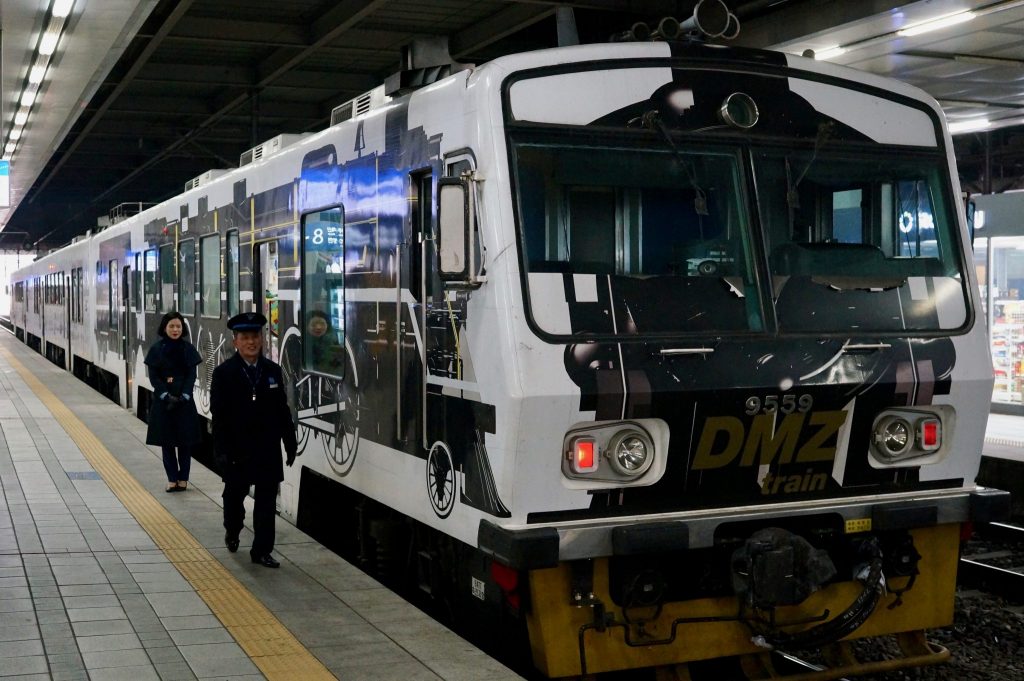
Turns out, you can take a trip out to the DMZ on your own by catching a train from Seoul.
There is an official DMZ Peace Train that runs directly from Seoul to DMZ, Wednesdays through Sundays. This special train to the DMZ began operating in 2014 and continues making trips out to the North Korea border today. Once arriving by train into the DMZ, you must then transfer onto a planned bus course to fully experience and explore the many sites within this heavily restricted area.
So that’s exactly what we did!
This post now recounts this DIY day trip on the DMZ train and reviews the details of exactly how to get from Seoul to the DMZ with public transportation. We’re always looking for the best values in travel and we found this DMZ train to be the cheapest way possible to reach the notorious demilitarized zone from Seoul.
So what’s it like to ride into the DMZ by rail?
The DMZ train turned out to not only be a very interesting trip, but also the most bizarre rail journey we’ve ever taken !
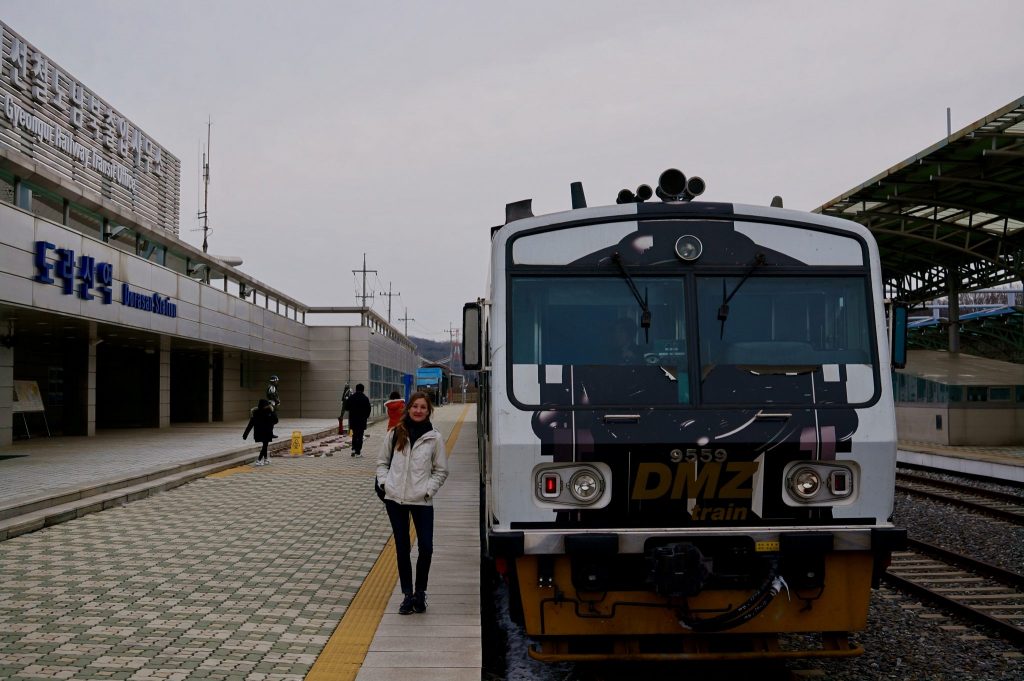
Even as we stepped foot onto the train, we realized this would be a strange journey ahead . Adorning the DMZ train walls are an odd mix of symbols, showing peace along with harsh signs of war. For example, an empty military helmet is surrounded by words like “harmony.” It’s all quite a contrast that sets the tone for the journey ahead.
The entire day in the DMZ was filled with this odd mix of war and peace. There were laughable oddities intermixed where horrible tragedies have played out. The DMZ is part war zone, but also part tourist attraction .
These perplexing contradictions were themes that ran on throughout the entire day. The DMZ is a weird place in the world and taking the DMZ Train from Seoul to the North Korea border perhaps made it all the more odd of an experience.
DMZ Train from Seoul to North Korea Border
To prepare for this rail adventure to the DMZ, we made sure to dress accordingly for the day straddling the North Korea border. There’s a strict dress code at the DMZ . Attire such as ripped jeans or skimpy outfits is not permitted here.
The reason for this goes beyond a simple show of respect. It’s been reported that North Korea films DMZ tourists on the other side of the border. The purpose of this is to use such footage of people in poor apparel as propaganda to show how inferior the world is outside of North Korea. So that’s why it’s important to dress up a bit while at the DMZ.
We made sure to dress the part. Our journey on the DMZ train was during a cold early-January day in Seoul, so it was an effortless task to ensure we were covered up. With winter jackets on and our passports in hand, we set off to Yongsan Station for this DMZ train day trip!
When we arrived at the station to take the DMZ train, we were literally the only people who boarded . The empty train car made us a little nervous and uneasy, as we chugged toward the North Korea border.
What the heck were we getting ourselves into? Where was everyone?
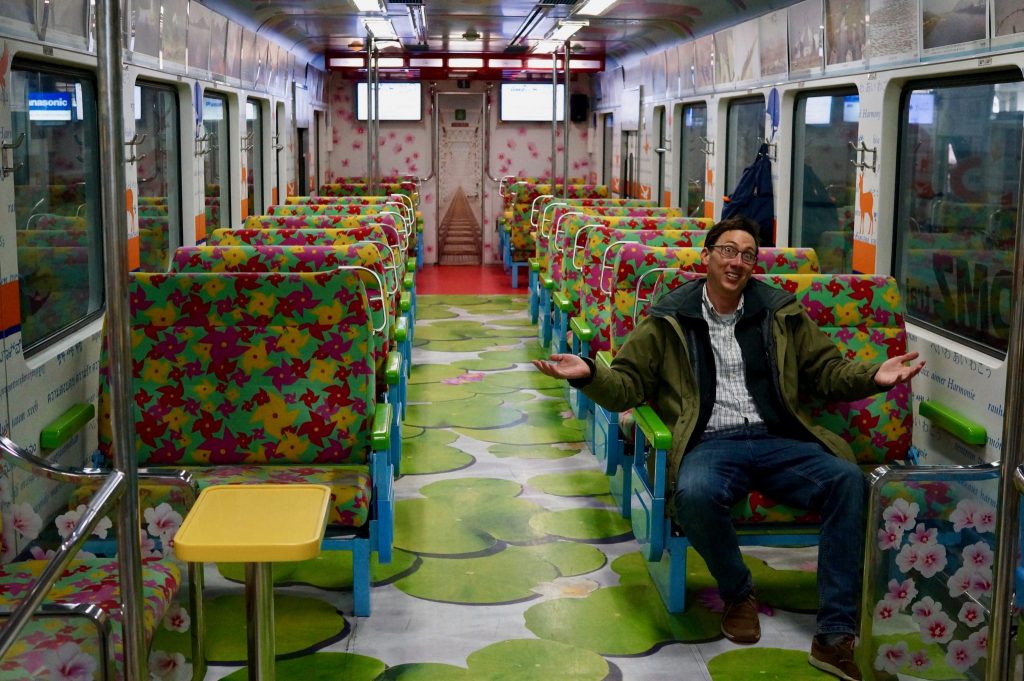
Perhaps the empty train car was due to people not knowing about the DMZ train, as most DMZ-bound visitors opt for tours directly from Seoul.
We also suspect the lack of passengers may have partly been due to heightened tensions during the time of our visit. It was around this time of escalations in early 2018 when a North Korea soldier had recently defected, while Trump and Kim Jong-Un were trading insults about who has a bigger button.
It sure was an interesting time to take the DMZ train!
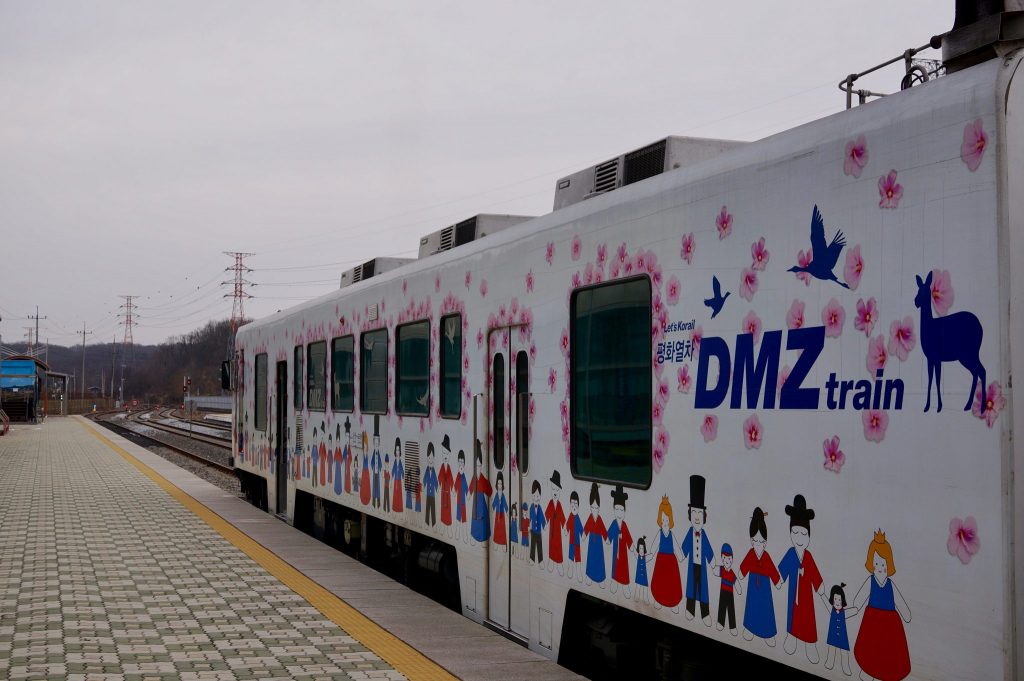
But as we write this post now, tensions have eased significantly to a point that peace negotiations are even resuming between the two Koreas. It’s all encouraging positive signals of peace between North and South Korea. Who knows, maybe one day in the not-so-distant future the train line will continue all the way through the DMZ, from Seoul to Pyongyang by rail. That is what the Gyeongui Line was intended for after all.
As our northbound rail journey continued, we were relieved to see a few more passengers board the DMZ train at the next stop. When arriving at Seoul Station, it was an almost entirely local Korean crowd joining us on the DMZ train.
This trip to the DMZ by rail was an intriguing travel curiosity for us to explore. Yet for the other Korean passengers venturing North, the journey to their country’s border holds much more weight.
After leaving Seoul Station, it was a nearly direct route on the DMZ train without stops. The highrises of Seoul soon faded, as the Gyeongui Line tracks wound through the Korean countryside.
Taking the DMZ train was a pleasant yet uneventful rail journey that lasted a bit more than an hour. But once we neared North Korea, that all changed.
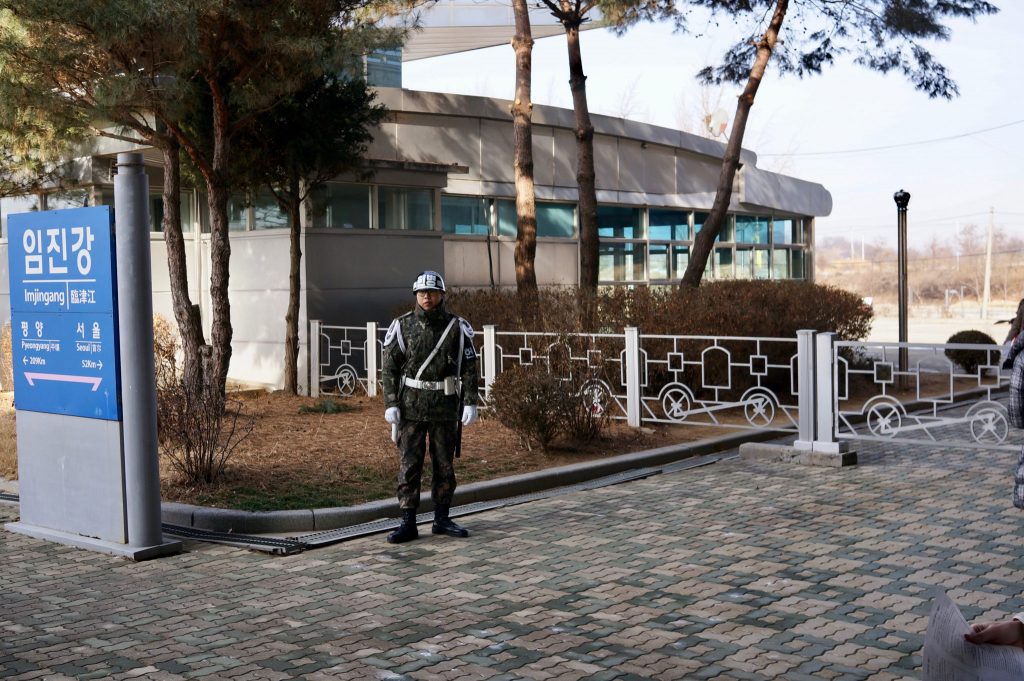
We arrived at Imjingang Station. This is the final train station before entering the DMZ. The Imjingang Station was formerly the final stop on the Gyeongui Line before the DMZ train began allowing visitors to go beyond it, once it began operating in 2014.
Before arriving at Imjingang Station, we were required to complete an application to gain entry. But given our inability to read Korean, we had no idea what we were agreeing to .
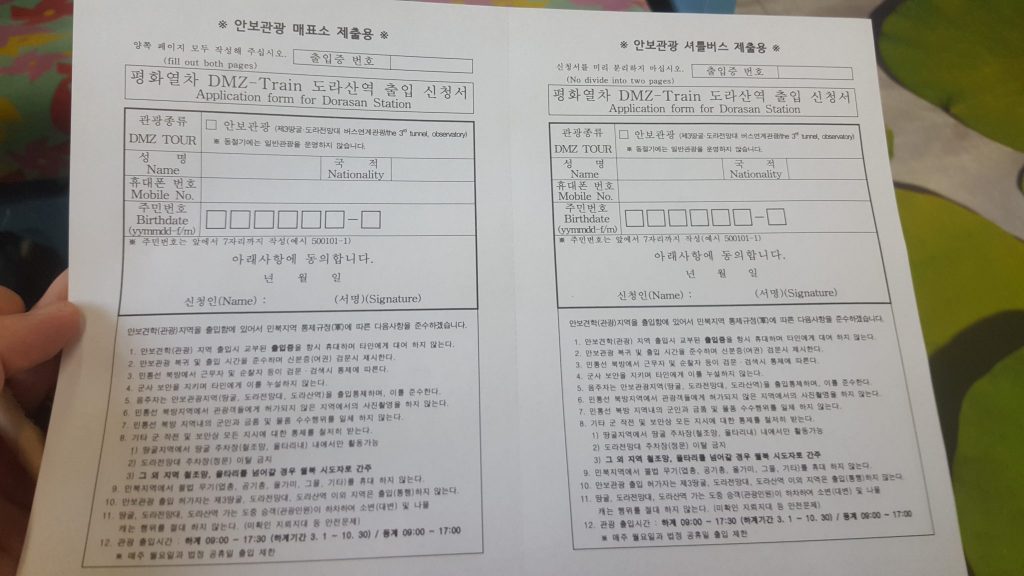
We signed anyways and stepped off the train with our passports in hand.
We waited in a short queue at this military checkpoint and were processed in as if we were entering another country. But this DMZ train to North Korea stops just short of the border with North Korea. So there are no immigration procedures or passport stamps issued.
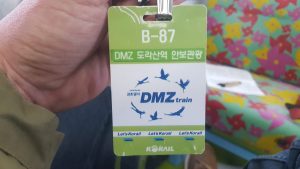
This is when the train actually enters the civilian-restricted area known as the demilitarized zone (DMZ), which separates North and South Korea.
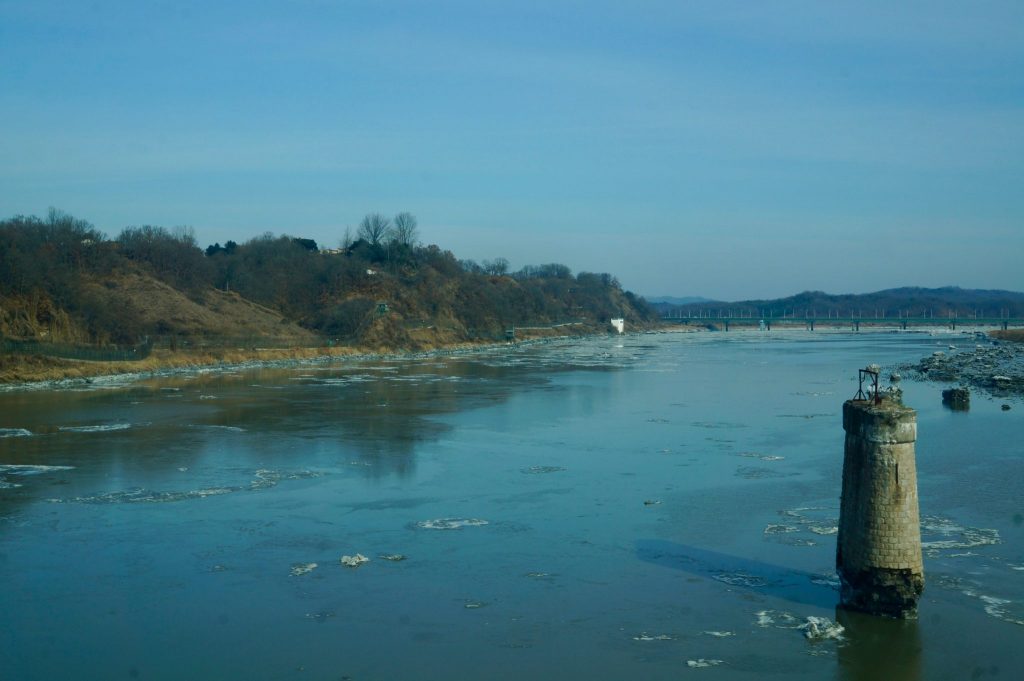
The train crosses the Imjin River and the train’s big windows allow passengers to watch this transition unfold, as it slowly travels on a bridge over the river. It’s eerie to see remnants of the former bridge that had been destroyed during the Korean War .
The prevalence of barbed wire fencing and minefields is a clear indication that we just entered a war zone .
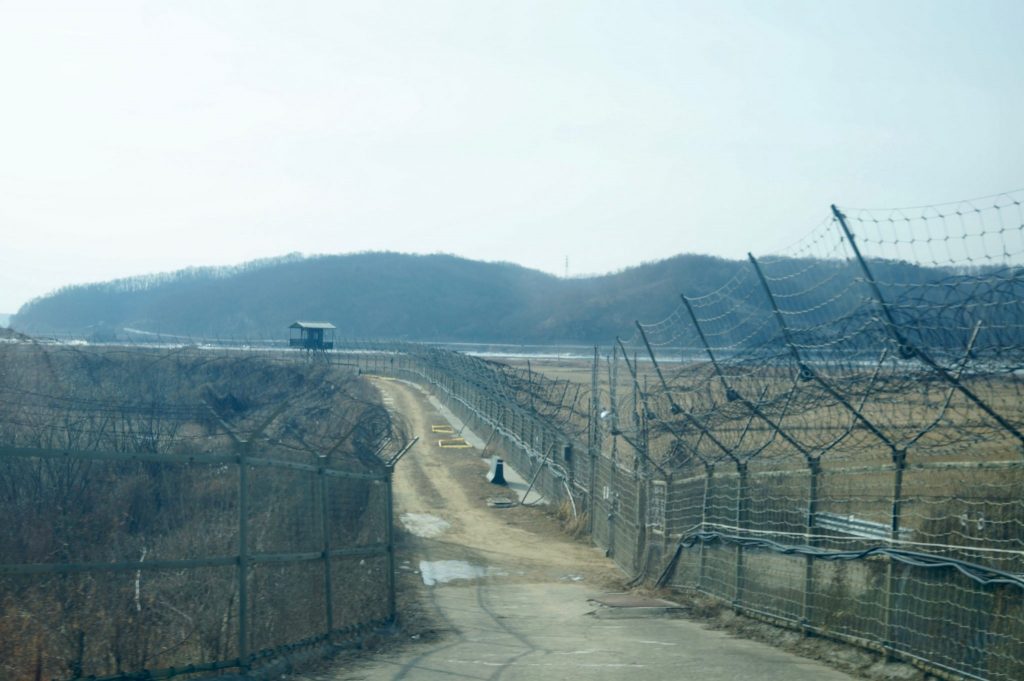
Dorasan Station: A Train Station To Nowhere
The final destination aboard the DMZ train is Dorasan Station.
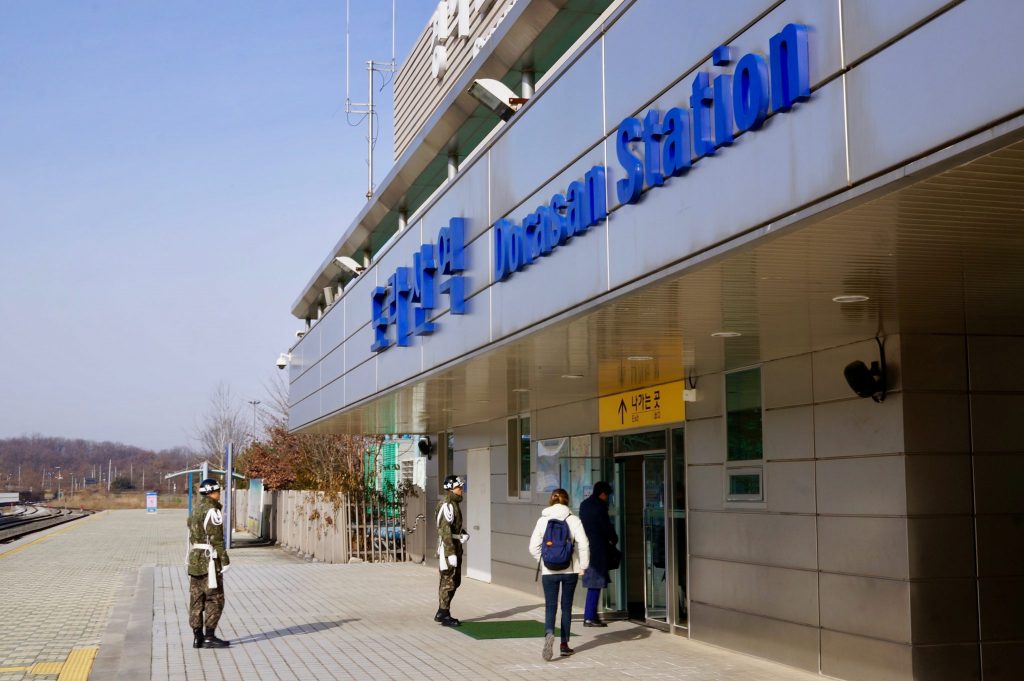
So we disembarked the DMZ train to explore Dorasan Station, which is an oddity on its own merits. Many of the DMZ bus tours even stop at Dorasan Station because it is a point of interest on their tours. Yet for us, it was our departure point arriving on the one and only train that currently pulls into Dorasan Station nearly every day. This little-used train station sits a bit more than a mile from the actual border of North Korea. We were close!
Given this is the only arrival each day, Dorasan Station sure is a large and grand station.
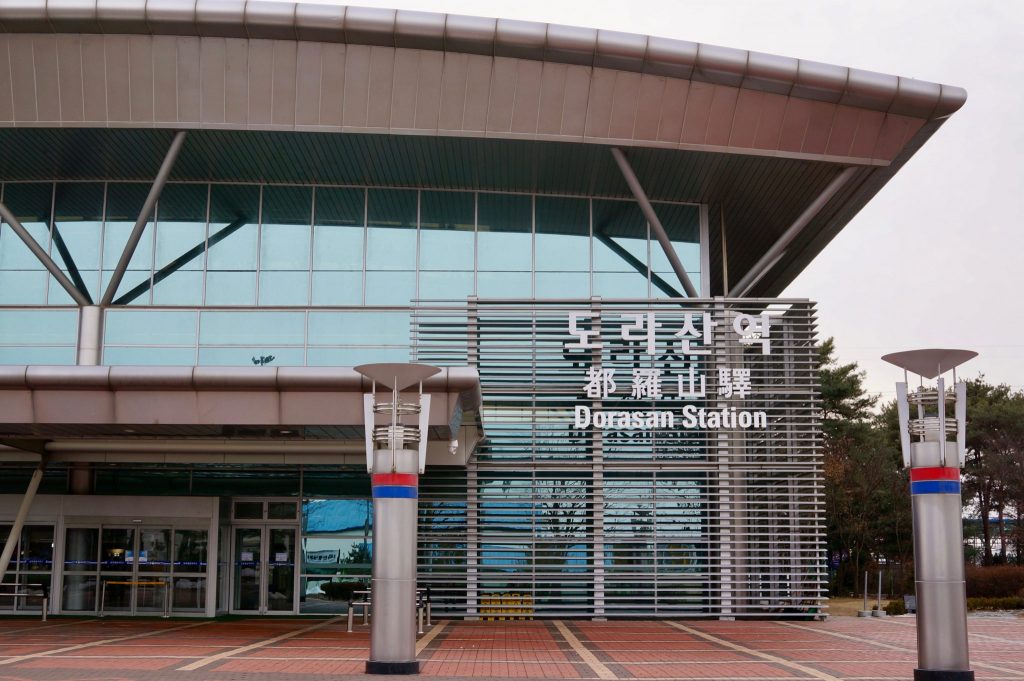
Dorasan Station was constructed in the early 2000s and the rail lines actually do connect North Korea and South Korea . But, of course, the border remains closed today. There have been some freight trains between the two Koreas that have been permitted to pass on occasion. But there are absolutely no passenger trains in South Korea that can continue on to North Korea.
Dorasan Station is the final stop. As a result, this big and immaculate station remains largely symbolic rather than a functional transit point between North Korea and South Korea.
Yet there are visions of Dorasan Station to one day link North and South Korea by rail. With Seoul located 56 kilometers to the South and Pyongyang 205 kilometers to the North, perhaps one day a train between the two Koreas’ capitals may be a reality. Upon peace between the two feuding nations, unification by rail and otherwise is the dream.
Having North Korea and South Korea connected again by trains may not be so far off. Dorasan Station actually appears completely ready for the next departure to Pyongyang .
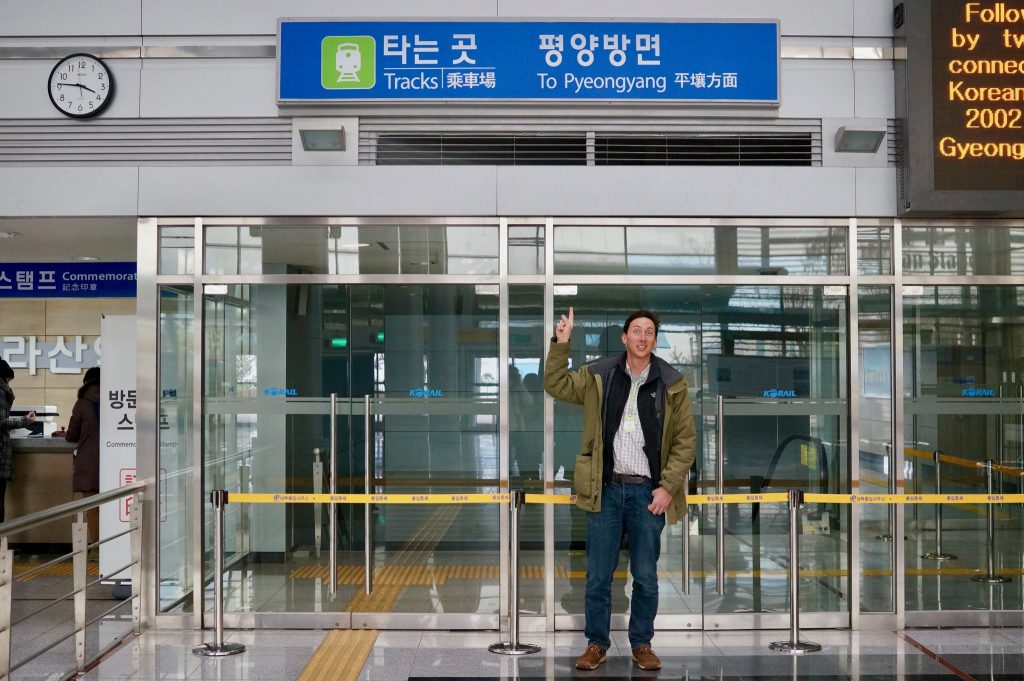
The station is part propaganda, which makes a bold statement. Yet it shows South Korea’s clear vision and readiness for unification.
There’s an empty arrivals hall, a full customs & immigration area, and even an Inter-Korean transit office.
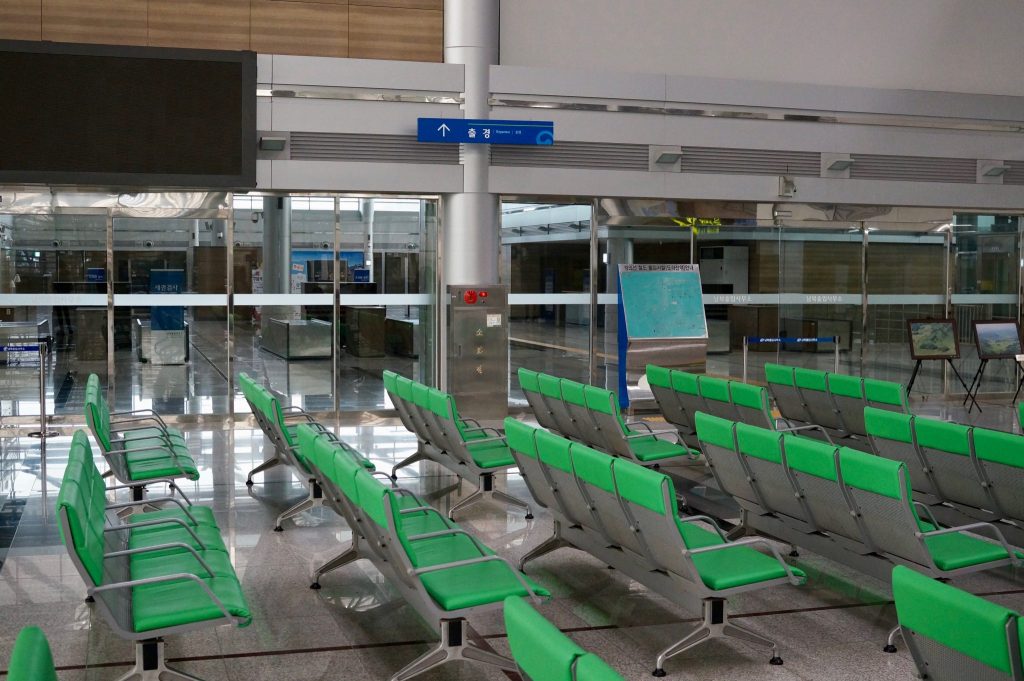
South Korea appears all set to resume passenger service to North Korea. It looks as if it could begin operation for train service to North Korea tomorrow if needed. Dorasan Station proudly flaunts that this infrastructure is in place.
While it may be the last station from South Korea, many signs throughout Dorasan Station acknowledge it’s “ the first station towards the North. ”
Exploring the Demilitarized Zone: from Train to Bus
From Dorasan Station, passengers are not permitted to tour the various sites throughout the DMZ on their own. So we transferred onto a bus that is timed perfectly to connect with the DMZ train.
This special bus for DMZ train passengers goes on to visit many curious sites scattered throughout this buffer to war. The alternative is to hang around Dorasan for five hours, when the DMZ train returns back to Seoul. Therefore, everyone from the DMZ train takes the bus.
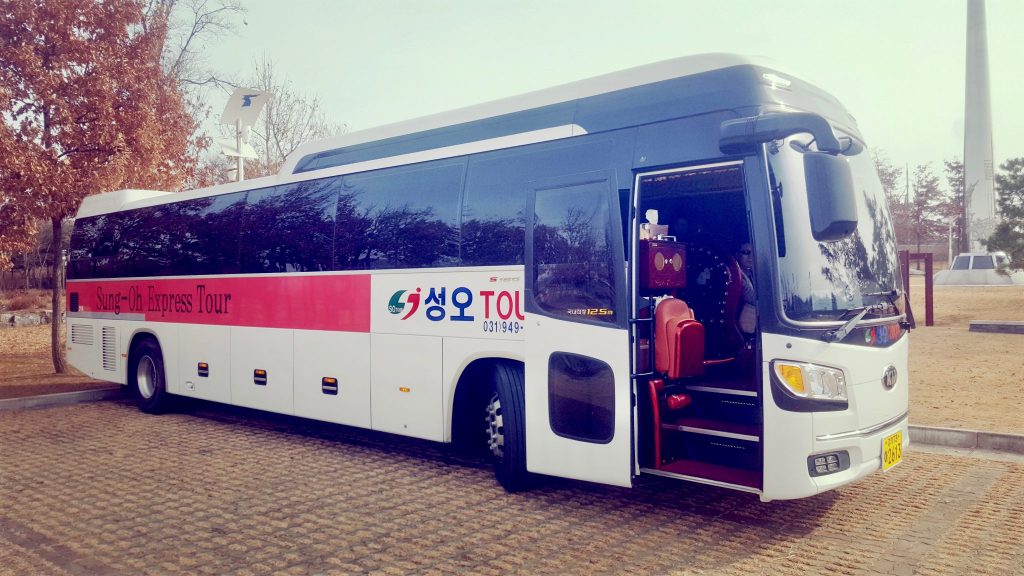
This bus is timed to connect with the train and the bus tickets are easily purchased while on the DMZ train. From Dorasan Station, the bus includes four stops throughout the DMZ:
- Dorasan Peace Park
- lunch stop at a military cafeteria
- Dora Observatory, and
- 3rd Tunnel of Aggression + the DMZ Pavillion Museum.
Dorasan Peace Park: A Curious Park Full of Hope and Oddities
Our first stop was the Dorasan Peace Park. This park, completed in 2008, was developed to help youths better understand the history of the DMZ. Funded by donations from people living in the local area, the park is chock full of a strange assortment of curiosities!
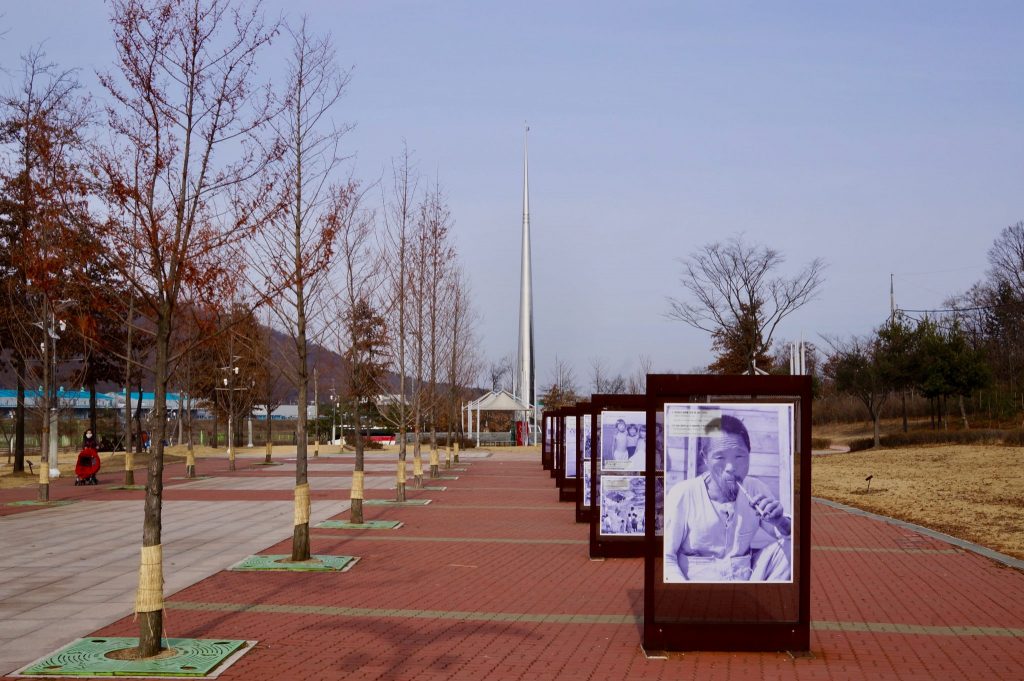
There are sculptures, history plaques, a small ecology museum showing the DMZ’s wildlife, decommissioned army tanks, an enclosure with deer, a tall looming cone tower, a frisbee golf course, a look-out point, and even something called the Paul McCartney Forest to commemorate the former Beatles singer’s first concert in South Korea.
Who knew you could play a round of frisbee golf amongst killing machines in the middle of a “peace park” inside this war zone?
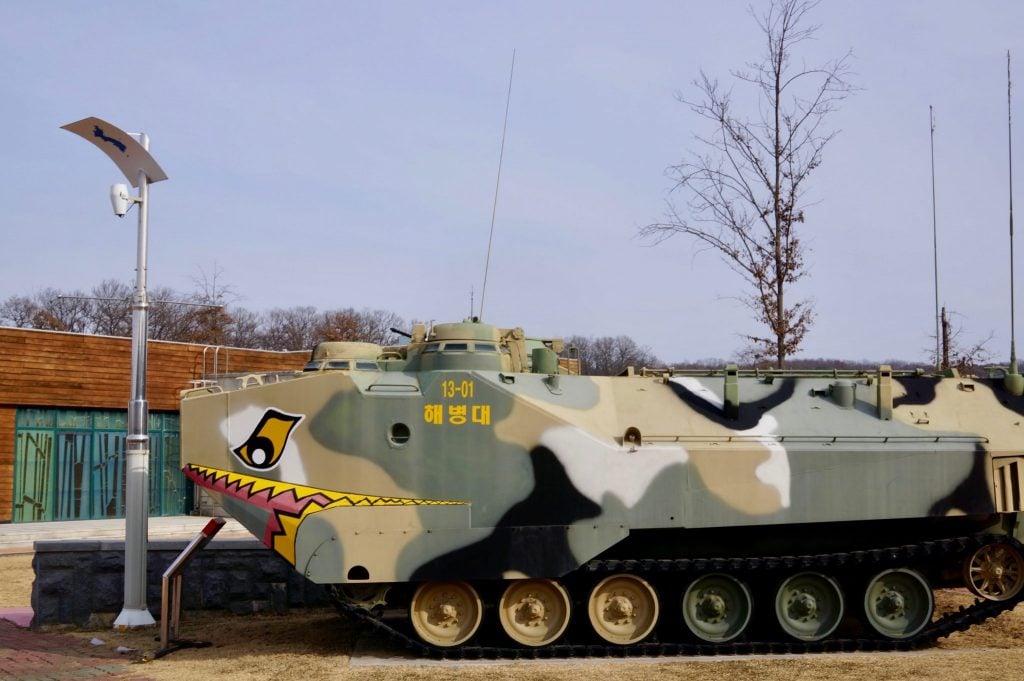
We were given about a half-hour to wander all around the Dorasan Peace Park, unescorted and on our own, to explore these many novelties.
It was uplifting to step through the colorful pinwheels, a bright symbol of peace within the DMZ.
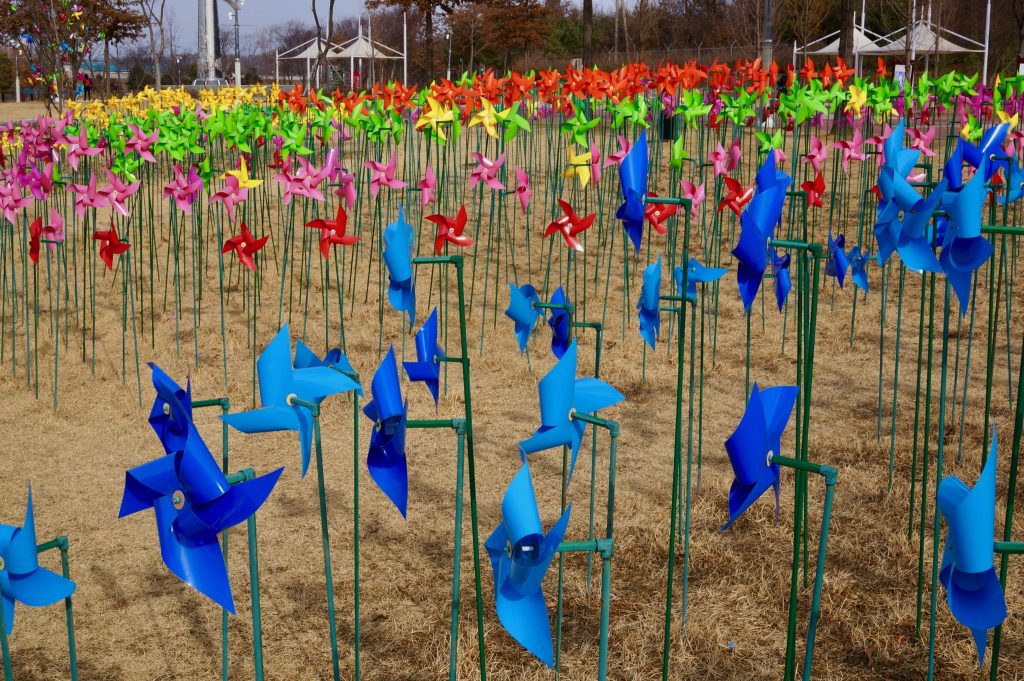
Yet perhaps most notable are the portions of the Berlin Wall that have been reassembled in the park as a sign of encouragement by Germany’s reunification.
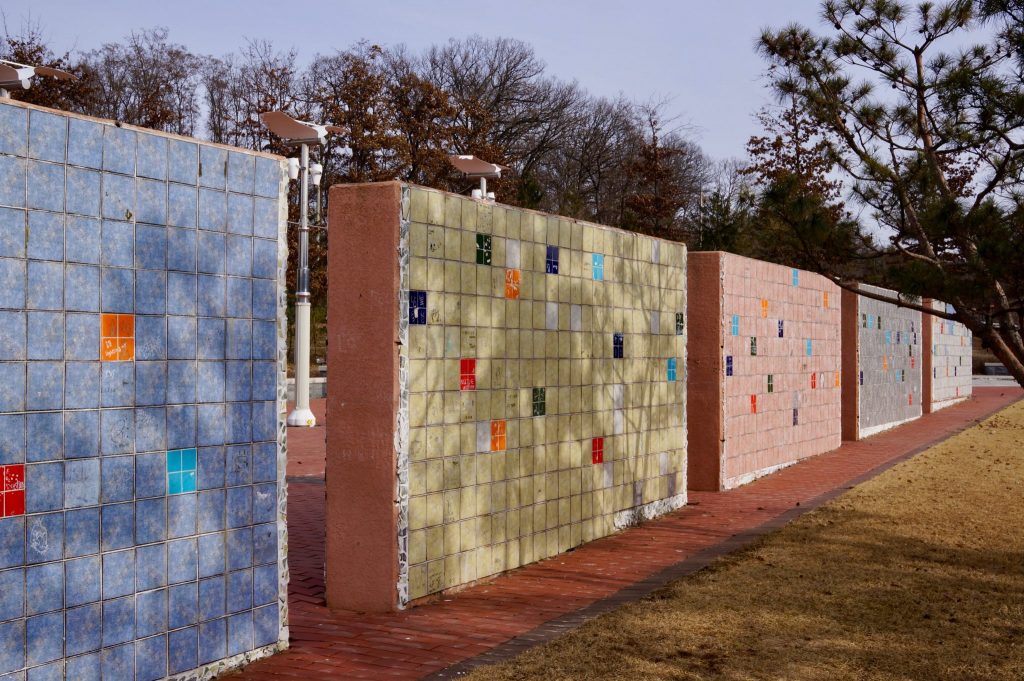
Lunch at a Korean Military Cafeteria in DMZ
The next stop was for lunch at a military cafeteria.
It’s a bare-bones dining hall with a buffet of Korean staples.
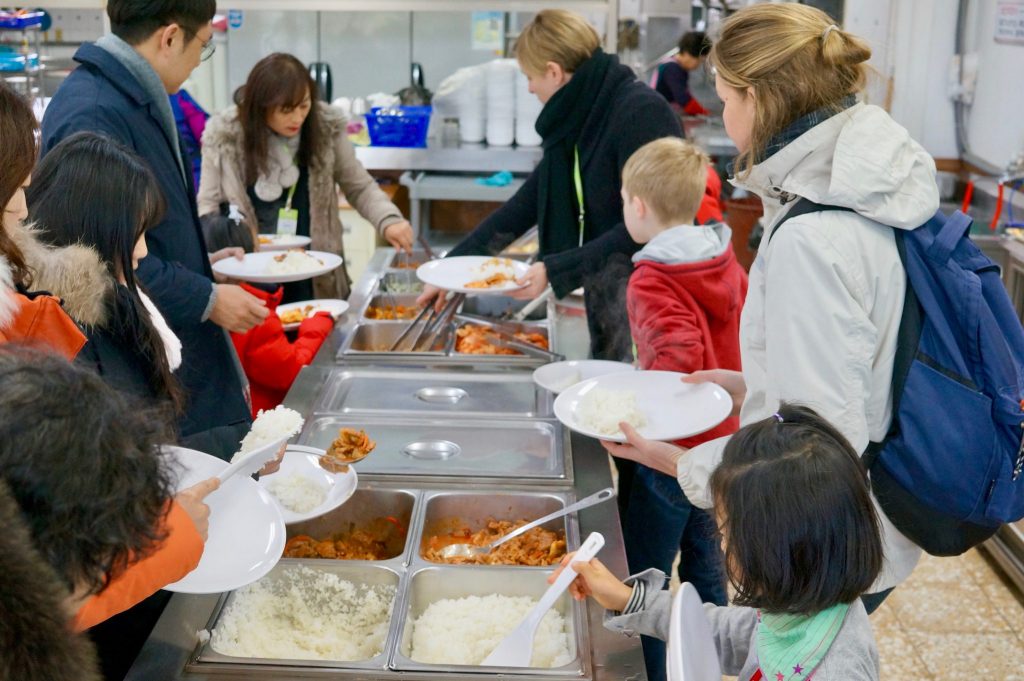
Of course, there would be rice and kimchi on the buffet line in addition to some stewed meat, veggies, beans, and soup. Overall the meal wasn’t great. But it wasn’t bad either.
Rather than focusing on the food itself, this lunch stop provided a unique and interesting experience to dine in a military mess hall within the DMZ .
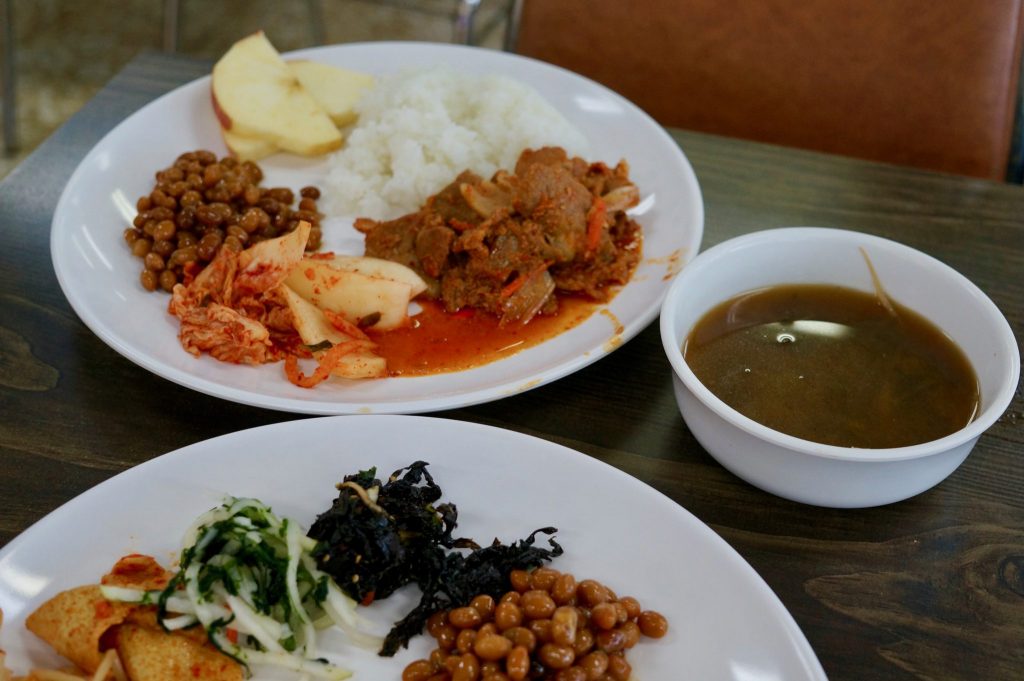
Dora Observatory: Spying Into North Korea
The Dora Observatory is located about a mile from the border of North Korea. Our GPS confirmed just how close we were getting to North Korean.
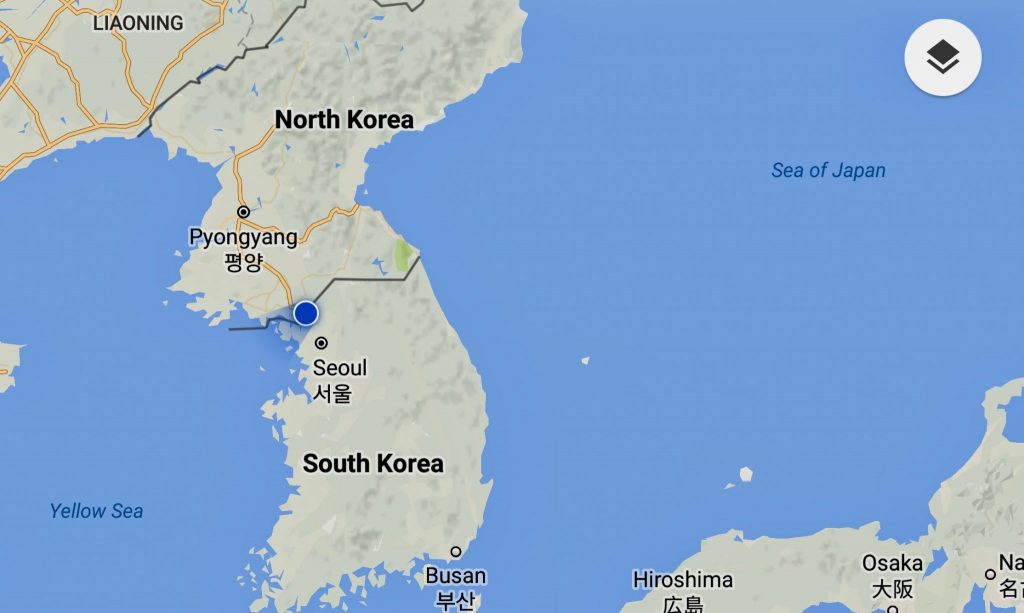
The Dora Observatory is so close to North Korea that it allows visitors to gaze down into North Korea . The Observatory is perched up atop a mountain and you can clearly see into North Korea down below.
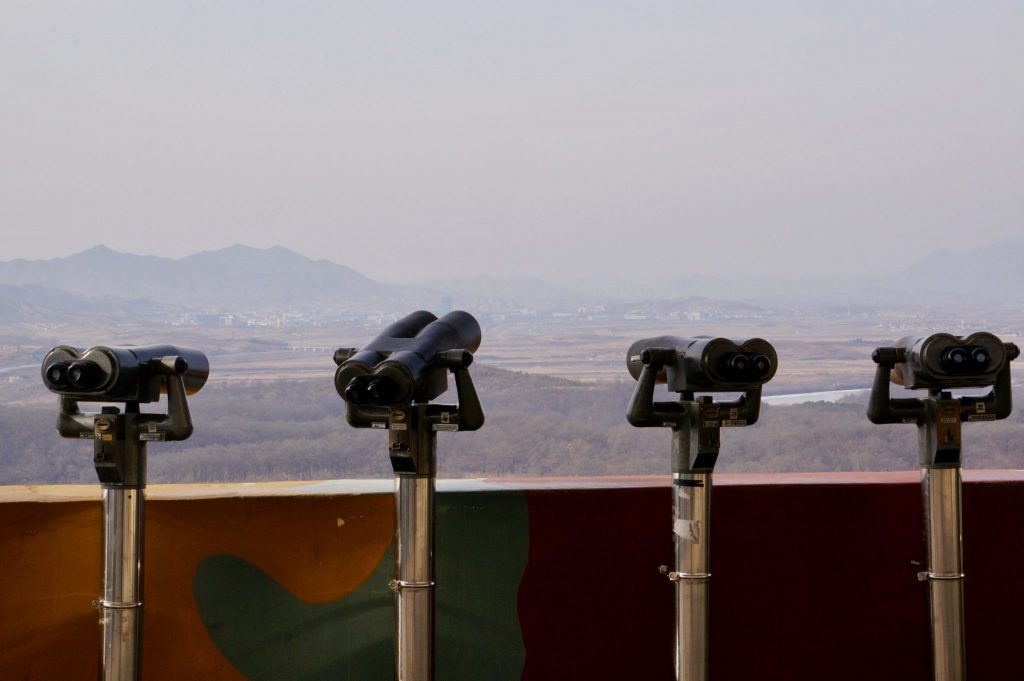
Binoculars are provided to further assist visitors to spy on the northern neighbor.
So what is there to see on the other side of the Korean border?
Take a look! 👇
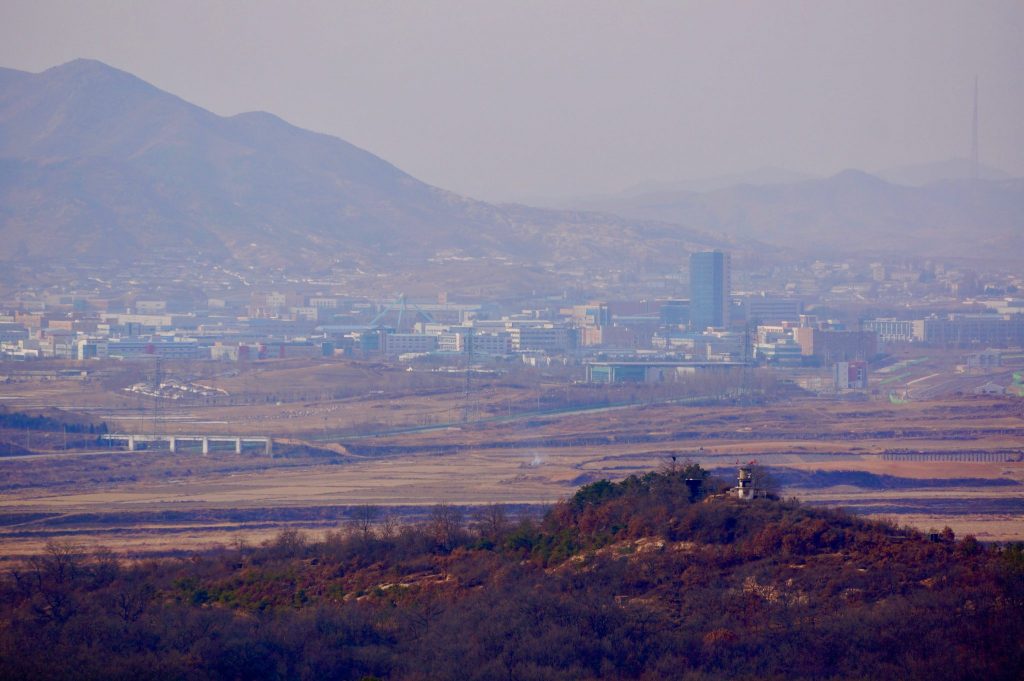
We gazed right down into the industrial North Korean town of Kaesong . The factories appeared active with the industrial plants producing exhaust from the rooftops and perhaps adding to the heavy haze in the air. Yet there wasn’t much life visible in the empty streets.
Also of interest in North Korea is the gigantic flag poll that almost resembles a skinny Eiffel Tower. This is the result of what is known as the “Flagpole War.” In the 1980’s South Korea had erected a 98-meter tall pole waving the South Korean flag. So North Korea retaliated by building what became the tallest flagpole in the world at the time, soaring 160 meters (525 feet) high.
This towering flagpole is still flying high today in Kaesong, although it’s now the fourth tallest flagpole, as taller flagpoles have since been erected.
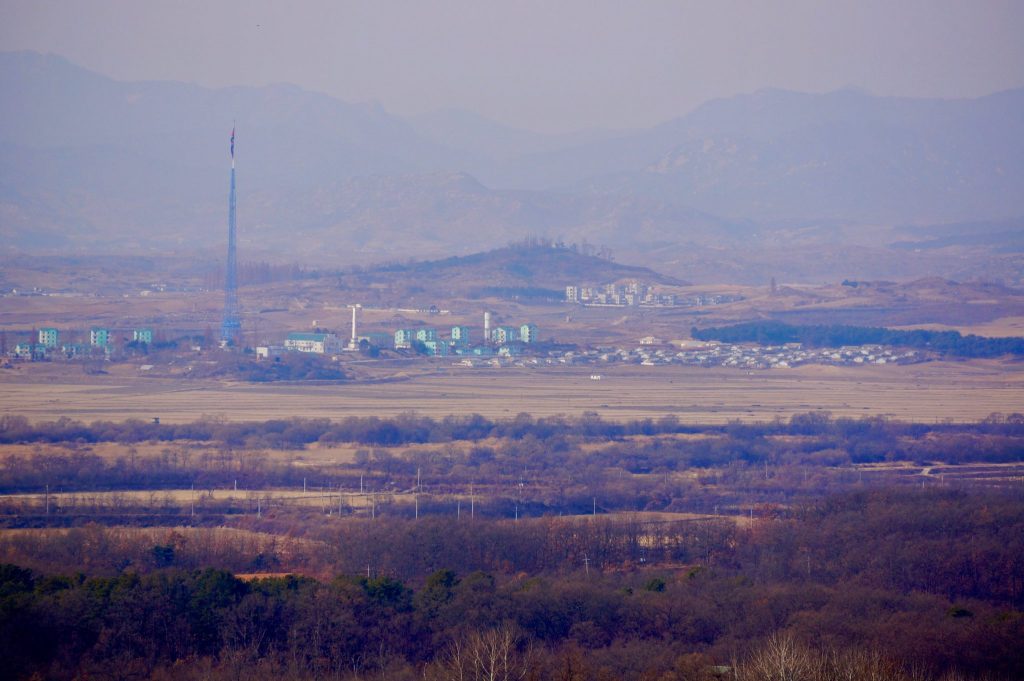
While gazing across the border, we could clearly hear South Korean audio recordings blasting over loudspeakers. These recordings are aimed at anyone within earshot on the other side. The audio propaganda is said to have since ceased at the time of writing amidst current peace talks.
The 3rd Tunnel of Aggression: An Underground Passage to North Korea
The final point of interest on the bus circuit from the DMZ train is what’s known as the 3rd Tunnel of Aggression. This secret passageway was built by North Korea as a potential entryway into South Korea. Although North Korea will tell you that they were simply digging a coal mine, in this contested area that holds no known coal. This was the third such tunnel along the DMZ to be discovered by South Korea, hence the name.
Yet a few decades after the tunnel’s discovery, South Korea has transformed this sign of aggression from the North into yet another bizarre touristic site to now explore within the DMZ.
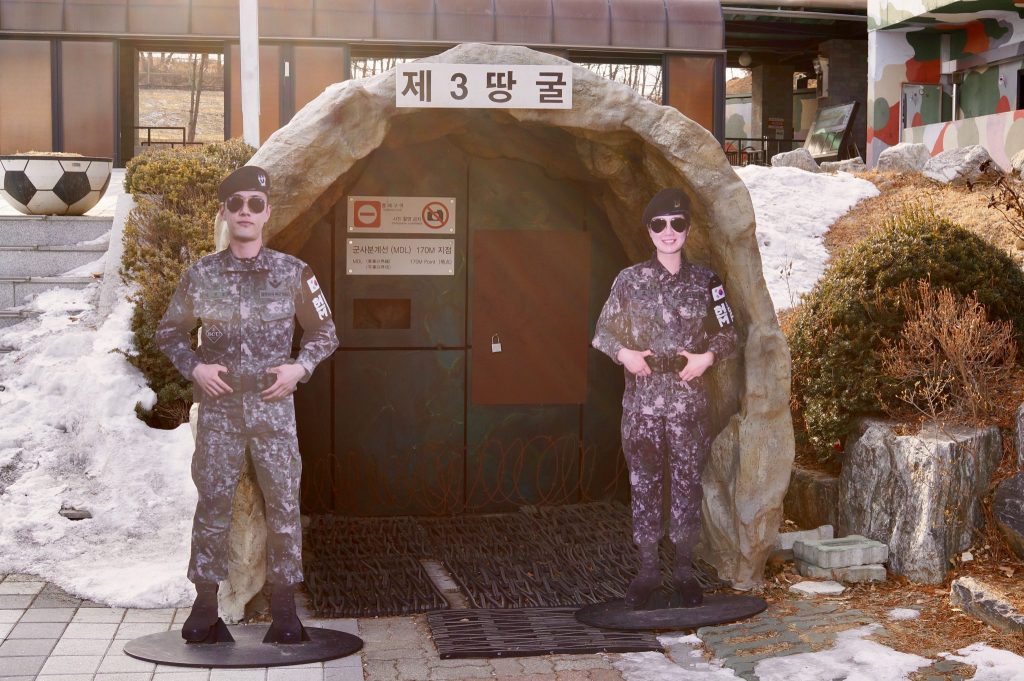
We were armed with hard hats and then allowed to venture on our own, over a quarter-kilometer down into the deep and dark tunnel in the DMZ on our own. There are strictly no cameras allowed , hence we could not take any photos from within the third tunnel. Although we were unescorted inside the tunnel, inching closer to North Korea, there was closed-circuit surveillance monitoring us each step of the way.
It’s a claustrophobic space of only about 2 meters (~6 feet) wide and high. We soon learned why hard hats were required to enter as we bumped our heads many times along lower-lying sections of the tunnel until we reached an armed blockade which we could proceed no further.
This would be the closest point to North Korea during our day in the DMZ. It was here deep in the 3rd tunnel that we were a mere few hundred meters from the border of North Korea .
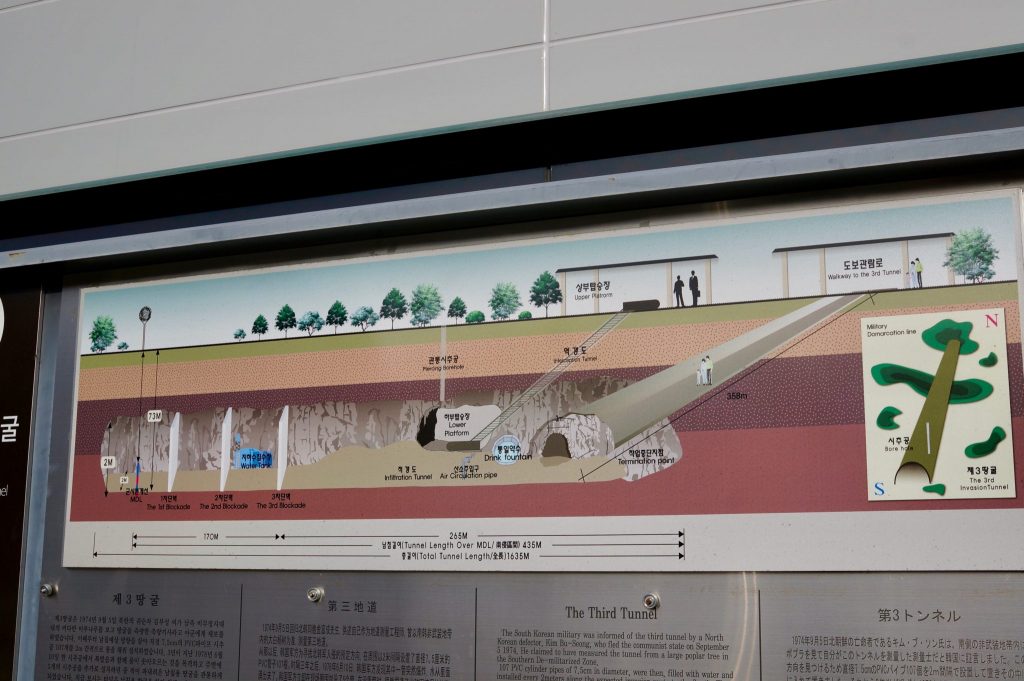
Back up into the daylight, we found that the grounds surrounding the once-secret tunnel between warring countries is now strewn with strange photo ops.
It’s here where you can show your friends how you crossed the border from South Korea into North Korea!
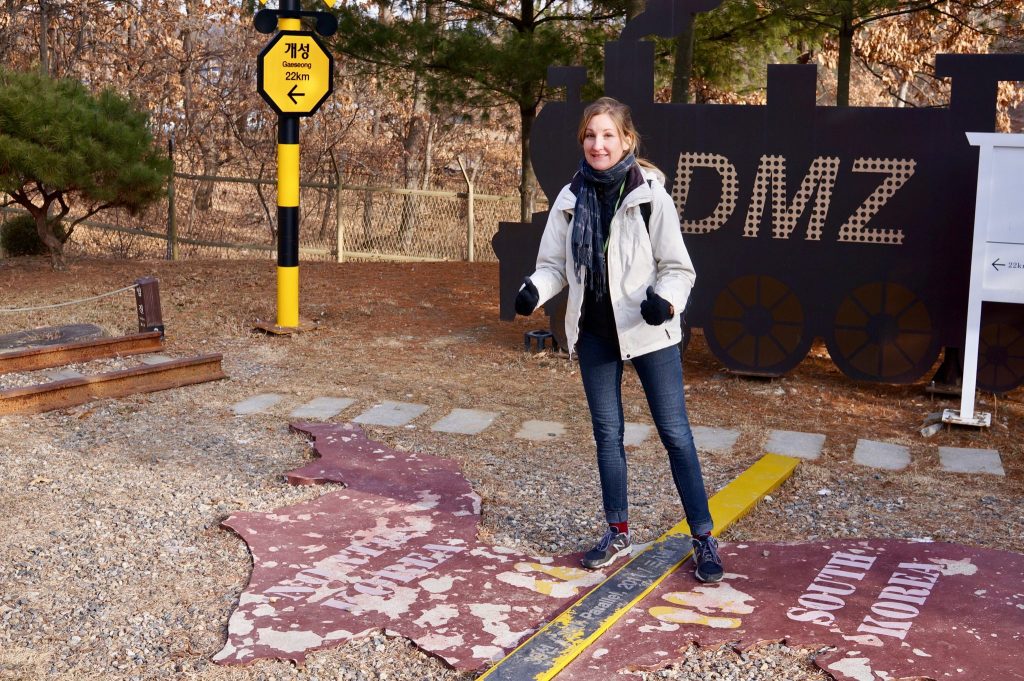
Except, in reality, this all still is entirely within South Korea. We were extremely close to North Korea. But this is not the actual borderline.
Nor were we actually behind the DMZ fence in North Korea.
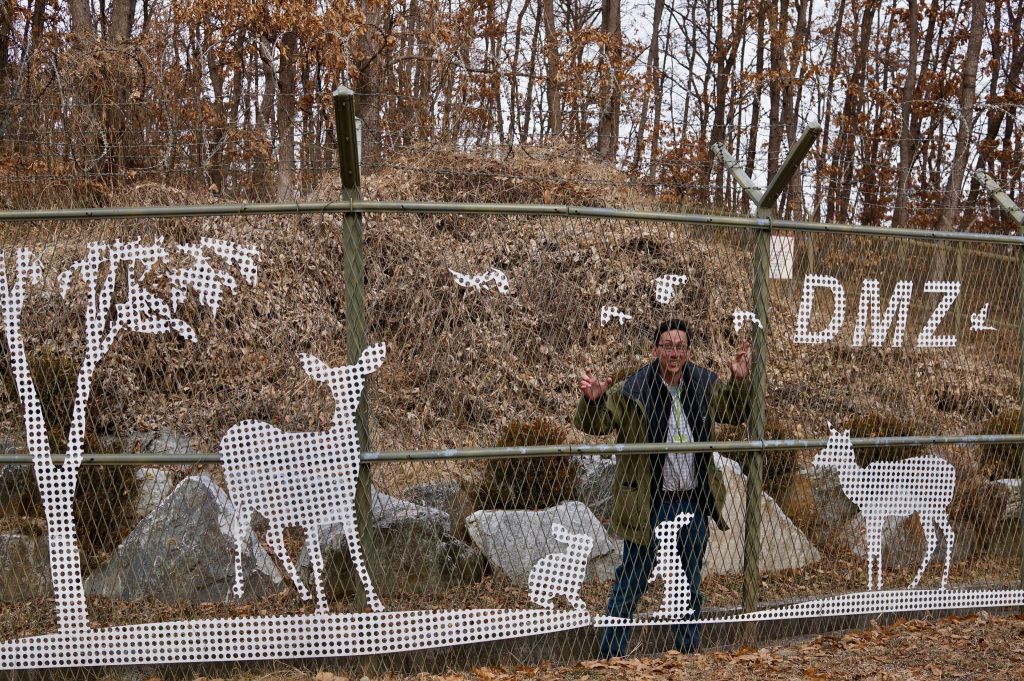
It’s just for fun. And it felt a little strange to be goofing around with these funny props in this otherwise extremely serious place in the world.
The onsite DMZ Pavillion museum gives a stark contrast by reminding visitors of the somber realities of the divided nations.
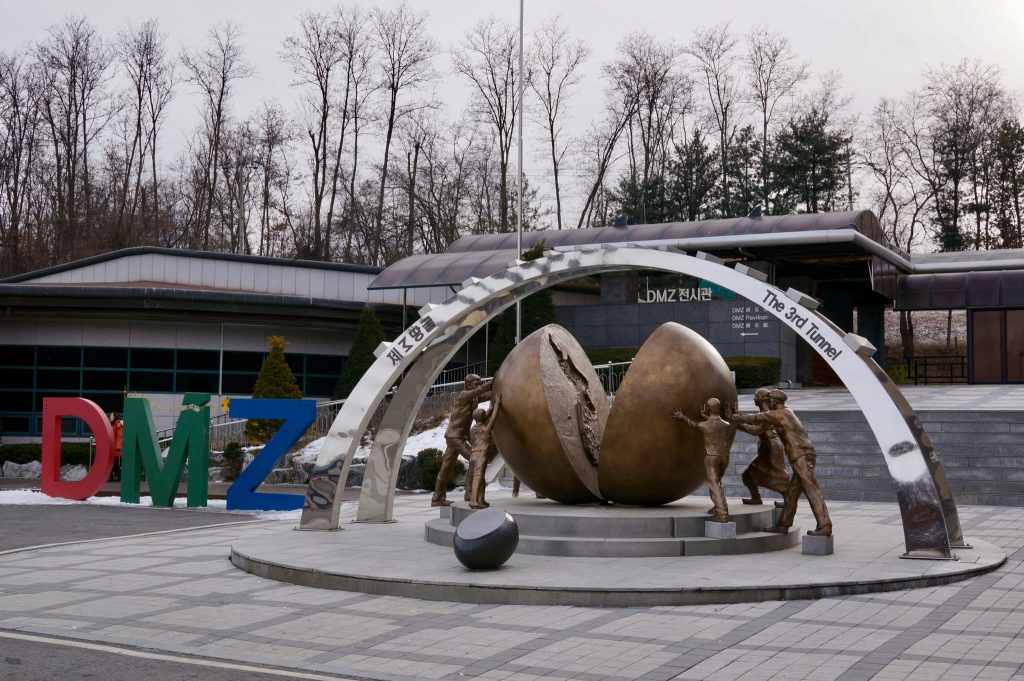
The bus ultimately brought us back to Dorasan Station for the return DMZ train journey back to Seoul on the same Gyeongui Line we had rolled in on. The hour and a half train ride gave us time to try and reflect on this strange day that we just spent within one of the most heavily guarded borders in the world.
Travel Tips & Info If You Take the DMZ Train
🆔 Don’t forget to bring your passport. Very important!
🕙 Plan to arrive at the train station early to ensure time to deal with any Seoul traffic, buy tickets, locate the train’s departure platform, and catch the DMZ train. We suggest planning to arrive at least 30 minutes before departure time to be on the safe side.
👖 Dress nicely. No ripped jeans. No revealing clothing.
💵 Be sure to have cash for the DMZ train tickets, bus, lunch, drinks, souvenirs, snacks, and any other incidentals. (More on DMZ train prices below.)
ℹ️ While on the bus, touring the DMZ, everything was explained in Korean during our visit. Therefore it can be worthwhile to research some of the sights you’re visiting in advance. We also suggest a visit to the expansive War Memorial of Korea , which houses a plethora of exhibits related to the Korean War and the DMZ. It can prove to be a good idea to go to this War Memorial museum before a trip to the DMZ, to gain a deeper understanding of this area and the ongoing conflict.
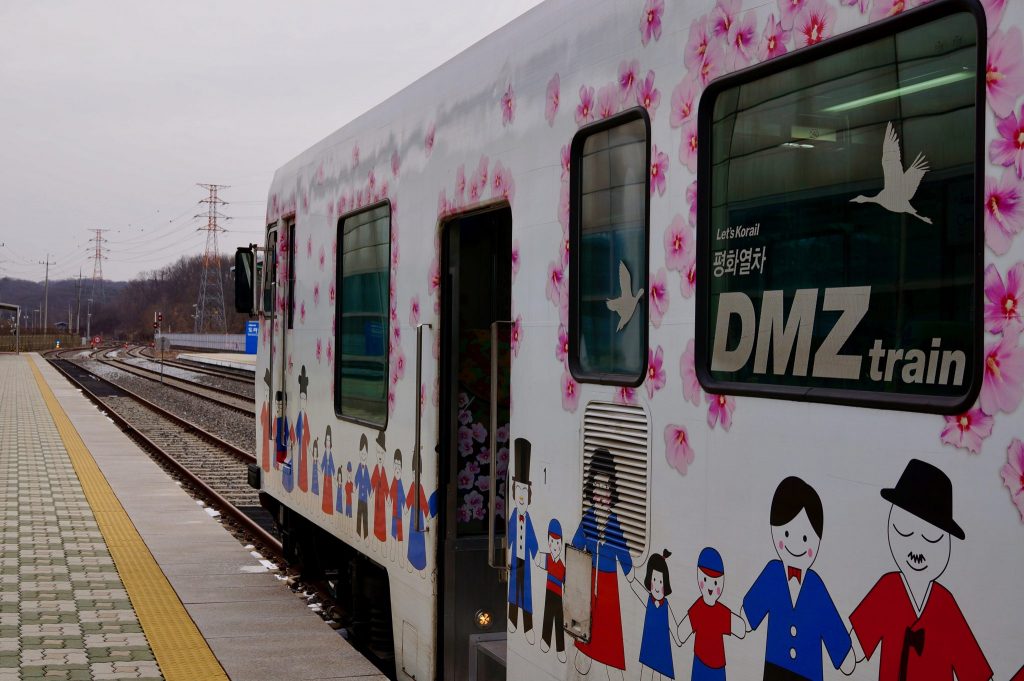
DMZ Train Schedule
DMZ train departs from only two stations in Seoul:
- Yongsan Station and
- Seoul Station.
Days of operation of the DMZ train are:
- Wednesdays,
- Saturdays, and
The DMZ train does not operate on holidays, Mondays, or Tuesdays.
The DMZ train runs on a strict time schedule, so don’t be late. The times below are when the train departs the station. Arrive early.
DMZ Train Timetable from Seoul to DMZ (Outbound) :
🕙 Departure from Yongsan Station: 10:08 am 🕙 Departure from Seoul Station: 10:15 am 🕚 Arrival to Imjingang Station: 11:24 am 🕛 Arrival to Dorasan Station: 11:43 am
DMZ Train Timetable from DMZ to Seoul (Return) :
🕓 Departure from Dorasan Station: 4:27 pm 🕕 Arrival to Seoul Station: 5:47 pm 🕕 Arrival to Yongsan Station: 5:54 pm
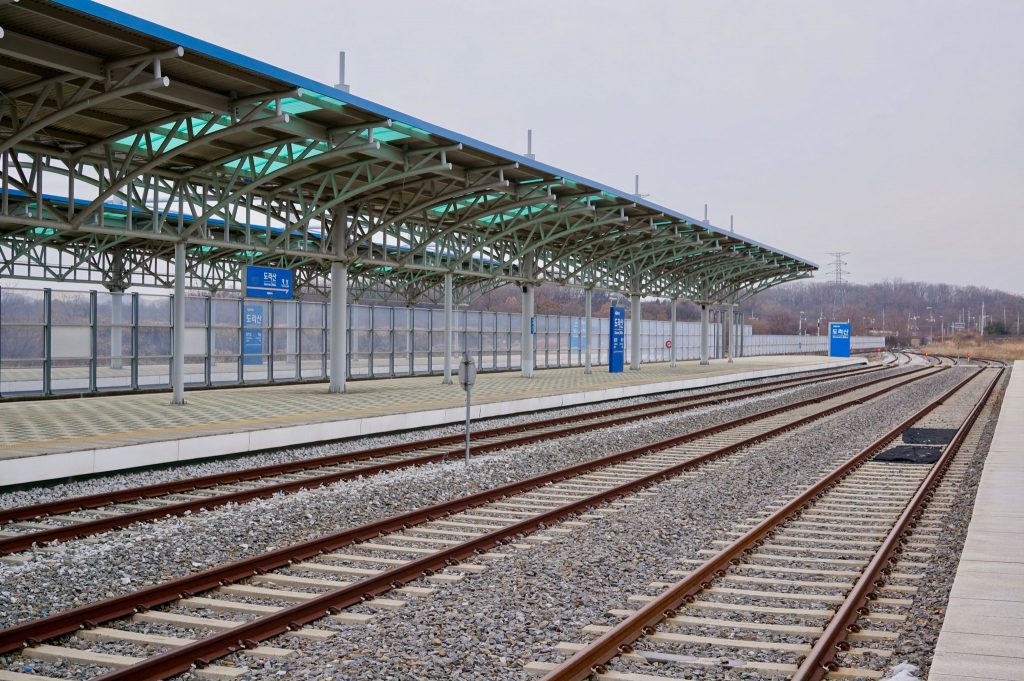
DMZ Train Ticket Prices, Costs, and Entrance Fees
To get from Seoul to the DMZ you must purchase two one way tickets to form the roundtrip journey. DMZ train prices differ slightly depending on which of the two stations are the departure point.
DMZ Train Ticket Price from Seoul Station: ₩17,800 roundtrip (₩8,900 each way) DMZ Train Ticket Price from Yongsan Station: ₩18,400 roundtrip (₩9,200 each way)
+ DMZ bus trip from Dorasan Station, visiting Peace Park, Observatory & Third Tunnel: ₩13,000 (update: As of Oct 2019, a reader has commented the price is now ₩18,000)
+ Buffet lunch : ₩7,000
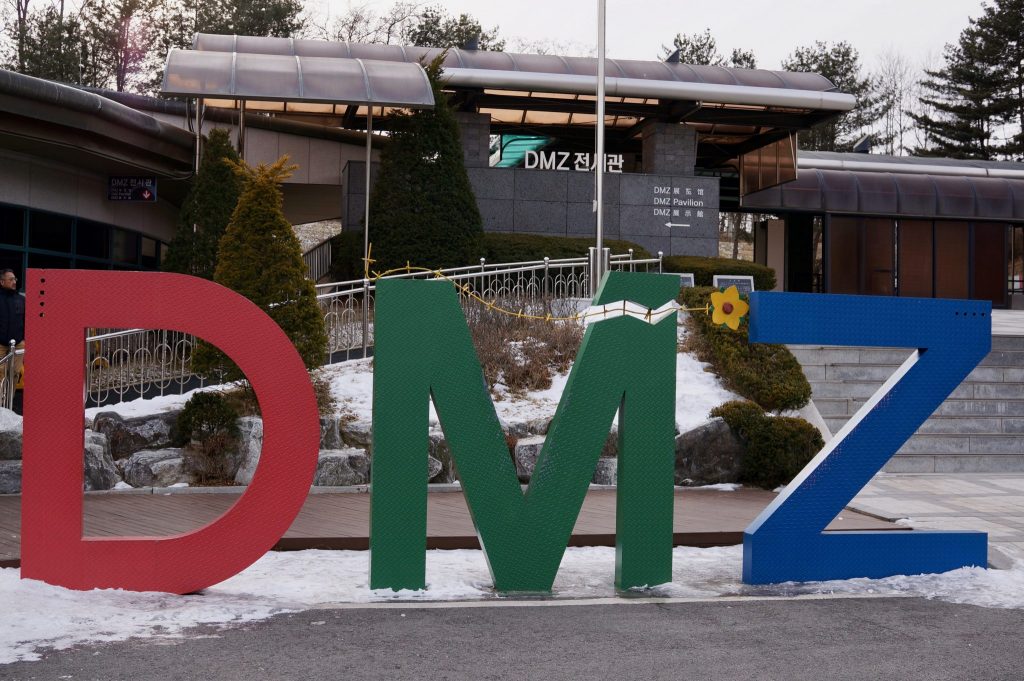
How to Buy DMZ Train Tickets
It is possible to purchase DMZ train tickets directly on the Korail website . However, it’s a bit of a clunky interface in which you must make two separate purchases of one-way tickets in order to secure the roundtrip passage that’s needed. But the site does work and you can secure your tickets in advance using the site. Just be absolutely certain you have purchased both your outbound and return DMZ train tickets.
To avoid any complications, consider booking your DMZ train tickets at the ticket counter at either Seoul Station or Yongsang station. Note: there are automated machines to purchase DMZ train tickets at these stations, but we found they did not accept foreign credit cards . Therefore we suggest it’s best to secure your DMZ train tickets at a counter with a ticket agent.
The bus tickets to tour the DMZ sites from Dorasan Station are sold separately. Those bus tour tickets can be purchased while on the DMZ train as an usher comes by to sell them. Both cash and credit card are accepted for this separate ticket purchase while on the DMZ train.
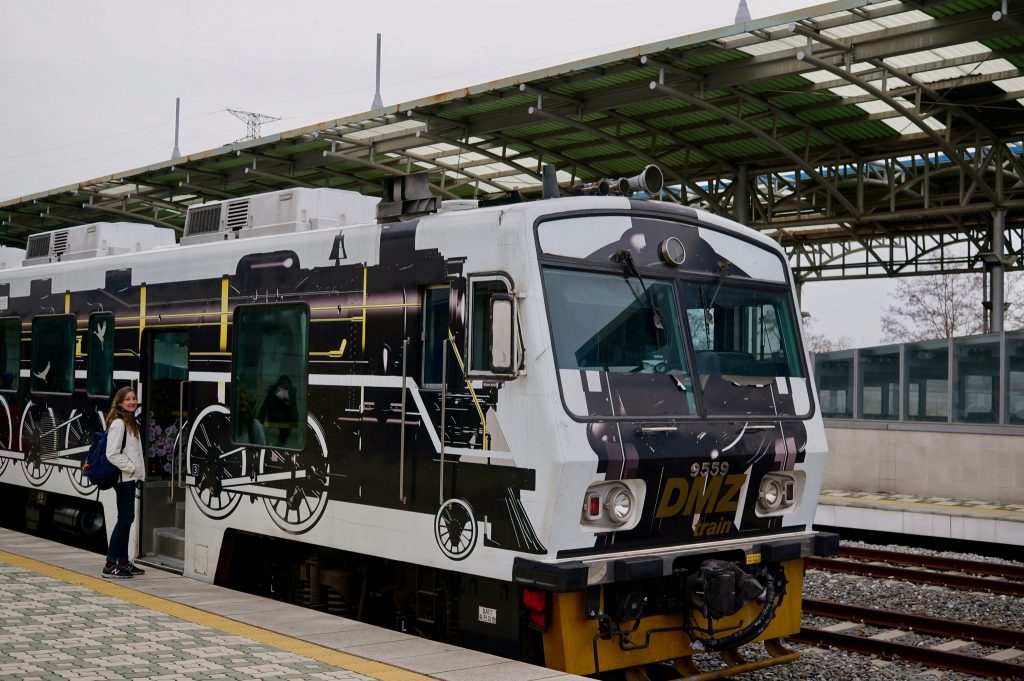
DMZ Train vs Taking DMZ Tour from Seoul
We enjoyed our experience of taking the DMZ train. It was unique to arrive into the DMZ by train and overall our DMZ train review is definitely a positive one! The trip was somehow both fun yet sobering, and extremely interesting every step of the way. The DMZ train is also among the cheapest ways to reach the DMZ.
Despite this positive DMZ train review, we’d be doing a disservice by not pointing out a few advantages in joining a proper tour from Seoul instead of taking the DMZ train. The DMZ train does have a few shortcomings when compared to a tour from Seoul.
Below are some considerations to keep in mind to help decide between the DMZ train and a DMZ tour from Seoul. Whichever way you arrive to the DMZ is largely based on personal preference.
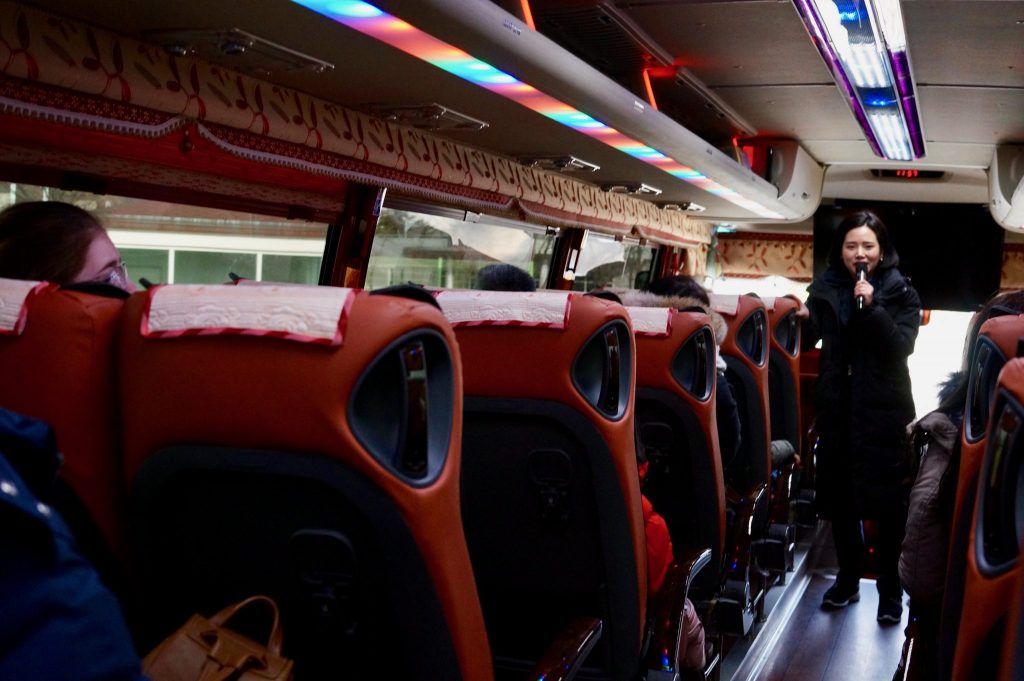
English May Not Be Spoken : During the bus portion of touring around the DMZ, all narration, guide service, and even simple announcements were entirely in Korean. During our tour, there was no English spoken at all. As a result, we had no clue about the significance of the many sites we were touring around. Some friendly bilingual Korean passengers politely whispered to clue us in on critical information, such as how much time we were allocated at a stop. But we largely missed out on learning about this unique place in the world while we were there. Update : Readers have reported that their bus tour did provide some limited English commentary.
Meanwhile, most all DMZ bus tours from Seoul guarantee bilingual tours and are geared towards English speakers.
No JSA : Visits to the JSA (Joint Security Area) are not possible when taking the DMZ train. The Joint Security Area, also known as Panmunjom, is the actual border between North and South Korea where soldiers between both countries face each other. It’s also where visitors can actually be permitted to slightly cross the border and briefly step foot into North Korea while within the buildings of a special neutral zone. This famous Panmunjom truce village in the JSA can only be visited as part of a tour from Seoul, like this one . Those who visit the JSA tend to vouch that it’s an immense highlight of their DMZ experience. Read reviews and book JSA tour here .
Timing : There are DMZ tours that depart 8:00 am and return to Seoul around 2:30 pm, allowing the remainder of the afternoon to explore the capital. Meanwhile, the DMZ train tour returns to Seoul just before 6:00 pm.
Hotel Pick-Up : Most all DMZ tours from Seoul offer free hotel pick-up, making for a more seamless experience and saving on transit expense on getting to the train station.
What’s the Cheapest Way to DMZ? The DMZ train is the cheapest way to tour the DMZ from Seoul. Yet once all the costs of the DMZ Train are tallied, the DMZ Train roughly costs the same as the DMZ tours from Seoul. English-speaking DMZ tours from Seoul run as low as only ₩44,000 , like this inexpensive tour from Seoul that receives excellent reviews , includes hotel pick-up and a nearly identical DMZ itinerary to the one we went on from Dorasan Station. Book this DMZ bus tour from Seoul here .
For the DMZ train, once you factor in the costs of getting to the train station (taxi, subway), the bus tour, and lunch, the price of the DMZ train becomes roughly the same as a tour from Seoul. So we advise choosing between the DMZ train and a tour from Seoul based upon the other factors mentioned above, rather than price.
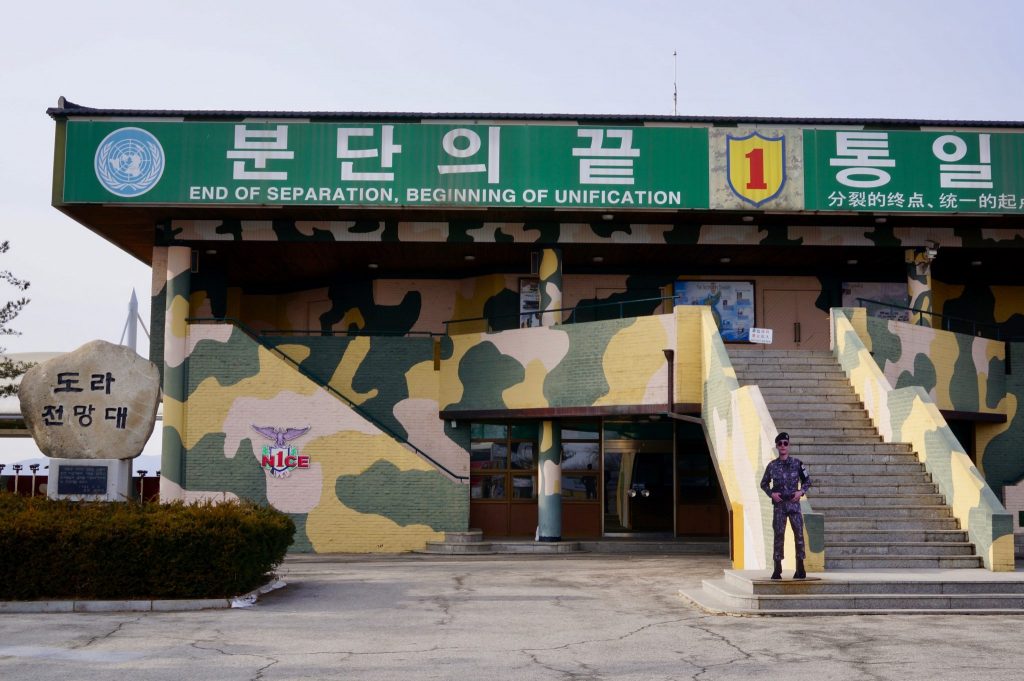
Taking the DMZ Train To North Korea
The DMZ train from Seoul to the North Korea border was certainly the most bizarre rail journey of our travels. It was such a unique experience that made for a memorable day.
This rail journey left us sharing South Korea’s vision of unification. We can only dream of one day potentially taking an epic rail trip from South Korea through North Korea and beyond to China and even connecting to Europe! Maybe one day.
Yet for now, it remains an interesting novelty to take the DMZ train to its final stop of Dorasan Station. Next stop, Pyongyang!
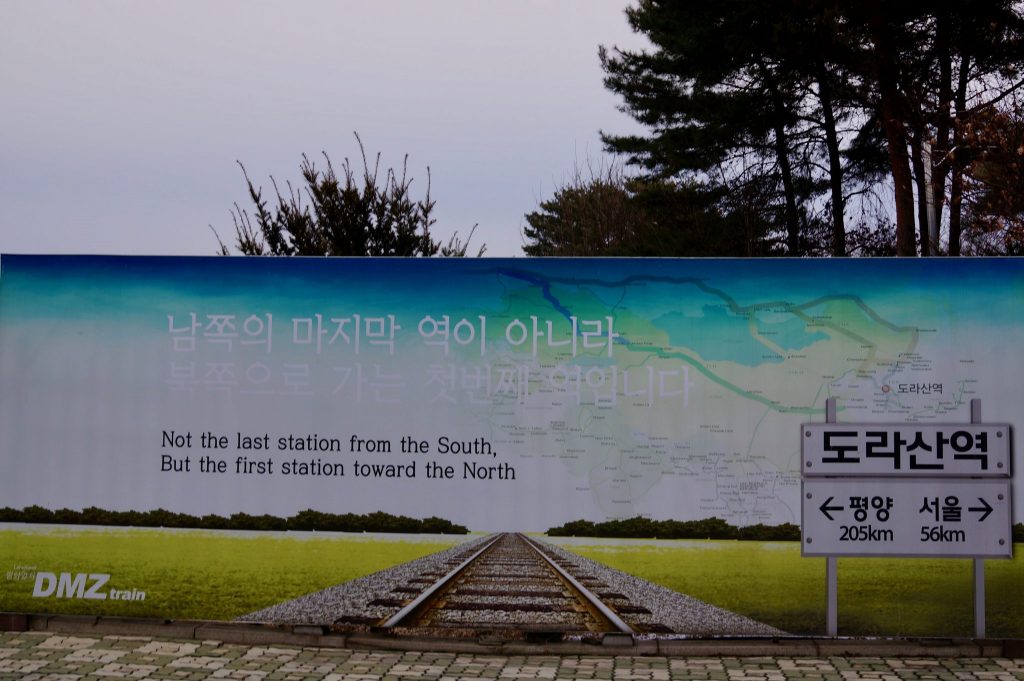
Related Posts

November 11, 2021 at 1:57 PM
It was such an interesting experience to read about your trip to the DMZ. I think that’s the closest one can get to N.Korea, though it might be opening up to tourists off late, for those who would give a positive note on N. Korea. I missed this visit to DMZ when I was on a brief visit to Seoul, couple of years back. I had about only half a day left before my return flight, and now after reading your article, feel convinced that it could’nt have been possible in half a day. Maybe sometime again.
July 14, 2021 at 4:24 PM
Thank you for this detailed report! I love doing things on my own instead of going on a tour but I read everywhere that it’s not possible for the DMZ, so I’m really glad I found this blog. I’m hoping to go to SK next year if the situation allows it, for now it’s just dreaming and planning. The only thing I wondered though was, what if there are more people on the train than seats on the bus? Even though it doesn’t seem like a very known thing to do, you never know, right? Especially when things will open up again and everyone will want to travel again at the same time. Anyway, I’ll do it this way definitely, so we’ll see! 🙂
October 29, 2019 at 10:37 PM
I contacted the Viator tour company asking if they can go to DMZ, and they told me this:
“Due to African Swine Fever, all the DMZ tour has been cancelled from Oct 2. DMZ Tour Zone is officially closed by government. We don’t get any notice when the DMZ Twill be open again.”
So unfortunatly, right now it is imposible to visit DMZ, with or without a tour company.
January 9, 2020 at 5:06 AM
Same here, we tried to visit on 11th of January 2020.
October 29, 2019 at 8:31 PM
Im right now at Yongsan Station. Sorry for write this, (and sorry specially for me since Im here now), but I have to inform that the DMZ train doesnt work anymore (until some change in the future) due to some kind of crisis. The guy at the ticket office didnt know how to explain me that “crisis” with his English, but I think is some epidemic issue.
Lets see if the tour operators can make the trip or they are affected too.
September 30, 2019 at 11:14 AM
Hola from Spain. God, I´m so happy I have found this post… I was checking all the possible tours to visit the DMZ, and I was like “Hell, isn´t there a way to go on your own way?”. And then I found this. I will be in Seoul in less than a month, and of course, I will do exactly what you did, thank you very much for all the detail information.
October 3, 2019 at 11:58 PM
So glad it was helpful and thanks for dropping a comment! Hope you have a great trip. ¡Buen viaje!
October 27, 2019 at 10:24 AM
I’d just like to boldly endorse that comment: I’ll be in Seoul next week-end and will definetly try out the train option. Many thanks for the comprehensive report. I’ve been living in West-Berlin (Germany) at the time the wall existed and witnessed its disappearance – allmost exactly 30 years ago. So, I will be particularly thrilling to see this kind of a wall and I do hope holes can be drilled in it (politically) so that more trains wuill pass Dorsan station in the future
September 29, 2019 at 3:27 AM
We did this trip on Friday and it was exactly like you said. The bus trip ticket is now 18000 won. We paid for this on the train. The guide in the bus read out the basics in English like our stops, what we were doing and what time we needed to be back. Clearly she gave a good commentary in Korean because everyone was laughing and clapping. Thanks again for your information. It was a really bizarre and fun day
October 4, 2019 at 12:05 AM
Thanks so much for the update on the bus ticket pricing. I’ve just edited the post to reflect this change and help other travelers to be prepared for the increased rate. We really appreciate when people take the time to come back and comment with changes in this information so we can do our best to keep this up-to-date. 🙂 And so glad the info proved helpful for a fun and bizarre day that the DMZ train certainly is!
August 15, 2019 at 1:30 PM
Hi, does the bus has a circle route? you can down in a different stop and spend some time there and take the bus again to go to another stop?
August 15, 2019 at 1:58 PM
Yes, the bus goes in a loop. It has the 4 designated stops mentioned in this guide, in which everyone gets off to spend time at each stop. Then everyone gets back on again for the next stop. After leaving Dorasan Station, the stops are (1) Dorasan Peace Park, (2) lunch stop at the cafeteria, (3) Dora Observatory, and (4) 3rd Tunnel of Aggression + the adjacent DMZ Pavillion museum.
July 9, 2019 at 8:45 PM
Thanks so much for inspiring us to take the Train and Bus tour to the DMZ – it was well organized with everything exactly as you posted. We booked our DMZ train tickets before we left Aus using the Korail website – no problems. We purchased the bus tour tickets on the train using MasterCard – a lady came around with the forms etc. As you said the lunch in the ex military canteen was nothing spectacular and not much choice but overall better than expected. We paid for this in cash to avoid the queue for those paying by card. We had to wait for a long time at the Dorosan observatory as one guy on the tour got lost somehow and the bus was not allowed to leave unless all passengers were accounted for as it’s in a restricted area. He eventually turned up but that left time at the tunnel a bit short – Actually we didn’t go all the way in – just a few feet into to rock hewn bit at the bottom of the slope – and yes it is a climb to get back up if you are ancient like us!. Overall a good and informative day trip. Your post was most valuable so thank you – Now we must look at where else your travels have taken you and see if we can follow in your footsteps – or at least some of them. Thanks again – Dave and Anita
July 11, 2019 at 8:28 PM
So glad to hear it helped! Thanks so much for stopping back by with feedback and an update on your experience. Nice to hear you were able to purchase train tickets using the website too. That’s so strange/funny/weird to hear someone got lost at the observatory. That is definitely not a place to wander off. Yikes! Too bad his actions led to everyone else being delayed. But glad you were able to still duck a bit into the 3rd tunnel. Happy travels ahead! 🙂
July 8, 2019 at 11:52 PM
This is a very helpful post! We are planning to take DMZ peace train along with the 2 days flexi Korail train pass, can I check if the bus ticket is readily for sale in the train ride so long we are on board the train? I am worried to end up waiting for return train if we didnt manage to get any bus ticket in advance. Appreciate if there is any advise?
July 11, 2019 at 8:22 PM
Yes, the bus ticket is readily available by an usher on the train. Everyone on the train buys the bus tour ticket. There is no way to do so in advance. But rest assured that you’ll be able to buy that bus tour ticket. They’re synced up, just separate purchases. Have a great trip!
June 7, 2019 at 10:34 PM
Thanks so much for taking the time to write this. We are going to SK in September and your article has been so helpful. I think we (2 adults and 12 year old) will definitely take the train trip. It seems that visiting the JSA of late with an organised tour is hit and miss as to whether it’s even open to visit. So I don’t mind missing it. The train and bus tour sounds like lots of interesting fun and so much cheaper for the 3 of us. Looks like we still get a binocular look into NK that will be interesting.
June 11, 2019 at 2:42 PM
Glad to hear this proved helpful! Yeah, the tours including the JSA can be a bit of a gamble, particularly if booking months in advance. Never know if tensions could flair or ease entirely. The DMZ train with the bus can certainly be an economical alternative and really quite fascinating. You do indeed get to gaze down into North Korea with binoculars, which is interesting to see in person. Hope you have a great trip to Seoul!
May 23, 2019 at 9:04 AM
John – I absolutely LOVED this blog post on using Korail to get to DMZ! We (husband, 10-year old daughter and I) currently have a Koridoor tour booked for early June 2019, but were considering this method instead based on what I read in the “Lonely Planet Seoul” guide book; this way seems like quite an experience! As we can’t do a full DMZ tour these days, this appears to be a great alternative. After reading your post, we have decided to take the DMZ train instead of the Koridoor tour – starting/ending at Seoul Station.
Thank you so much for your incredibly informative post with all the fantastic photos! What a treasure for those looking to go to the DMZ!
Adventure awaits – we can’t wait!
May 23, 2019 at 5:43 PM
Thanks so much! It always puts big smiles on our faces to learn people are finding our posts and making use of the info! 🙂 Hope you have a great trip to Seoul and a positive experience of taking the DMZ train next month. Let us know how it goes. Adventure awaits!
May 10, 2019 at 11:21 AM
Hi there, we would like to go to Paju outlet after DMZ. What is the easiest way to go there and to go back to Seoul? Thanks!
May 14, 2019 at 4:58 PM
This DMZ tour includes a few hours of shopping at the Paju Outlets and sounds exactly like what you’re looking for. Check it out here: https://www.getyourguide.com/seoul-l197/dmz-korean-war-paju-outlet-shopping-full-day-tour-t187710/?partner_id=03EQULS
April 18, 2019 at 1:49 PM
I enjoyed reading this article so much! Gave me an idea of what else I should do in my SK trip this year. I understand that DMZ bus tours from Seoul already include going to the DMZ and back to Seoul transportations, however, I’d like to experience the DMZ train too. Do you have any idea if it’s possible to go to the DMZ on a tour bus and experience the JSA and come back to Seoul using the DMZ train?
April 18, 2019 at 4:34 PM
You can inquire with the tour companies to be certain, but I really don’t believe that would be possible. Those JSA tours are very highly regulated, given the restricted area that is visited. It’s doubtful they’d drop you off unaccompanied to take the train back. Most JSA tours do include a visit to Dorasan Station, so that would still give you some idea of train travel in the DMZ. The Dorasan Station itself is pretty interesting. You simply wouldn’t have the experience of actually riding on the train. Doing both experiences on two different days wouldn’t be practical either, as most all the same places would be visited on both tours, with the exception of the JSA itself. It would be a great idea to be able to do the train and the JSA together, but it’s currently not a tour/route that is offered. I’d suggest trying to decide what’s more important to you, the train ride or a visiting the actual border at the JSA. Either one is a good option, really.
March 14, 2019 at 6:47 PM
Thanks for this! I did the same trip yesterday (March 2019) with the help of this page. Happy to share that things have got even easier since – the bus tour is now in dual Korean/English, and the time in each location is shown clearly on an LED screen held by the guide as you exit each stop. Also at Dora Observatory all binoculars are now completely free to use, and I think I only paid 7,000 for the buffet which would be a decrease in price.
The attractions remain the same but the peace park and Dorasan station now have many photos of the historic meetings between the North and South leaders last year, giving the day a lot of recent optimism for the future. On a Thursday in March there were about 15-20 of us on the train, only three of which non-Korean (me & two others) – so it’s still something that remains a little-known secret way of seeing the DMZ!
March 18, 2019 at 3:06 PM
Thanks so much for this update! It’s really helpful to help keep this post up-to-date and help other travelers partake in this interesting experience. Gamsahamnida! In fact, I’m going to update some of this in the body of the post right now. It’s so great to hear they now do the bus tour in English. And free binoculars too – fantastic! I’ve been wondering how the DMZ area may have changed since the inter-Korean summit occurred, so it’s quite interesting to hear about the added features documenting this bit of recent history and further spreading that hopeful and optimistic outlook. Am still surprised that so few people embark on the DMZ train. It was about the same when we went too. Perhaps this post may help others to embark on this unique adventure without totally letting the secret out. 🙂 Thanks again for the update!
March 26, 2019 at 12:14 PM
Any tips to eating in Seoul, like best places/worst places? Traveling in the summer with my wife and kids.
April 3, 2019 at 9:26 PM
We loved absolutely loved the samgyetang (ginseng chicken soup) at Tosokchon Samgyetang. It’s our favorite meal we ate in Seoul. You can find a small write-up we did about it on an FB post here => https://www.facebook.com/roamingaroundtheworld/photos/a.402455959898551/1261853433958795/
Korean BBQ is a must, of course. Bibimbap is one of our favorite Korean foods. Bindae-tteok (mung bean pancakes) washed down with makgeolli was another favorite of ours in Seoul. Lots of great food in the city and we only scratched the surface!
April 18, 2019 at 7:52 AM
Endore Billy’s remarks, the buffet is 7000 won and the tour 16000 if you are an ‘elder’ or 18 000 if you are younger and 17200 for children. Train pretty full yesterday, our carriage containing Indonesians, Thais, Swedes, Germans and English as well as a good few Koreans, in a way, our own little United Nations on our way to see the disunity of Korea. Now a little snack bar on the train so an 11 o’clock beer before Imjingang Station was very welcome. Overall feeling of great sadness, I think there is no hope of reunification and the short movie of the madmens continued and relatively recent aggression before the tunnel visit showed, despite all the hope that the peace park and the aspirations on the giant tapestry in the Dora observatory floor showed – a tapestry that one is free to sign and as far as I could see had been endorsed by folks from virtually every country in the world. How a madman can single handedly deny the aspirations of the entire world as well as the Korean people is beyond me. John – many thanks for your brilliant blog, it must have taken a lot of time and effort and was an inspiration for the wife and I to go take a look. Good luck man.
April 18, 2019 at 4:42 PM
Thanks so much for the update and kind remarks! So glad to hear this proved helpful in pursuing the DMZ Train. Also love hearing you had your own little UN plying the rails into the DMZ. That is in of itself is a nice little message of peace and unity. 🙂 Oh, and beer too, hehe!
February 28, 2019 at 8:35 PM
Hi. Where and when did you pay for the bus tour. Was it before you got on the train or when you got to dorasan station. Thanks
March 3, 2019 at 12:42 PM
“The bus tickets to tour the DMZ sites from Dorasan Station are sold separately. Those bus tickets can be purchased while on the DMZ train as an usher comes by to sell them. Both cash and credit card are accepted for this separate ticket purchase on the DMZ train.”
January 13, 2019 at 6:45 PM
Thanks very much for putting all this information together! Great breakdown of costs, timings and pros/cons of the train vs. tour options. Really, really thorough!
I’m returning to SK next month; I lived there ~25 years ago — LOOONG before the DMZ Peace Train was a thing.
Safe, happy travels to you from Sam in YYJ.
January 15, 2019 at 9:07 AM
Glad it helped and we hope you have an excellent return to South Korea!
December 27, 2018 at 3:30 PM
Great review! I’m brazilian and very interested in DMZ visiting. You have explained a lot about this half-day trip. Next time in Korea I’ll do it. Thanks and congratulations.
January 5, 2019 at 2:53 PM
Thanks and hope you have a great trip next time in Korea. Really such an interesting experience! 🙂
December 7, 2018 at 2:40 AM
Hi, may I know about the bus tour for DMZ train passengers? How much is it? When you mentioned that the bus tour is time perfectly with the DMZ train, does that mean once we arrived at Dorason station we can immediately hop on the bus? And the bus knows when to drop us off to catch train back to Seoul? Thanks. P,anning to visit next Tuesday .
December 7, 2018 at 8:54 AM
Hi Sharon, Be sure to review the costs section of this post which has all the details. The bus tour is ₩13,000 per person. The buffet lunch adds another ₩8,000. Yes, the train is timed to connect with the bus. Once you arrive at Dorasan Station, you’ll be ushered onto the bus. This bus is specifically for train passengers, so it does drop passengers off back at Dorasan Station to catch the train back to Seoul. During our trip, the bus dropped us off back at Dorasan before 4:00, so we had more than a half hour to explore Dorasan Station a bit before taking the DMZ Train back to Seoul. Hope that helps and you have good trip!
December 7, 2018 at 11:36 AM
Dear John, thank you for the valuable information.
January 29, 2019 at 12:00 PM
Hi John, do you have any information of which tour you took that was ₩13,000 per person?? Thanks!
January 29, 2019 at 12:05 PM
Yes, it is a tour offered whilst on the train. It’s a bus tour from Dorasan Station, visiting Peace Park, Observatory & Third Tunnel, as documented all throughout this post. Just let me know what else you’d like to know about it.
October 31, 2018 at 10:09 AM
Great guide, thank you for taking the time to write such a comprehensive guide to an unique place. Hope to be able to visit, or maybe to see the place when the normality returns… always hopeful!
October 3, 2018 at 12:02 AM
I have a lot of friends that served in Korea and I always kick myself for not going to visit them while they were there lol! I definitely would like to visit and see the DMZ for myself. I’m glad you guys were able to find a cheaper way to get there.
October 8, 2018 at 8:30 PM
It’s never too late to plan a trip to Korea! 🙂 There was still a decent US military presence stationed in and around Seoul when we were there. Met many at the bars, lol. If you ever do make it out that way, would definitely recommend taking a poke around the DMZ. We thought it was really interesting!
October 2, 2018 at 4:14 AM
What a bizarre trip! I really enjoyed living vicariously through this one as I doubt I’ll ever make it to Korea let along the DMZ. Even the train looks bizarre! I love your goofy shots with the props and the tunnel sounds fascinating.
The nearest I get is that I visited the USSR in the days back and enjoyed a tour of Yalta with a Soviet guide. We were in our early teens and being a little provocative. The minute we asked a political question, our guide just started her speech from the start again!
October 1, 2018 at 9:27 AM
Loved this post. I love trains, especially long train rides on the window seat. I did not know such a journey was possible, that too to the border of N Korea! And the train itself looks pretty sleek and futuristic. Someday I’ll do it too.
October 8, 2018 at 8:33 PM
Right, who knew you could roll up on a train right to the N Korea border? The train itself is quite interesting and colorful! And the windows are rather broad too. They also put cameras in the front and the back of the train, with closed-circuit TV so you can see where you’re heading through a TV monitor. It’s an interesting trip – hope you get a chance to go! 🙂
October 1, 2018 at 5:15 AM
Holy guacamole! I had no idea that is was even on the radar for tourists to visit the DMZ! I love the interior decorations of the DMZ train. And the fact that South Korea has a fully stocked station ready to go as soon as peace breaks out. I’ve seen North Korea from the Chinese side many years ago, it did not look anything like that! The barbed wire and fences are scary but it looks like you guys had a great time. I was wondering where all of those pieces from the Berlin Wall went! What an interesting part of the world to visit! Thanks for sharing!
October 8, 2018 at 8:37 PM
Right, we had no idea either! Kinda crazy to chug up in a train to what is possibly one of the most heavily fortified borders in the world. That Dorasan Station seems fully ready for northbound service. I think it’s partly just trying to make a statement, but it truly does have all the facilities and it’s a nice station! It’s quite interesting and symbolic to have found that those large pieces of the Berlin Wall made their way to the DMZ. Gave me chills to see that there.
September 30, 2018 at 9:52 PM
I’m still floored that the most heavily guarded border in the world can be visited as a tourist. It must have been surreal with the remnants of war mixed in with cutesy kitsch and even the frisbee golf park! When you guys were looking down from the observatory did you see anyone looking back?
September 30, 2018 at 4:31 AM
This is really interesting! I didn’t know you could do the DMZ tour on your own. I always thought you had to go with an organised tour company. it looks like not many other people realise this either, judging by the empty seats!
October 8, 2018 at 8:39 PM
Yeah, we were also kinda surprised to find we could take a train into the DMZ. Then we were shocked when we found we were nearly the only ones on the train. But it all made for one of our most interesting days while roaming around South Korea.
September 29, 2018 at 6:23 PM
What an incredibly bizarre experience. Who knew there was a DMZ peace train and you could have the carriage all to yourself, what luck! But seriously, this is why travel is so important these days. You often never get a fair picture from the mass media of destinations. I think having a first-hand experience like this, documenting it and sharing it with others so they can also learn is so very important for today’s society.
September 29, 2018 at 4:15 PM
I never even considered the possibility that one could visit the border without a tour. How much cheaper is it? The tunnel between the two countries is very interesting – I supposed there’s a dead-end because North Korea blocked it up once South Korea found out?
September 29, 2018 at 4:39 PM
It’s definitely an interesting novelty! 🙂 Taking the train plus the DMZ bus circuit we did comes out to nearly the same price as the cheapest tours from Seoul, but ultimately the DMZ train proves to be a few thousand won (a couple dollars) cheaper than the absolute cheapest DMZ tours we saw from Seoul. Regarding the tunnel, from the furthest point we got to, it’s fortified with fencing, barbed wire, artillery, etc. Somewhere beyond that there is a series of three blockades that have been installed.
September 27, 2018 at 8:11 AM
More bizzare trip to the DMZ-had a friend who served a tour in Korea,on one alert he drove his Palladin(self propelled artillery,he was crew chief) to within a few Km of the DMZ and actually sighted in on targets across the border! He really liked Korea and was semi fluent before he rotated back. FYI, the “tank” in your photos is actually a “Amtrak” or amphibious assault vehicle that most fears apricots as the pit is perfectly sized to block the pumps that keep them from sinking,also the train was scheduled to start service in 2001 but derailed by pres bush in his axis of evil speech(falsely accusing Iraq,Afghanistan and North Korea of the US demolition of world trade center and missle strike on the Pentagon to war profiteer)
Wow! I’m sure that anyone who served a tour along the DMZ has some interesting tales to tell. I can understand how your friend liked Korea – we also really enjoyed it. Regarding the delayed 2001 start to the DMZ Train, it’s funny you mention that, as there are signs depicting this at Dorasan Station, with pics of Pres W Bush at the station doing ribbon cutting and everything.
September 26, 2018 at 11:58 PM
Now that’s interesting, Didn’t know DMZs can be open for tours. Got lots of questions swimming in my head that I don’t even know where to begin. Ah!
September 23, 2018 at 8:23 PM
Wow, what an adventure! Your post is super informative and now I want to visit Korea, just not sure about taking the train all the way to the DMZ!
September 25, 2018 at 1:57 PM
Overall found South Korea to be a great place to travel with lots to offer. The DMZ train was definitely an interesting adventure to consider if you ever do make it out this way. 🙂
Leave a Reply Cancel reply
Your email address will not be published. Required fields are marked *
Don't subscribe All new comments Replies to my comments Notify me of followup comments via e-mail.

SITE SETTINGS

Exploring the DMZ, South Korea
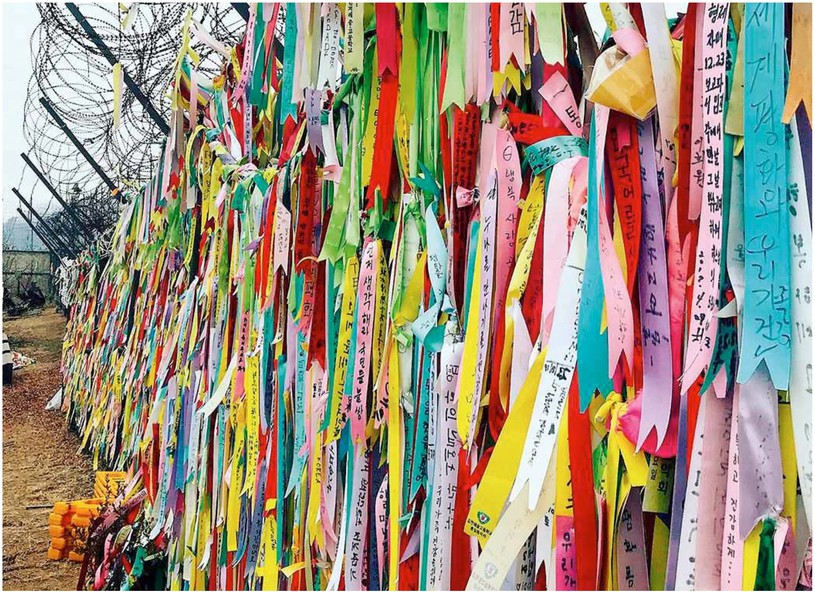
Attempting to warm myself on a cold morning in Seoul, South Korea, I clutched a piping-hot coffee as I located a small tour bus marked with three letters: DMZ. The ‘Demilitarised Zone’ is one of Korea’s most popular attractions, but what makes a visit to this buffer zone of 2.5 miles between North and South so fascinating?
I’d heard stories of K-pop being blasted over loudspeakers as the South attempted to block out the din of constant propaganda messages from the North. But at Imjingak, a park dedicated to the millions of South Koreans separated from their families, it was oddly silent. The audio war seems at an end, and the park itself is now a mixture of memorials and carnival rides. Ribbons tied to the border fence sport messages of peace and flap in the cold wind, as merry-go-round music softly plays in the background. Weird.
This article is from...

Other Articles in this Issue
Basket - 0 items.


Korea Itinerary: 14 days in South Korea
By: Author Amanda OBrien
Posted on Last updated: 05/03/2024
Planning a trip to Korea? It is a fascinating country that is truly foreign. Here is my Korea Itinerary for 14 days that you can use to start planning yours.
If you are looking for a Korea 1 Week Itinerary then I would suggest using this as your base and just pulling out the things to do in Korea that are most important to you for your trip to South Korea .
Things to Book Before You Leave Home Few things are more frustrating on vacation than missing out on that amazing hotel or tour because it is sold out. Here are our top things to book before your vacation. 🏯 Book these popular Seoul Tours before you leave home to avoid disappointment. 1. Half Day Guided DMZ tour from Seoul 2. Introduction to Seoul Tour 3. Korean Cooking Class 🛏️ Where to Stay in Seoul: 1. JW Marriott – my personal favourite – great location and great bar 2. Hotel28 Myeongdong – great location and value, first Korean member of Small Luxury Hotels
- Korea Itinerary
Table of Contents
Day One
Where to stay in seoul, metro hotel, jw marriot dongdaemun square, floral hotel shin shin, sheraton seoul palace gangnam hotel, boutique hotels jeju island, chason hotel the smile, hidden cliff hotel and nature, bayhill pool and villa, daegu hotels, hotel inter-burgo daegu, day thirteen, day fourteen, do you need a visa for two weeks in korea, flights to korea:, frequently asked questions about itineraries for korea, how many days is enough for south korea, what are some popular destinations to include in a korean itinerary, what is the best time of year to visit korea, is it worth going to jeju island, who paid for what in this post.
Arrive Seoul South Korea
Seoul is, of course, the main point of entry for Korea and a great place to start your South Korea itinerary.
Seoul is one of the biggest cities in the world and can be quite intimidating. The Seoul subway station system is great but it is not the easiest to understand as I have never seen so many stops on an underground.

And the average metro station is huge. It is critical to check which is the best exit for you to use for where you are going or you could get very confused. And very sore feet! But public transportation is the best way to explore Seoul so focus on learning how to use it on your first day in the city. Buy a t-money card at any of the many convenience stores in the city.

Finding a boutique hotel in Seoul wasn’t that easy when travelling there for the first time. If you don’t speak any Korean I would highly recommend staying at a hotel that has a speaker of your native language.
I really liked Splaisir Hotel Dongdaemun. The location is great. Dongdaemun is a busy area with loads of shopping – and the shopping malls tend to have restaurants on their higher floors which makes it easier to get dinner. The rooms at this Seoul hotel were quite boutique and very clean.
➡️ Check Prices and Availability for Splaisir Hotel Dongdaemun
⇒ Check out this fantastic post on the Most Instagrammable places in Seoul to help plan your visit
A great first-day activity in Seoul is visiting the Demilitarized Zone and the North/South Korea border. This is a fascinating day trip/excursion which I highly recommend – and it’s the most popular of all the Seoul day trips on offer.
It takes about 2/3 of the day so you will be back in Seoul for an afternoon coffee! I actually think visiting the Demilitarized Zone was the best thing I did during my stay in Korea.
Do make sure you book the DMZ Tour ahead – this Korea tour sells out fast. A bus will take you towards the border. There are then several stops on the way to the DMZ. The train station that never happened. The Bridge to Nowhere.
And best of all the actual border itself where you will be able to take a couple of footsteps into North Korea.

There are some really fun options to do street food markets and cooking lessons in the evening which I would highly recommend.
When travelling in South Korea taking tours is a great way to make things easier. I would consider taking a Korean tour package if you are looking for a more relaxing trip.
➡️ Book Your DMZ Day Trip

You might enjoy reading some of my other articles on Seoul: – Seoul Itinerary 5 Days – Seoul Day Trips – Things to do in Myeongdong – Things to do in Incheon – Best Seoul Boutique Hotels
Time to explore Seoul. Try a mix of old and new with one of Seoul’s most famous palaces, a super cute shopping district and the amazing and futuristic Dongdaemun Design Plaza.
Seoul has two main palaces – Gyeongbokgung and Changgyeon. I chose to visit Gyeongbokgung, the primary residence of the Joseon Dynasty – I wasn’t sure I needed to visit two palaces and I felt that was a wise decision. Again there are few tours in English so this is one to pre-book.
➡️ Book Your Tours of Gyeongbokgung and Changgyeon

When you visit the palace or palaces (they are quite near each other) do head to Insadong. This is a super cute area with shops and restaurants. Yes, it is very touristy but there are also loads of locals.
Insadong is also the home to the rather well-known Poop cafe – you can drink your coffee in a mug shaped like a toilet.
The main shopping area in Seoul is Myeongdong . There are some fantastic places to eat in Myeongdong, cat cafes, a cathedral, a waxworks museum and much more.
Bukchon Hanok Village is also close by. This Korean Folk Village will give a sense of what life would have been like in Korea in the past.
And don’t miss a visit to the neighborhood of Gangnam , made famous by the worldwide hit song Gangnam style.

Bukchon Hanok Village is particularly photogenic if you are able to visit in cherry blossom season. Cherry Blossom season in Korea varies from year to year but is generally around March/April .
Dongdaemun Design Plaza was designed by famous architect Zaha Hadid. It is a jaw-dropping place. I highly recommend putting aside some time to explore it as it is large.
There are exhibits inside – some paid and some free. Gift shop – of course. And quite a few food places as well as places to relax outside. It is also very photogenic and there is no entrance fee.
Head to Gwangjang Market to try some great Korean food for dinner.

Seoul is full of fantastic boutique hotels. No matter what kind of traveler you are, there is a hotel in this city that will suit your needs. Here are some of my top places to stay in Seoul.
Well located in Jung-Gu, this modern hotel offers all the comforts you want during your travels. The rooms at the Metro Hotel are clean, the wifi is strong, and the breakfast is great.

The location is really handy for getting around the city, and there are lots of great amenities at the Metro Hotel Seoul.
➡️ Check Prices and Availability for Metro Hotel
This has got to be the finest luxury boutique hotel in Seoul. The J W Marriott Dongdaemun Square is located in a popular shopping destination and is the perfect base for an opulent stay in Seoul.

Enjoy the spa, the pool, fitness, private verandahs, and incredible restaurant. The JW Marriott Dongdaemun Square Seoul is a truly special place to stay.
➡️ Check Prices and Availability for JW Marriot Dongdaemun Square
Enjoy a luxurious stay at The Plaza for the ultimate Seoul experience. This Autograph Collection hotel is newly renovated and offers guests an unforgettable experience.

Centrally located to many major attractions, this hotel is the perfect home base while in Seoul. Clean, comfortable, and serviced by really helpful staff, The Plaza Seoul is a smart choice.
➡️ Check Prices and Availability for The Plaza
This fun hotel focuses on modern contemporary design and amazing hospitality. You will have a really great time at the well decorated and comfortable Floral Hotel .

This place offers good value for money, especially considering how well maintained it is. The Jung-Gu Flora Hotel Shin Shin Seoul location is also very convenient.
➡️ Check Prices and Availability for Floral Hotel Shin Shin
You can expect world-class service and style at this modern hotel. The Sheraton Seoul Palace Gangnam Hotel is centrally located near the convention centres, Seoul Arts Center, Central City, and other attractions.

The accommodation at the Sheraton Seoul Palace Gangnam hotel is luxurious, clean, and well equipped with all your hotel needs.
➡️ Check Prices for the Sheraton Seoul Palace Gangnam Hotel

Fly from Seoul to Jeju Island South Korea
⇒ Flights Seoul to Jeju Island
Jeju Island is in the far south of South Korea. I stayed in Seogwipo on Jeju which is in the south of the island. We visited the rather unique Loveland on the way from the airport to Seogwipo eg we had the cab stop there.
This is possibly the most unique of all the things to do in Jeju Island. I understand that Jeju Island is commonplace for Korean couples to go on their honeymoon.
Therefore these “love” parks have lots of sculptures of different sexual positions, sex organs and well lots of rather interesting takes on genitalia in general.
This would not be a good place to go if you are traveling with your parents. But it is quite amusing and a uniquely Korean experience.
You might enjoy reading some of my other articles on Korea: – Korea Itinerary – Jeju Island Itinerary – Busan Itinerary – Things to do in Daegu – Things to do on Jeju Island – Beautiful Places in South Korea – Where to stay in Busan – Cherry Blossoms in Korea

Once in Seogwipo, it is possible to walk to the Cheongjeyeon Waterfall and Saeyeongyo Bridge which are lovely.
I did find Seogwipo a rather confusing place. Virtually all the hotels are in a town area that really doesn’t feel like it is anywhere near a coastline.
Again, a bit like Seoul and Korea in general if I had known then what I know now I definitely would have taken more organised tours during my Korea touring. It was quite hard work trying to figure out how to get around – with lots of unsuccessful attempts and sore feet.
The day’s activities:
⇒ Loveland
⇒ Cheongjeyeon Waterfall
⇒ Saeyeongyo Bridge
➡️ Book Your Jeju Day Trips

Chason Hotel The Smile is in the heart of Seogwipo – perfect for travelers looking to explore nearby waterfalls, visit the iconic sights and discover the local food. The hotel offers the usual perks of excellent WI-FI, a continental breakfast and the best coffee.

I would recommend Chason Hotel The Smile for couples traveling to Jeju Island. However, they do also offer family rooms. All the rooms at this Jeju Island hotel are very clean, neat and provide all the amenities you could wish for.
⇒ Check Prices and Availability for Chason Hotel The Smile Now
The Hidden Cliff Hotel and Nature sits on the top of a hill and is surrounded by thick woods teeming with life. The hotel is surrounded by hidden hiking trails for the adventurous soul, and offers a large infinity pool to cool down in at the end of a long day.

The vibrant rooms at The Hidden Cliff Hotel and Nature have wooden finishings and a private balcony to relax on. As an added bonus, Jungmun Beach is just a five-minute drive away from this hotel on Jeju Island.
⇒ Check Prices and Availability for The Hidden Cliff hotel Now
Bayhill Pool and Villa offers luxurious rooms with private terraces and ocean views. Located in a slightly secluded area, it’s the Jeju hotel to stay if you are looking for a quiet getaway.

The spacious rooms at Bayhill Pool and Villa have a stylish modern interior for you to enjoy and unwind after a day exploring,
⇒ Check Prices for Bayhill Pool and Villa

The coastline of Jeju Island is stunning! However, it is not that easy to get around (are you noticing a theme in my Korea blog?). I struggled a lot to figure out the buses and then ended up getting a taxi to take me for the day to fulfill my Jeju Itinerary . I ended up visiting:
- Lizard Island
- Seongsan Ilchulbong
- Sangumburi Crater
- Manjanggul Cave
This was perhaps the highlight of Jeju Island. It was a relief to get away from the weird almost industrial feeling Seogwipo. Do take your camera as there is much to photograph in these locations.
⇒ However, I would highly recommend you take the stress out of it and by booking a day tour to cover these sites – there are lots of good tour options.

Climb Mount Hallasan. This is a lovely trek up Korea’s highest mountain and there are several different paths to be taken depending on how energetic you are feeling.
The paths on Mount Hallasan are generally very clearly signposted and there are a couple of stops with food. The path is clearly signed so there is no need to get a guide.
We found it easy to get a taxi to the starting point of the trek. However, it was not so easy to get a cab back.
If you can, try to agree on a time to meet your taxi driver or get a number to call them when you are finished climbing Mount Hallasan.
➡️ Book Your Mount Hallasan Transfer

⇒ Lee Jung-Seop Gallery
⇒ Jeongbang Waterfall
⇒ Seogwipo Market
We spent day 7 in Seogwipo and found some interesting options. First up was the Lee Jung-Seop Gallery.
He is one of the most famous artists in Korea. He was an artist around the time of the Korean war and Lee Jung-Seop Gallery is lovely.
Seogwipo has some lovely waterfalls which are well worth visiting. Again, it is not that easy to find them but once you get there it is worthwhile. Seogwipo market feels very local. I suggest heading there at lunchtime.
We looked at where there were queues and what they had ordered and basically followed along – and earnt some rather tasty snacks as a result.

Fly to Daegu South Korea
Daegu is virtually in the middle of Korea and in a bit of a basin, making it very warm in summer.
There are loads of great things to do in Daegu . Of all my South Korea travel cities it was the easiest place to get around – possibly as Daegu is a bit smaller and has more of a grid layout. A bus tour is always a great way to get a feel for a city and Daegu was no exception.
Also, I used the bus tour to take me to the starting point for the Apsan mountain cable car. This was a fantastic thing to do. I visited Daegu in the height of summer so there was no way I was going to hike up the mountain.
However, if your visit is better timed than mine I highly recommend walking up Apsan mountain and it seemed clearly marked.
⇒ City Tour Bus
⇒ Apsan Mountain Cable Car
The view from the top of Apsan Mountain is stunning with full panorama views over Daegu. There are also locks on the barriers which make for nice foregrounds for photos.

Kim Kwang-Seok was a popular folk singer in Korea. He died in 1996 by taking his own life. Kim Kwang-Seok sold over 5 million records.
He was born in Daegu and there is now a street named after him. The street is filled with street art portraits dedicated to Kim Kwang-Seok and most of the time there will be a musician playing his music in the area. There are also quite a few cute cafes etc in this part of town.
Seomun Market is in the centre of Daegu and quite a large place. It is a more functional market vs a tourist market but has some attractive food options.
⇒ See my full post for more information – 12 Best Things to do in Daegu

February Boutique Hotel Apsan is a fun little hotel with themed rooms and a great atmosphere. Besides the lovely decor and fully-equipped rooms, the boutique hotel is centrally located with so many brilliant shops and amenities nearby.

The February Boutique Hotel Aspan is a really good value hotel for a perfect trip to Daegu – you will seriously love staying here.
⇒ BookCheck Prices and Availability for February Boutique Hotel Apsan
If you are looking for a clean and comfortable hotel that will allow you to make the most out of your stay in Daegu, then the Hotel Inter-Burgo is a wise choice.

With its own gym, spa, bar, and restaurant, you will be well taken care of at Hotel Inter-Burgo Daegu. The riverside location is excellent and very close to many top attractions.
⇒ Book Check Prices and Availability for Hotel Inter-Burgo Daegu

Day trip to Jeonju South Korea – bus from Daegu return.
It was quite easy to figure out how to get to Jeonju from Daegu and very easy to walk to the old town of Jeonju from the bus stop.
I highly recommend getting dressed up in the local costumes as do many Koreans. We attracted a lot of attention and amusement as westerners dressed in their outfits. This is a brilliant South Korea travel experience.
The old town of Jeonju is very photogenic and filled with stores and cafes. Don’t miss the Jeonju mural village. Jaman Mural Village is outside of the old town – you will need to cross the main road to get there.
Jaman Mural Village is filled with street art over several levels and also has a few cafes. Extremely photogenic. A day trip to Jeonju is definitely a full day trip.
If dressing up like a Korean doll isn’t your thing then both busan and Gyeongju are quite easy day trips from Daegu as well.
⇒ For more information on Jeonju read this great post on 8 Things to do in Jeonju South Korea

Who could resist a Racoon Cafe? Literally, there are racoons wandering around this Daegu cafe. I didn’t feel comfortable getting too close, but it was an unforgettable experience.
We also found a dog and cat cafe in Daegu. Sensibly there was one room for the dogs and one room for the cats.
⇒ Racoon Café
⇒ Medicine Street

Train from Daegu to Seoul Station.
Don’t miss N Seoul Tower – the views are amazing. However, do pick your weather. There are quite a few hazy days in Seoul which will result in a poor viewing experience at Seoul Tower. If you get a good day get moving and get up that tower.
⇒ Beat the lines and book your N Seoul Tower tickets
Or for something different consider a day trip to Nami Island.
⇒ Due to the challenge of getting around Seoul, I would highly recommend checking out some of these fun Korean culture themed half-day tour options.

Seoul Wa ll is the old wall that used to run around all of Seoul. Several parts of the Seoul Wall are still in good shape. I found it easy to navigate the Seoul wall on my own but it wasn’t easy to get there or get back.
And do check about photography. When I visited, it was illegal to take photos on the sides of the wall towards North Korea.
Ihwa Mural Village is not too far from a section of the wall. It is a cute area with street art and cafes. Ihwa Mural Village is perfect for Instagram.
Finally, the Korean War Memorial and the museum are extremely impressive. The area around the building is massive and filled with ships, tanks, and all things military.
I found the exhibit on the Korean War in the museum fascinating. The gratitude of the Korean people for the western allies who supported them during this time is very moving.
As is the massive effort Korea as a country has put into taking itself from this weakened position to become a global player. Fascinating stuff and visiting the Korean War Memorial is a must-do whilst in Seoul. It should be part of any Seoul 7 days itinerary

Fly out of Seoul.
To travel to Korea is not the easiest of tasks. But it is still possible to do it independently. The above is essentially a solo travel Korea Itinerary. Or if you remove Daegu, it could be a Korea Itinerary 10 days. Or swap Daegu for lovely Busan .
A couple of things to note:
Korea Seoul Time is GMT + 9 hours.
The Korean days of the week are the same structure as in English – just of course in Korean.
When it comes to how much to bring to Korea for 7 days or 14 days, check the weather forecast. I went in summer and it was hot hot hot. But I do know the temperature drops alot in the winter.

It can be a real pain trying to figure out if you need a visa for a country and then all the hassle of figuring out how to apply, how long you can go without your passport when the embassy is open etc.
iVisa has completely revolutionised this process and put it all online and make it super simple and paper and hassle-free! Using iVisa is one of my top travel tips!
NB: Citizens of the United States, Great Britain, Australia and Canada do not need a Visa for Korea if they are staying less than 90 days. Do double check that this still holds when you book your airfares.
⇒ Check if you need a Visa for Korea

Seoul is the usual port of arrival for most into Korea. Incheon International Airport is the main airport.
⇒ Flights to Seoul Incheon Airport
⇒ Flights from Seoul to Jeju
⇒ Flights to Daegu

To help you in planning a trip to South Korea here are some of the best articles that I have found about Great Things to do in South Korea.
⇒ CNN Travel South Korea
⇒ Lonely Planet South Korea

I would allow for at least one week in South Korea. Spend a minimum of 3 days in Seoul and then head down to Jeju Island or visit Daegu and Jeonju.
Some popular destinations to include in a Korea itinerary are Seoul, Jeju Island, Busan, Gyeongju, the DMZ, and the Korean Folk Village.
Spring (March to May) and autumn (September to November) are generally considered the best times to visit Korea, when the weather is mild and there are beautiful cherry blossoms and fall foliage to see. However, summer (June to August) and winter (December to February) also have their own charms and attractions.
Definitely! After Seoul, it was the highlight of my visit to South Korea.
I covered all of the costs associated with my trip to Korea. This Korea Itinerary post does contain affiliate links. That means if you click through on them and end up making a purchase I will receive a small commission – at no additional cost to you. I just wanted to make sure you knew.
Like this post? Why Not Pin It?

Amanda O’Brien is the creator and editor of The Boutique Adventurer. She has visited 80 countries and is a member of the British Guild of Travel Writers as well as the IFTWTA. She is passionate about wine had has just completed Level 3 of the WSET. Born in Australia, she lives in London.
This site uses Akismet to reduce spam. Learn how your comment data is processed .
Tuesday 25th of August 2020
Sound's like you had fun in South Korea. I can't visit anywhere in this lockdown. I'll visit South Korea after the lockdown. Thanks to you for the kind information.
Ana Rose | Roads and Pages
Tuesday 17th of January 2017
I would love to visit Korea someday. However, I am afraid of tourist visa. I applied for one before in Australia but got rejected. I wonder if it was because I haven't travelled much yet. I am thinking of going to South Korea after 5 years of visiting free visa countries. Those attractions you mentioned are really interesting. I would love to see it myself someday.
Friday 23rd of December 2016
Sounds like a fun adventure!
Like this post? Why Not Share It?
Thanks for Sharing!
Japan tackles overtourism with restrictions for some iconic sites

Mar 27, 2024 • 5 min read
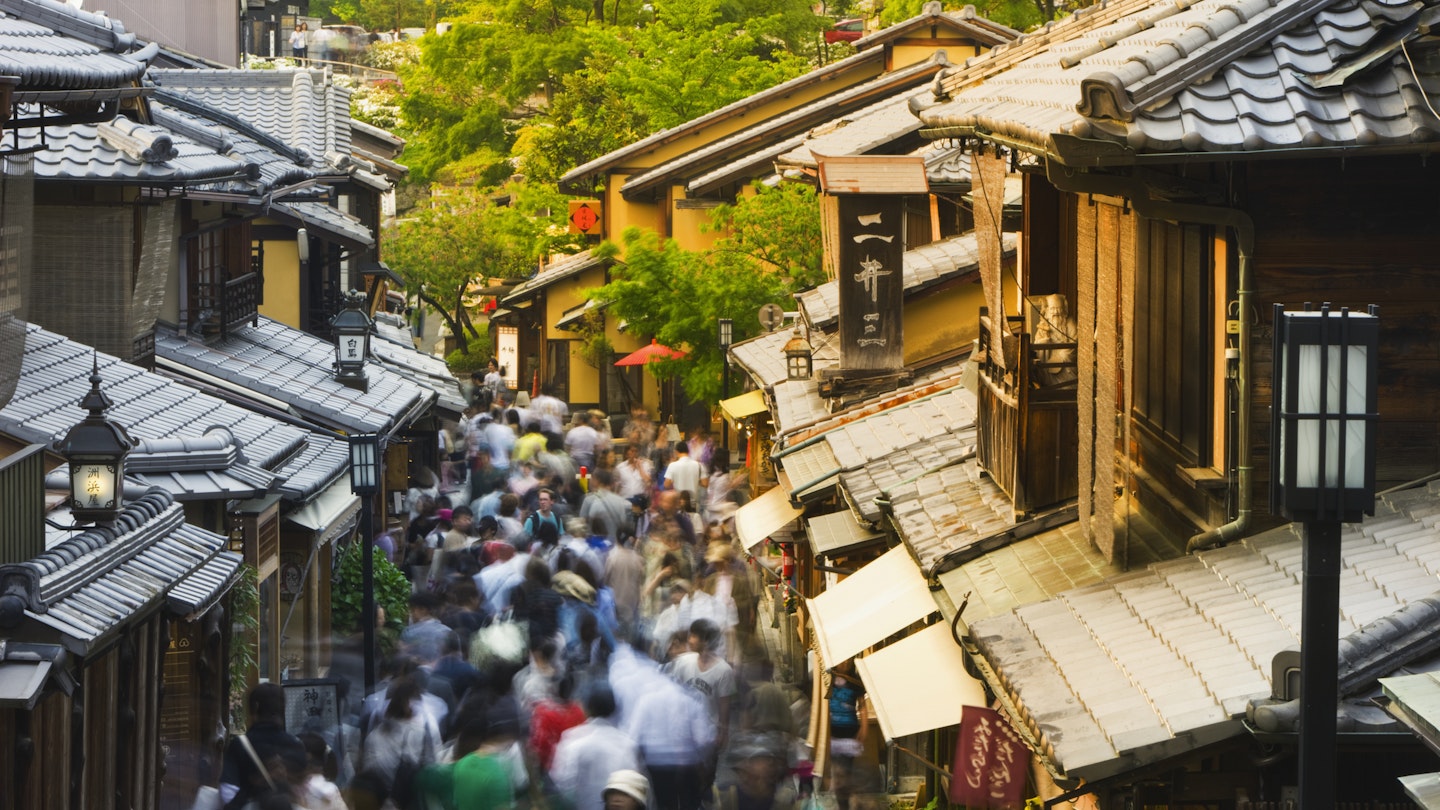
From restricted capacity to increased tourist taxes, options are being considered to counter overtourism in Japan © Jon Hicks / Getty Images
Japan is set to limit visitors at some popular attractions so that sites don't suffer from overtourism. Here's what you need to know.
Japan’s enduring popularity for overseas visitors is bringing consequences as the country seeks to balance the benefits of tourism and the impact on the areas visited, particularly at iconic destinations .
Recently, tourists have been banned from certain private streets in Kyoto ’s famous historic Gion district , traditionally home to the teahouses where geisha (geiko) and maiko (apprentice geiko ) performers work, largely due to antisocial behaviour. Unruly tourists have even been blamed for harassing geisha, with the Japan Times reporting that one had her kimono torn and another had a cigarette butt put in her collar.
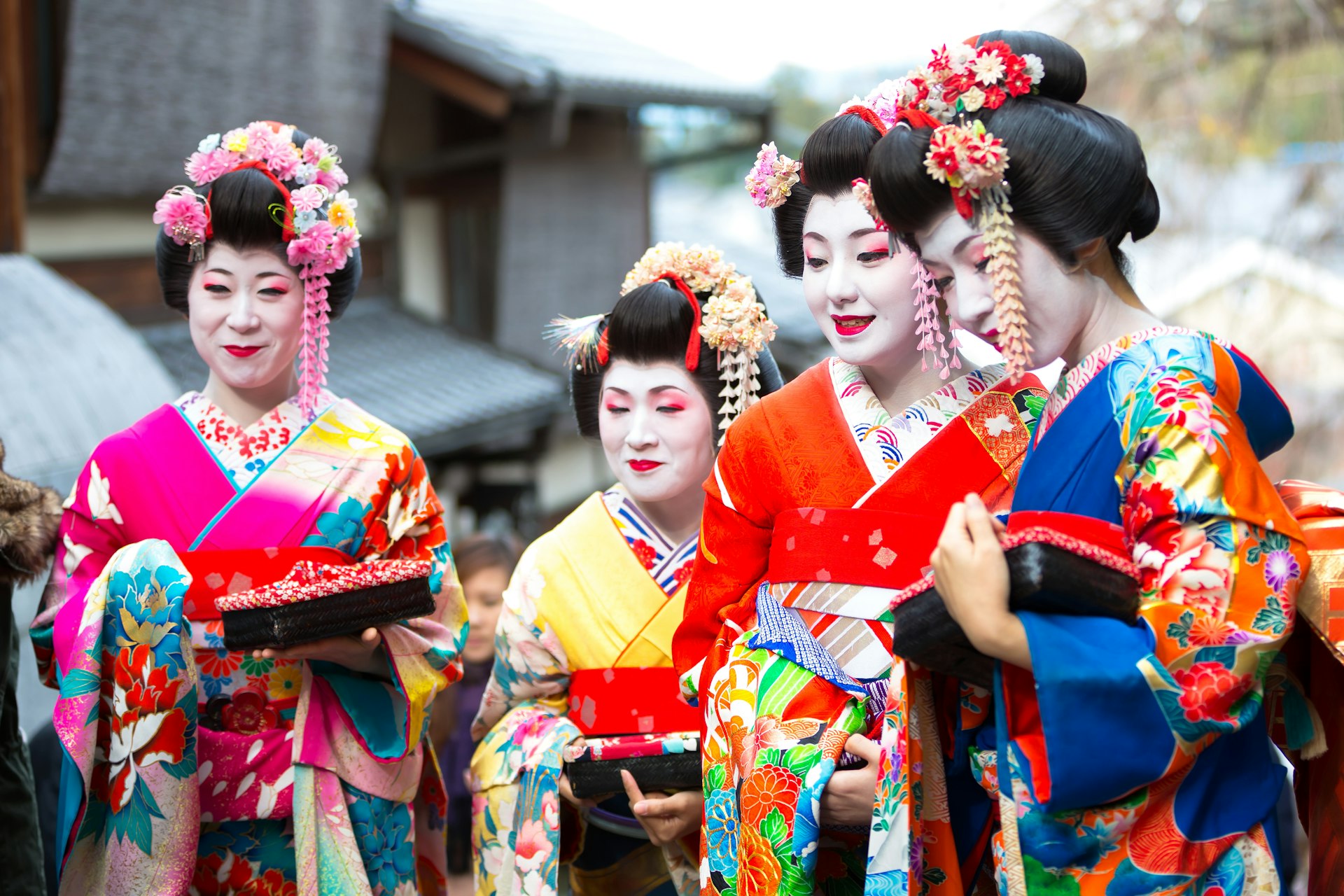
What new policies are being considered?
New fees and restrictions have already been introduced on climbing specific trails up Mt Fuji , in order to combat overcrowding, reduce the environmental impact — including cleaning up all the trash that results from so many people on the mountain — and improve safety for everyone doing the climb.
Kyoto is considering special tourist express bus routes, that will whisk visitors to the city’s most iconic sites in order to reduce overcrowding and improve efficiency on regular local buses, as well as to make what can be a complicated system easier for travelers.
Higher pricing for tourists is also being considered, having largely been absent in Japan, where many of the most famous cultural attractions are surprisingly inexpensive to enter. For example, Kyoto's famous golden temple Kinkaku-ji costs ¥400 for adults, which is about US$2.50. Changing this would be controversial, and it seems more likely that there would be increases in tourist taxes in order to fund services for visitors.
What are tourist taxes used for?
Local tourist taxes, usually collected as an extra on top of payment for your hotel, are common across many parts of the world, although these are relatively low in Japan compared with, say, destinations in the US like Honolulu and San Francisco.
These aim to fund some of the local costs associated with visitors: Kyoto’s is on a sliding scale based on the price of your hotel room, from ¥200–1000 a night (about US$1–7). The city of Hatsukaichi, home to the UNESCO-listed Itsukushima-jinja , often known as Miyajima and famous for its torii gate standing in the water off the island, recently implemented a ¥100 (about US$0.60) fee to fund the preservation and management of the site.
Japan already has a ¥1000 (about US$7) tourist departure tax that you may have never noticed as part of your plane fare.
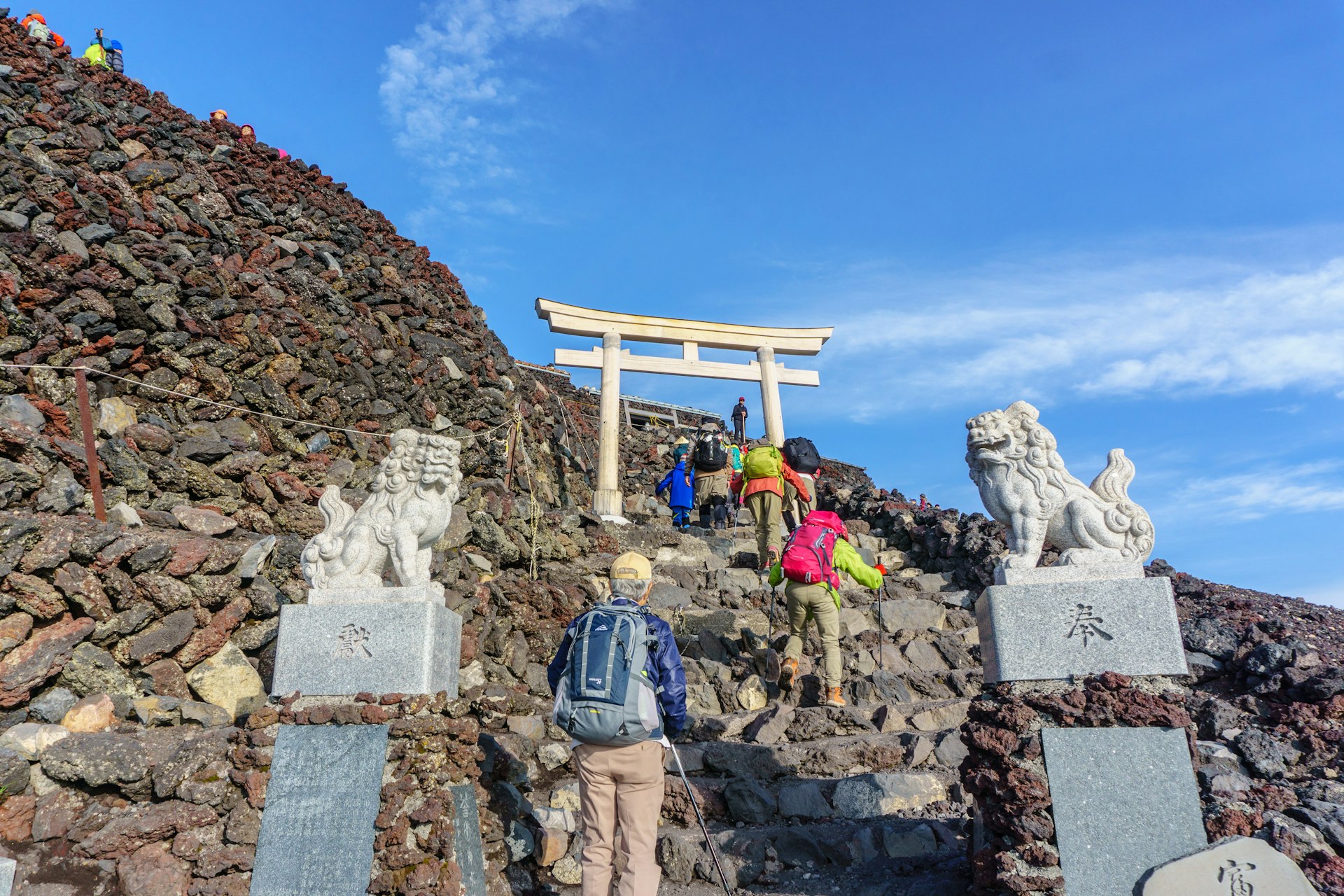
How is Japan likely to manage the problems of overtourism?
It seems unlikely that Japan will curtail its overall number of visitors because of overtourism. More likely, we’ll see more examples of capacity restrictions in specific places, like on Mt Fuji, where a certain number of people per day are allowed in.
This already happens in some cases in Japan: the famous Ghibli Museum in Tokyo and the new Ghibli Park in Nagoya both have a ticket maximum to maintain the quality of experience and to avoid overcrowding — the price for the former is just ¥1000 or about US$6.50, so it really is about capacity.
Some trains — specifically the fastest Nozomi and Mizuho Shinkansen between points west of Tokyo — are not included as part of the Japan Rail Pass , even though the slightly slower trains like the Hikari are. There’s only a few minutes' difference in terms of travel time, but at peak times there can be a half-dozen of the faster trains for every one of the slower ones. This is done for a variety of reasons, including that the clockwork-like efficiency of the shinkansen’s busiest section leaves only the briefest times for passengers to get on and off the train, and confused tourists (often carting large luggage with them) have been known to disrupt operations. Overseas visitors are therefore concentrated into the slightly slower Hikari and much slower Kodama services instead.
A more recent change is the 2020 introduction of the “Baggage 160” system , where travelers must reserve a space for larger pieces of luggage (over 160cm/63in in combined height, width and depth) on more popular bullet train lines or pay a carry-on fee. The change largely stemmed from the complications of visitors bringing large pieces of luggage onto trains that were not designed with large luggage storage. Japanese travelers tend not to bring large suitcases with them on trains, instead shipping them ahead to their destination via the excellent and inexpensive set of luggage delivery services like Yamato Transport , known as kuroneko (black cat) after its ubiquitous logo of a black cat carrying a kitten in its mouth.

How will this impact on group tours?
Keep an eye out for capacity management caps or even outright bans to potentially affect group tours first. These can be very unpopular with local people, and indeed with other visitors.
A tour bus full of visitors descending all at once can change the character of a place instantly, and that’s certainly the case in a lot of the most famous Kyoto temples and shrines like Kinkaju-ji, Ryōan-ji or Kiyomizu-dera . These groups often have a reputation for behaving disrespectfully, like talking loudly in places where quiet is expected, not following rules, and getting in the way of local people and more respectful travelers.
You’re unlikely to be affected as an independent traveler, and a smart tactic is to visit at times when these groups are either still making their way from their hotels, have been packed off for lunch, or are heading back at the end of the day — and to plan to explore the less-traveled corners of this fascinating country.
Explore related stories
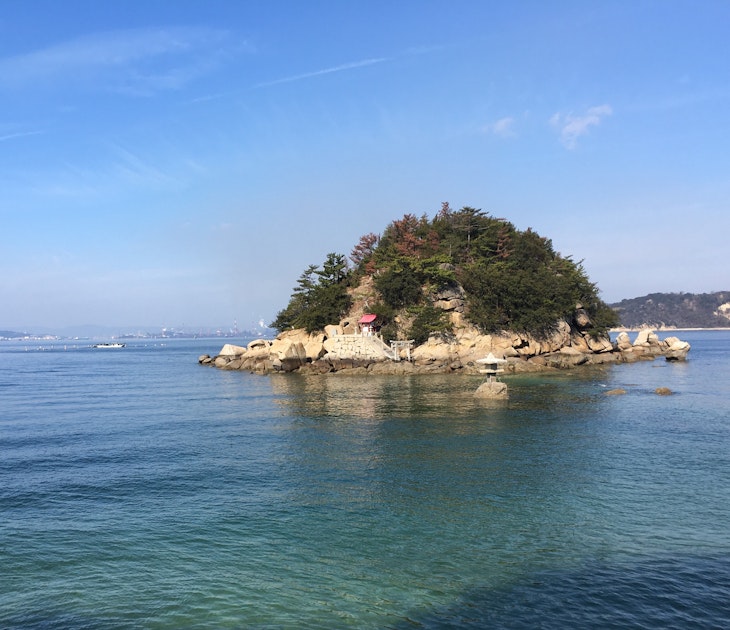
Mar 4, 2020 • 5 min read
Step away from Japan's big cities and sample some slow travel in and around the Seto Inland Sea.
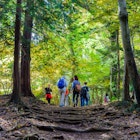
Feb 5, 2020 • 4 min read

Apr 2, 2024 • 10 min read

Mar 28, 2024 • 7 min read

Mar 21, 2024 • 9 min read

Feb 21, 2024 • 7 min read

Feb 11, 2024 • 11 min read
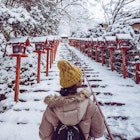
Jan 18, 2024 • 8 min read
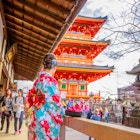
Dec 10, 2023 • 6 min read

Mar 7, 2023 • 7 min read

IMAGES
VIDEO
COMMENTS
The DMZ. The 4km-wide, 240km-long buffer known as the Demilitarized Zone (DMZ) slashes across the peninsula, separating North and South Korea. Lined on both sides by tank traps, electric fences, landmines and armies in full battle readiness, it's a sinister place where the tension is palpable. Surreally, it's also a major tourist attraction ...
The most comfortable way to visit the DMZ is with an organized DMZ tour from Seoul. We recommend using GetYourGuide to book your DMZ tour in Korea. One of the advantages of GetYourGuide is that most tours have a flexible cancellation policy. Normally you can cancel up to 24hours before the tour to get a full refund.
The DMZ is a four-kilometer-wide strip of land that runs across the Korean Peninsula. It is located about 60 kilometers north of Seoul, South Korea. The DMZ Tour is a great way to learn about Korean history and the current situation on the Korean Peninsula. It's also worth noting that this region protects precious natural and historical sites ...
DMZ Tour South Korea. In South Korea, my visit to the DMZ was a day tour with VIP Travel, considered to be the best DMZ/JSR tour agency in Seoul. The full-day 'DMZ and Panmunjeom Tour' (from 8 am until 5 pm) runs every day (except on Sundays, Mondays, National Holidays, and Military Training Days) and costs 135,000 Korean Won / around $120 ...
One of the most popular one-day tours from Seoul is to tour the DMZ, the Demilitarized Zone which is the 240km / 150 mi long border along the 38th parallel between North and South Korea. After recently visiting the DMZ ourselves, in our experience, we can definitely recommend that you plan to visit the DMZ when you visit South Korea, as it is ...
Conculusion. The one-day DMZ Tour is a full package to help you know more about the history of the country, the war, and its repercussions that are felt by its citizens in both nations to this day. It was a war that broke a country into two with people dead and traumatized on both sides. However, since 2018 things are changing and many aspects ...
7. DMZ Souvenir Shop. The last stop on our DMZ tour was a souvenir shop and it lasted for about 15 minutes. However, this wasn't a forced shopping experience and you could choose to stay on the bus. It was a good place to buy products such as wine, chocolate and ice cream which are produced only in the DMZ area.
A former resident of Beijing, Tom writes about travel in China, Japan, Korea, Hong Kong, Taiwan, and Mongolia. As well as writing guidebooks for Lonely Planet and other publishers, he also reports on travel and hotels for The Telegraph.Tom has the dubious honour of having visited the DMZ from both sides, most recently for the 2019 edition of the Korea Lonely Planet guidebook, and before that ...
Most tours from Seoul start with a bus journey to the Dora Observatory, a hilltop, camouflage-painted blockhouse with views across the DMZ into the North. Through binoculars you can see residents of Kijeong-dong (often called the 'Propaganda Village') working in the fields while children in white shirts and red neckerchiefs march off to school.
Gallery. S$ 51.09S$ 51.25. Select options. Klook's choice. Best Price Guarantee. All promotions. Learn more about the history of the Korean War and the Cold War on this educational guided DMZ tour. Places such as Imjingak Park, the Freedom Bridge, the Third Infiltration Tunnel, and the DMZ Exhibition Hall will be visited.
English-speaking DMZ tours from Seoul run as low as only ₩44,000, ... a Koridoor tour booked for early June 2019, but were considering this method instead based on what I read in the "Lonely Planet Seoul" guide book; this way seems like quite an experience! As we can't do a full DMZ tour these days, this appears to be a great ...
Sof music, deserted train platforms, infiltration tunnels - welcome to the Demilitarised Zone
DMZ tours from Seoul typically cover several key sites, each with its own story and significance: Imjingak Park: Often the first stop, this park is home to various monuments and relics from the Korean War, including the Freedom Bridge and an old steam locomotive riddled with bullet holes.; The 3rd Infiltration Tunnel: Discovered in 1978, this tunnel was dug by North Korea, supposedly to launch ...
No chances for JSA tour in foreseeable future. There are tours to DMZ including 3rd infiltration tunnel and observatory. I was on one with Koridoor last week, general service was good, unfortunately our guide was mediocre, we were given only basic facts, nothing that I didn't know after googling + lonely planet guide.
S$76.12. per adult. Private DMZ the 3rd Tunnel Tour from Seoul (No Forced Shopping) 217. Historical Tours. from. S$318.33. per adult (price varies by group size) DMZ Full Day Tour with Suspension Bridge or Imjin River Sailboat.
Half Day Guided DMZ tour from Seoul 2. Introduction to Seoul Tour 3. Korean Cooking Class ... ⇒ Lonely Planet South Korea. Frequently Asked Questions about Itineraries for Korea How many days is enough for South Korea? I would allow for at least one week in South Korea. Spend a minimum of 3 days in Seoul and then head down to Jeju Island or ...
Higher pricing for tourists is also being considered, having largely been absent in Japan, where many of the most famous cultural attractions are surprisingly inexpensive to enter. For example, Kyoto's famous golden temple Kinkaku-ji costs ¥400 for adults, which is about US$2.50. Changing this would be controversial, and it seems more likely ...